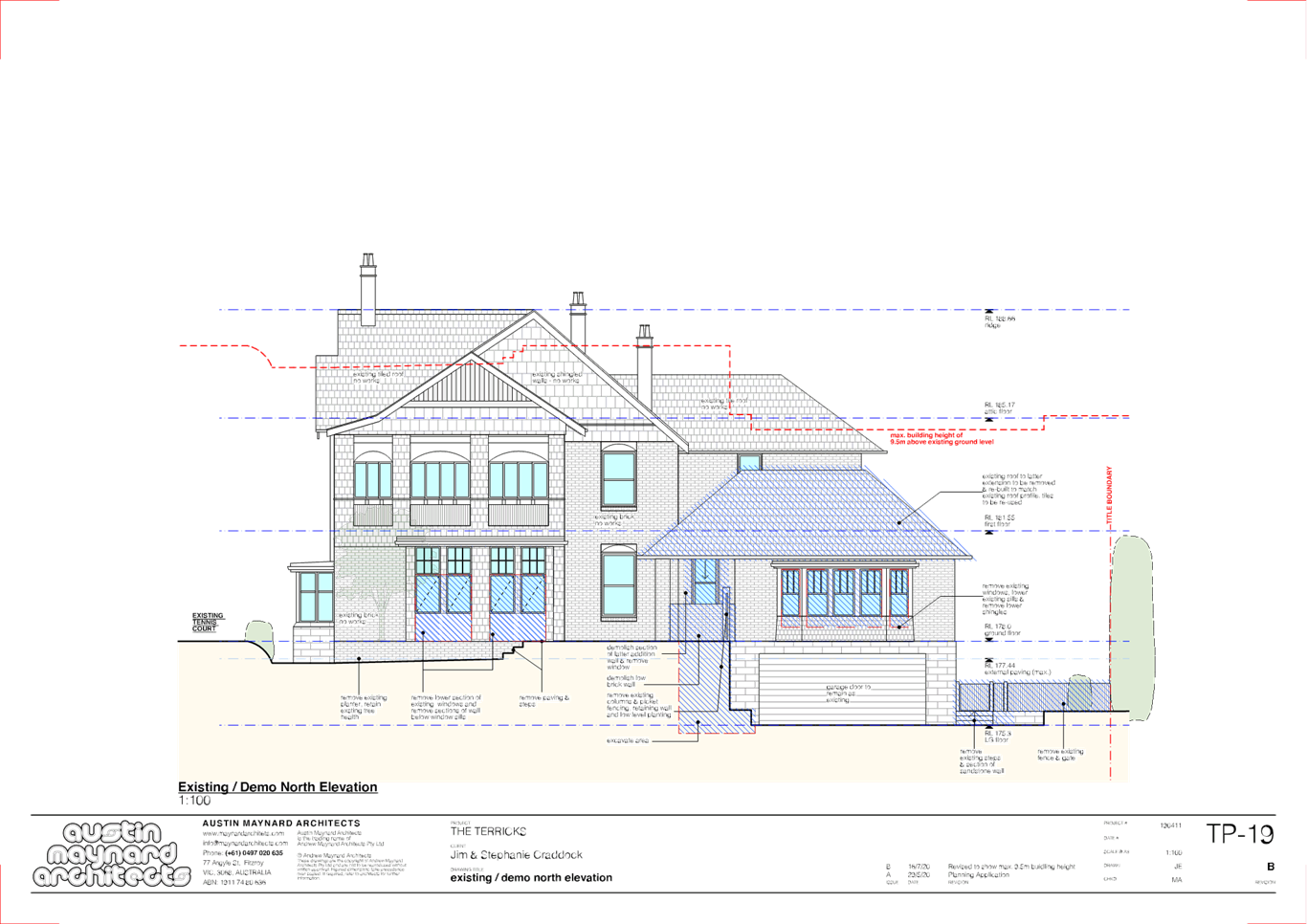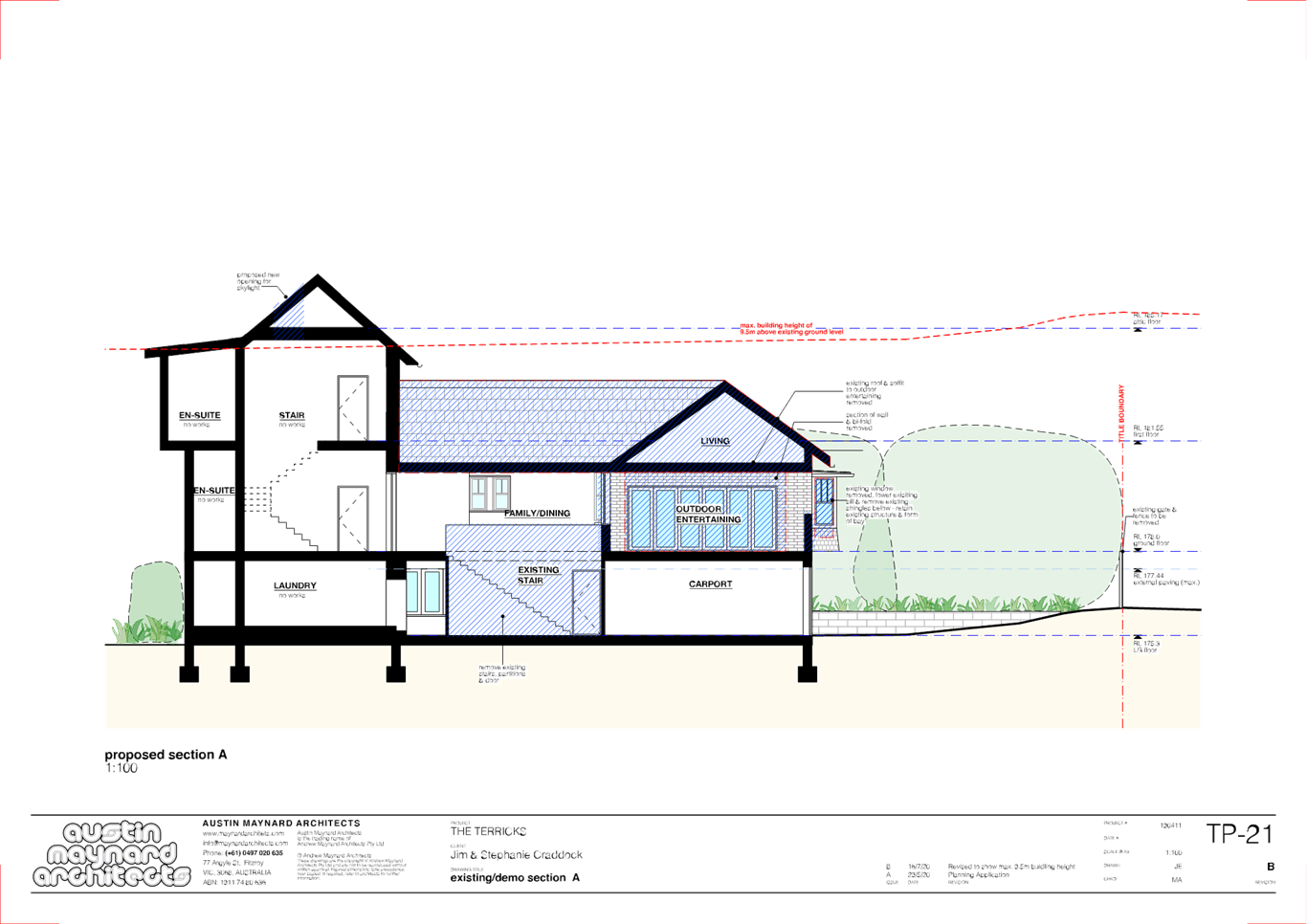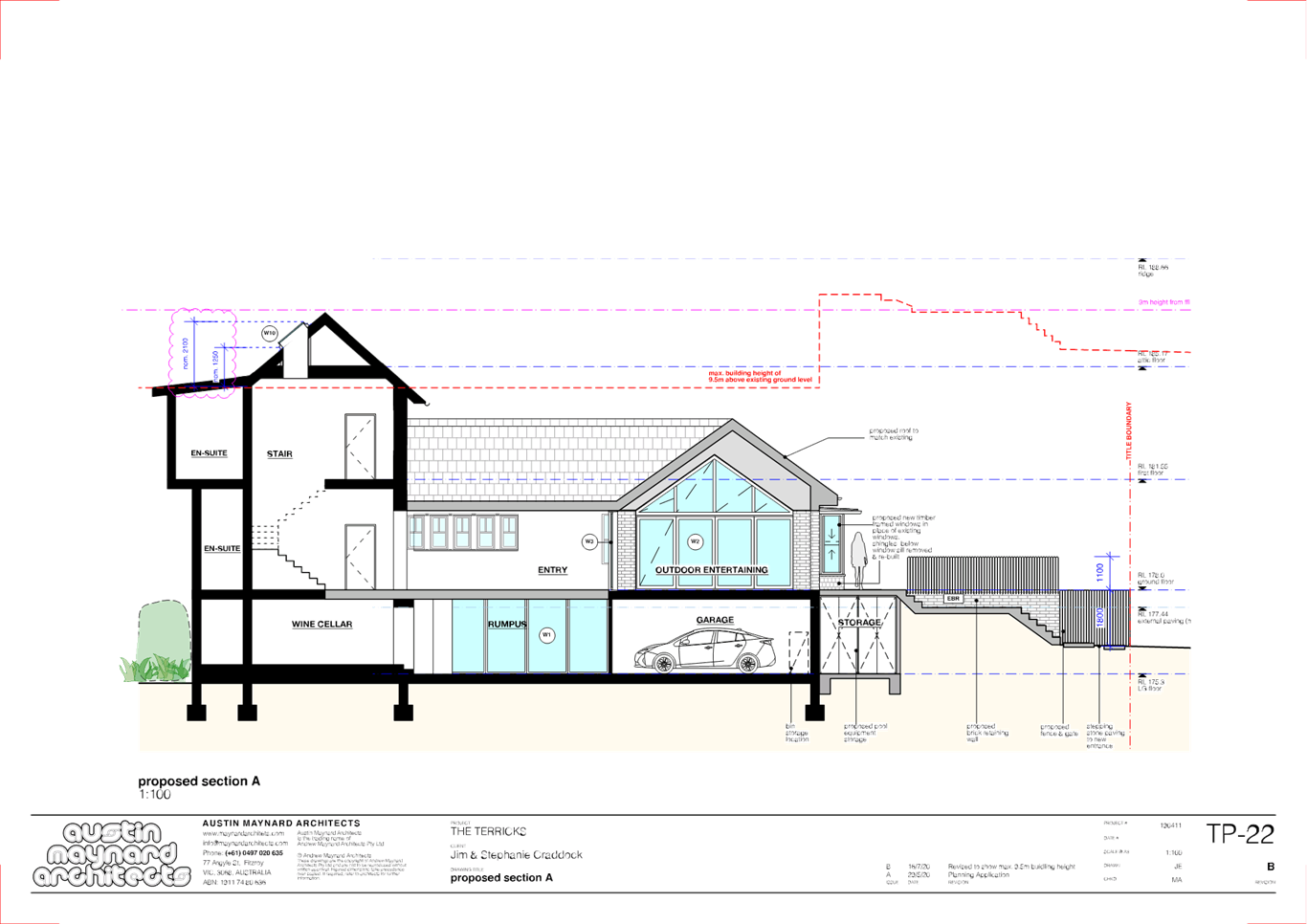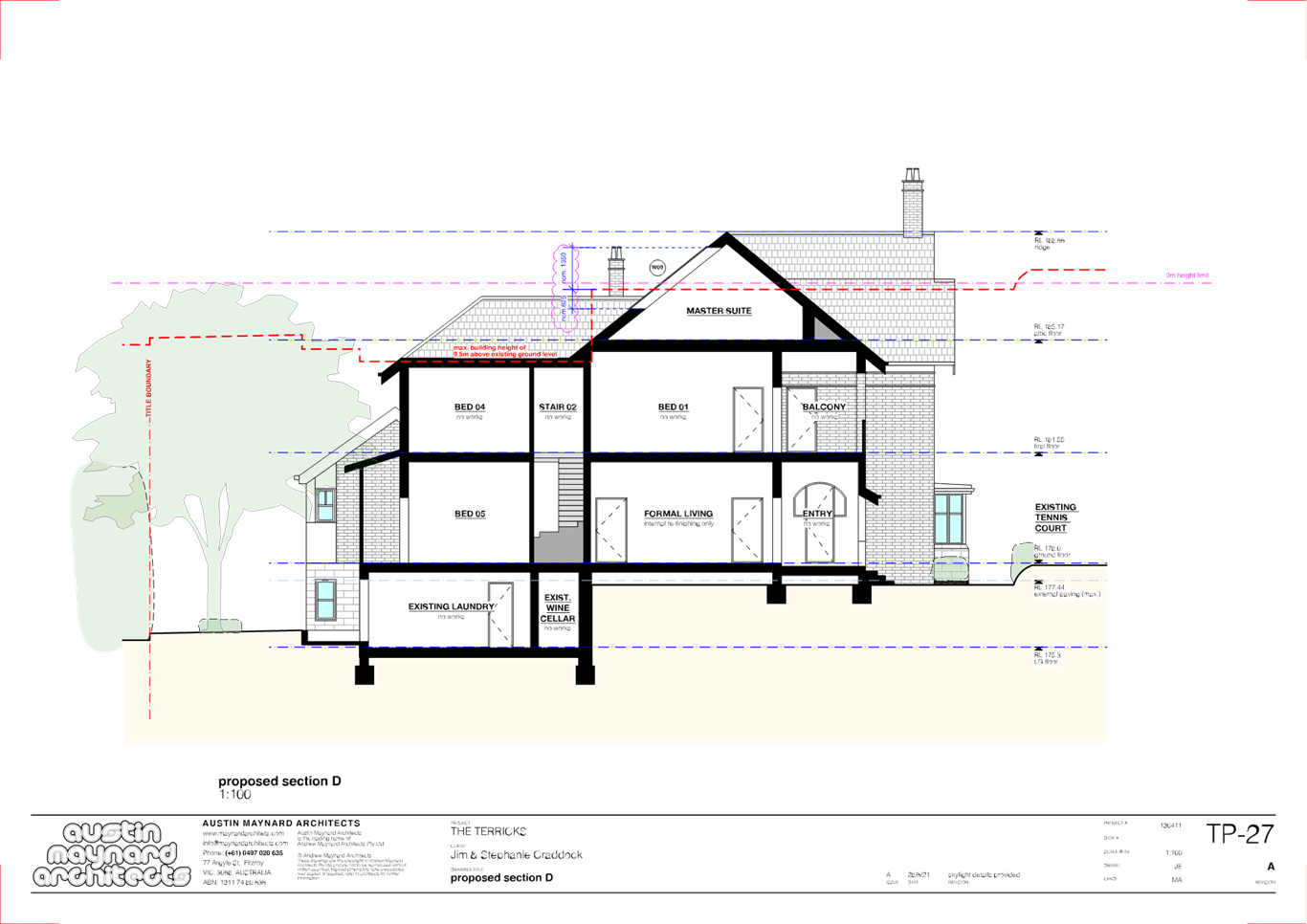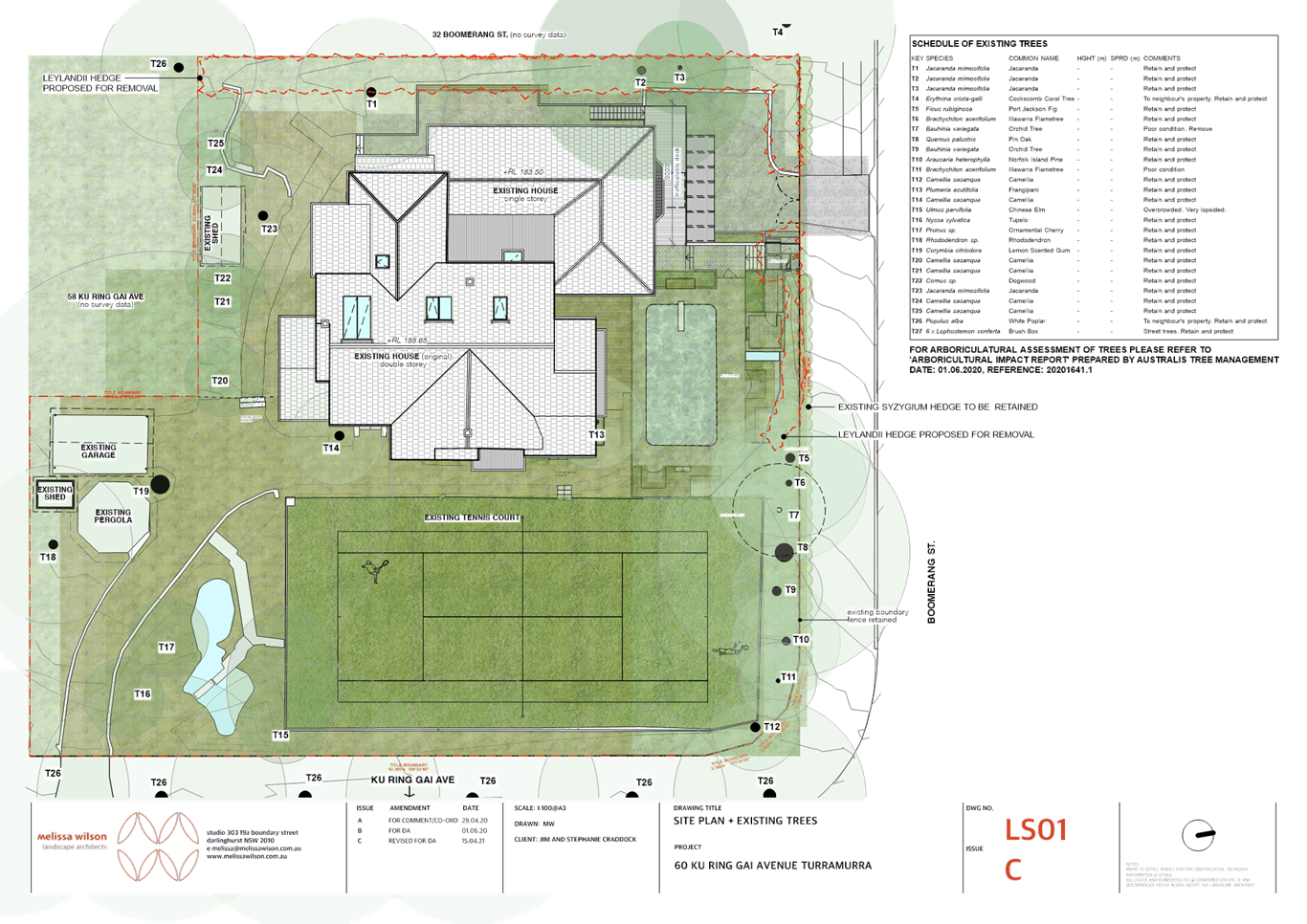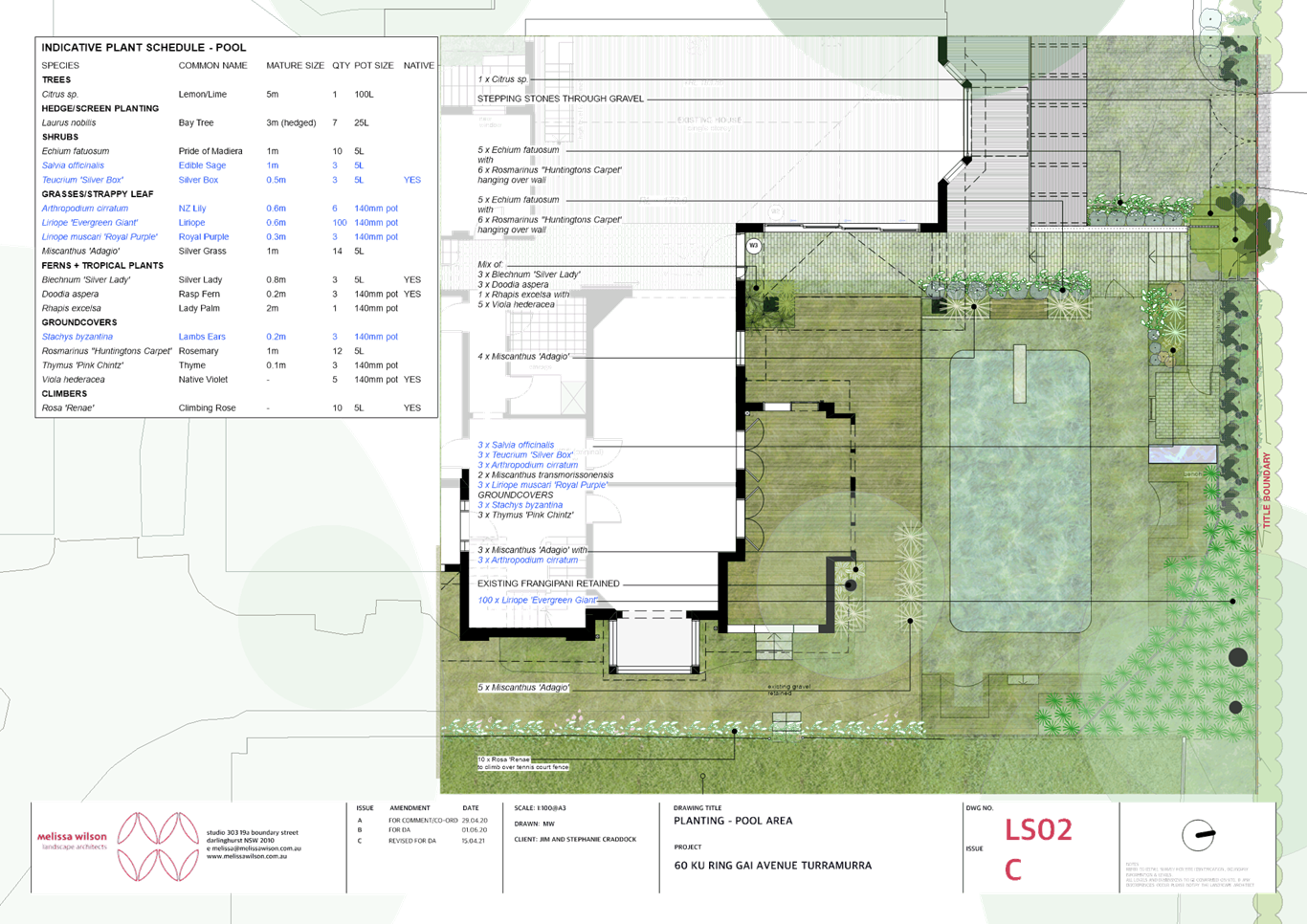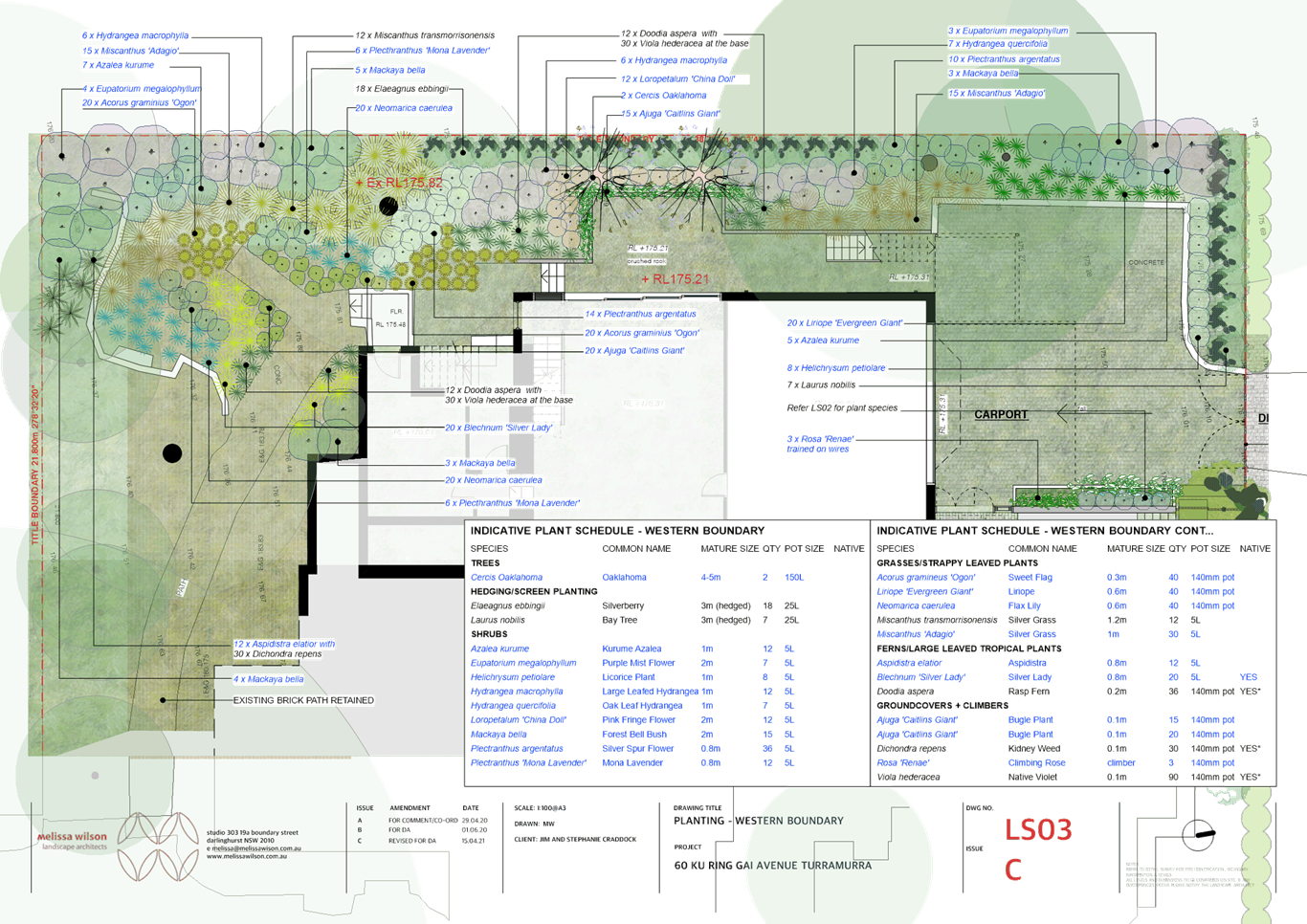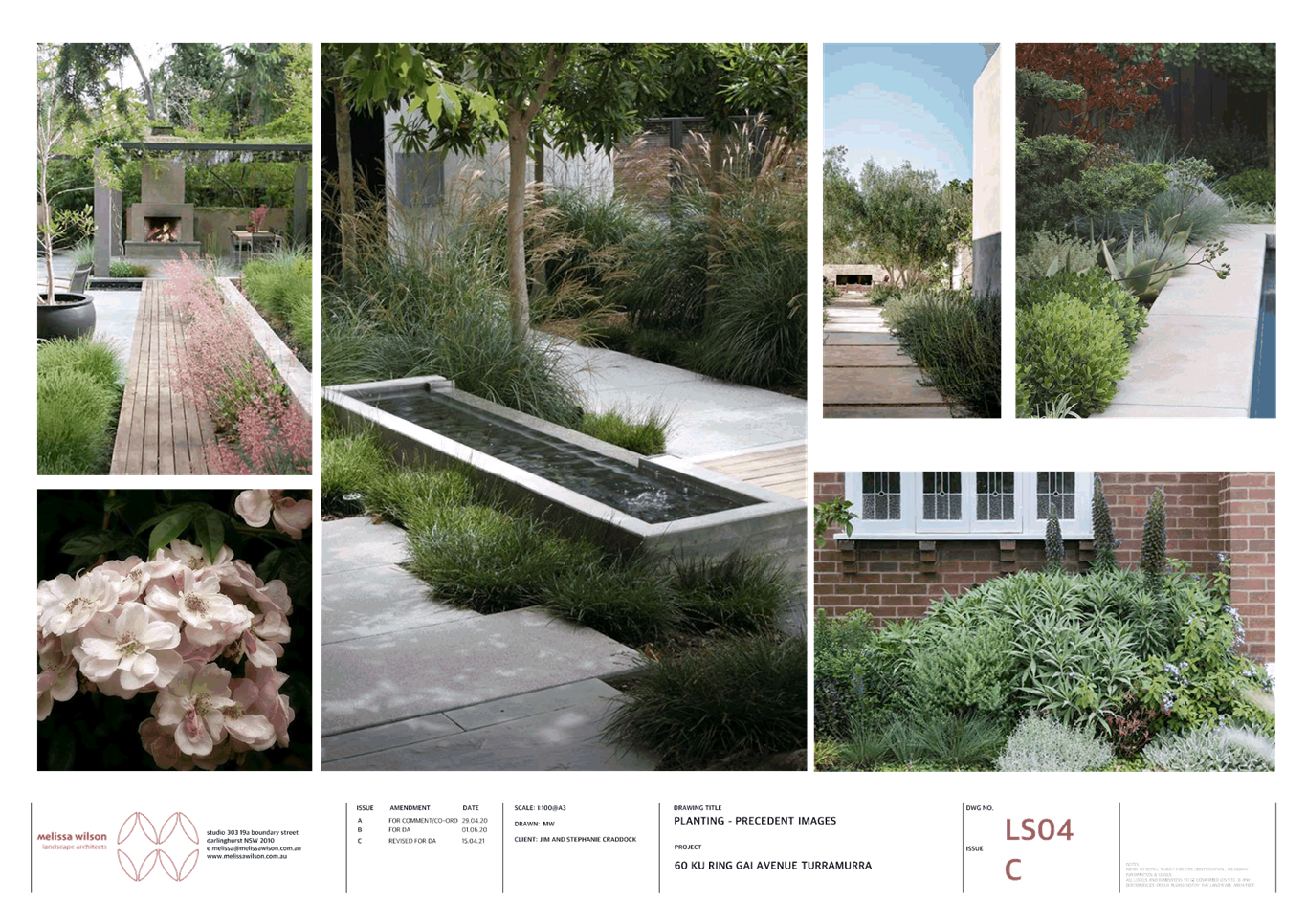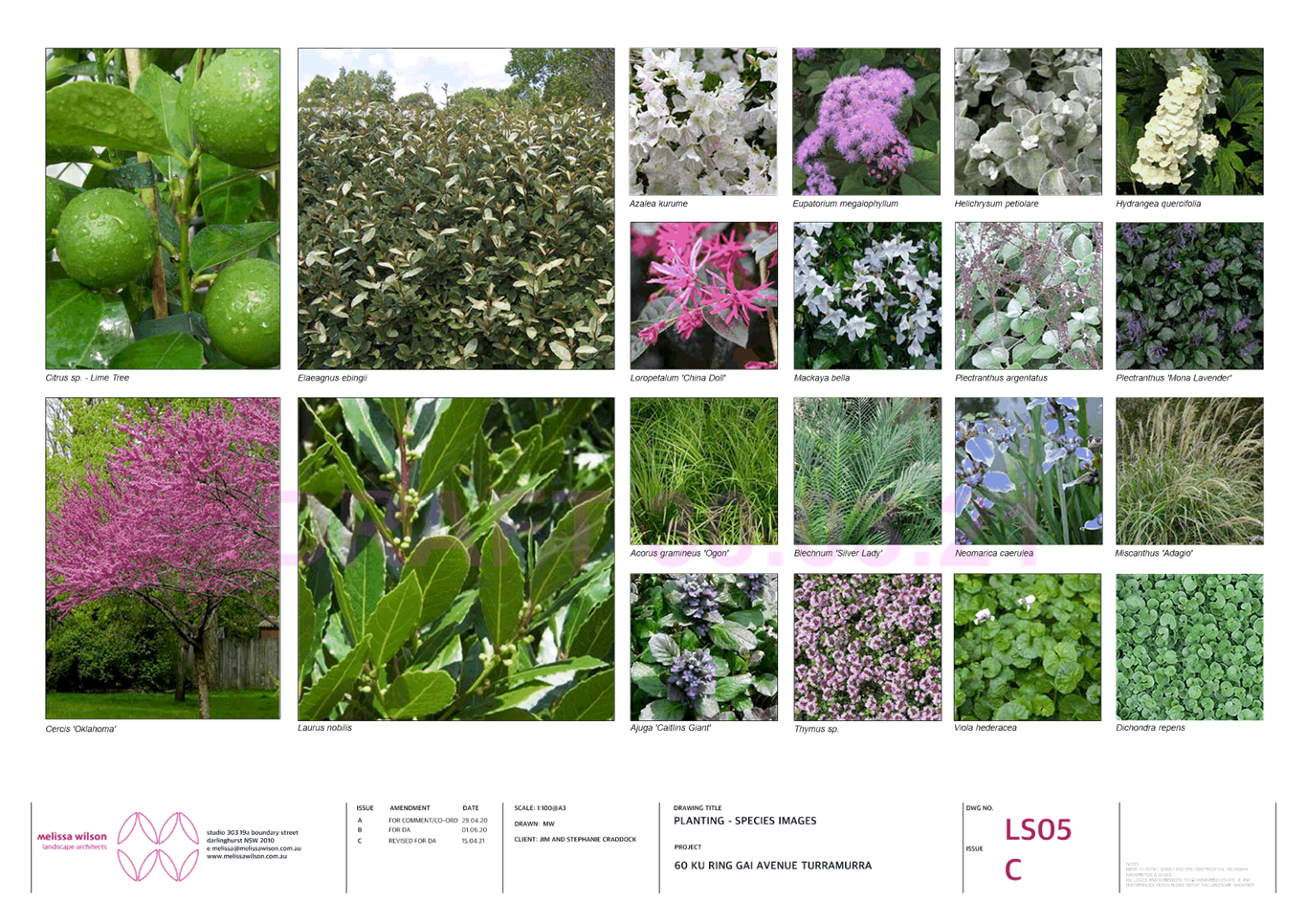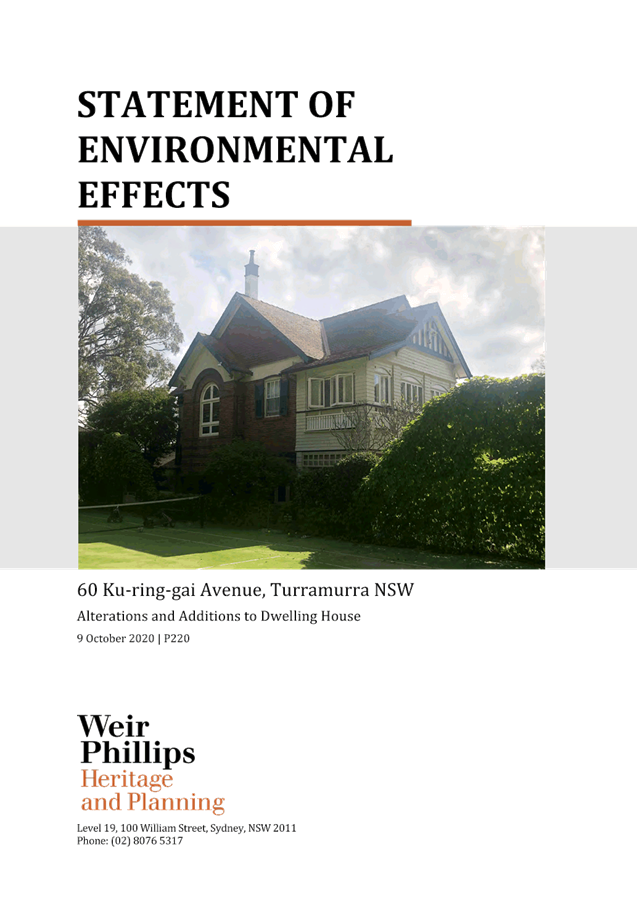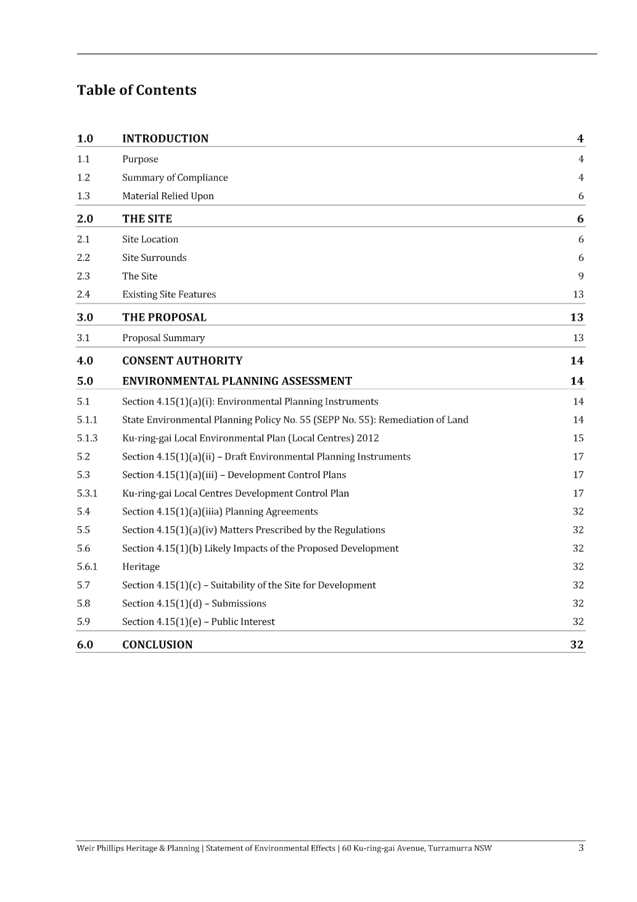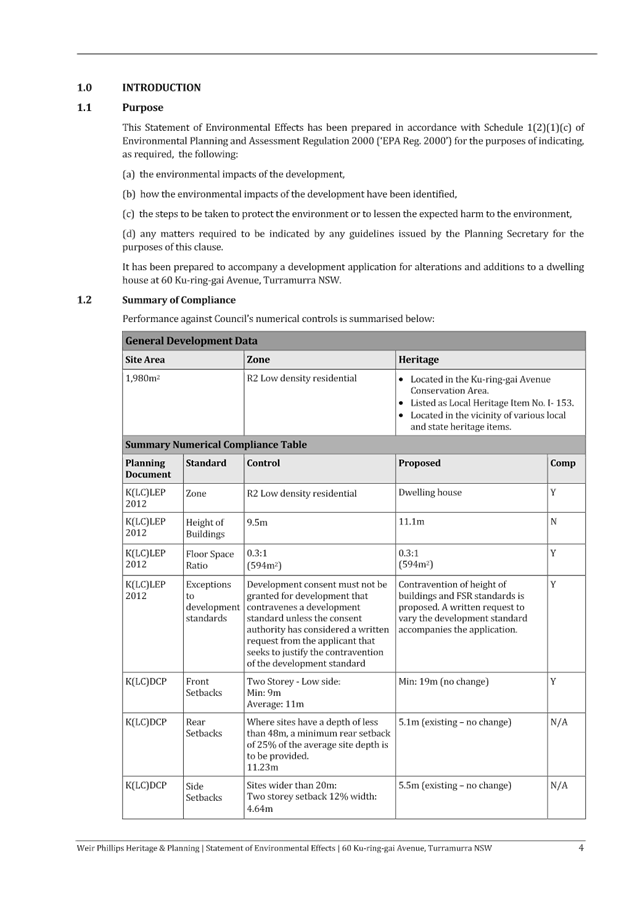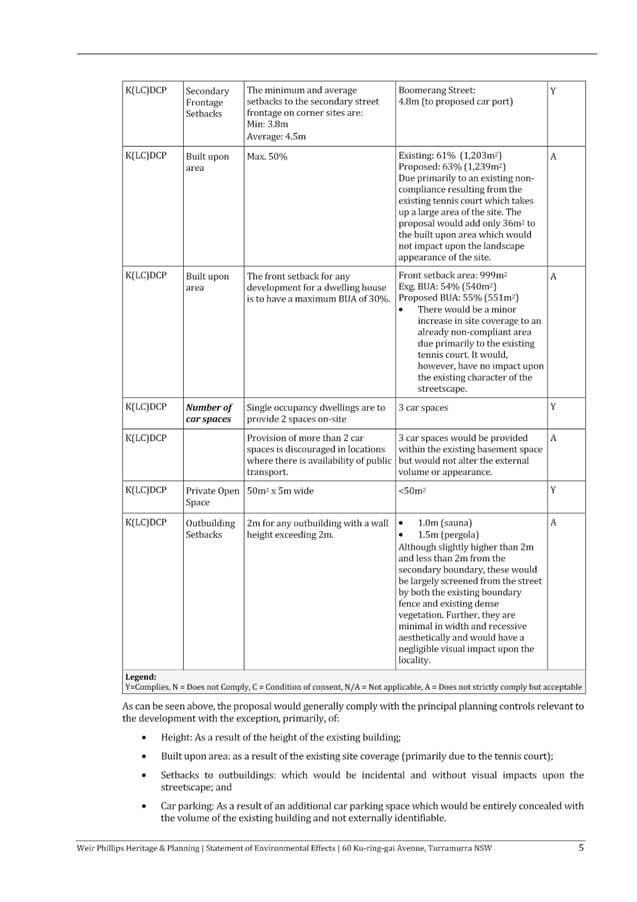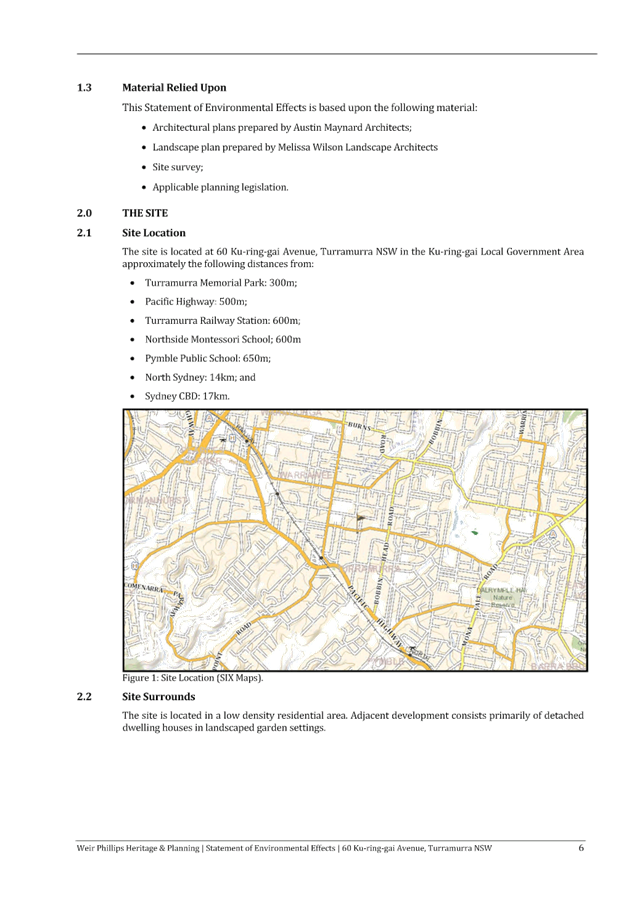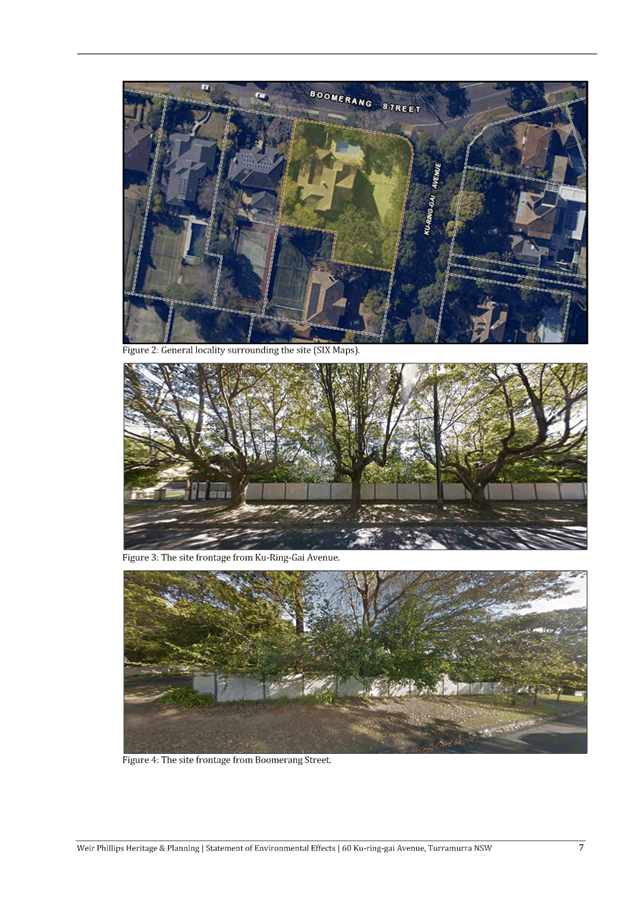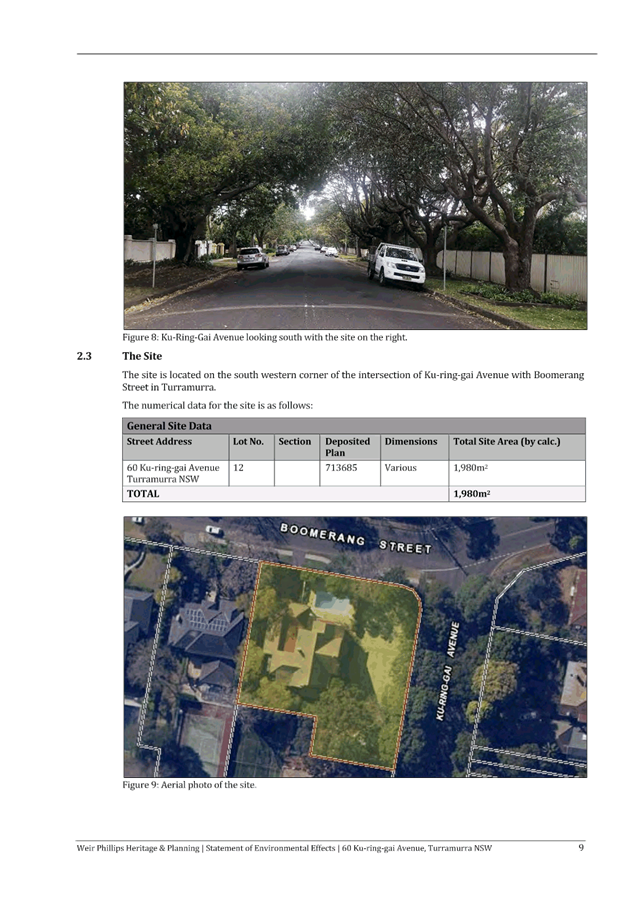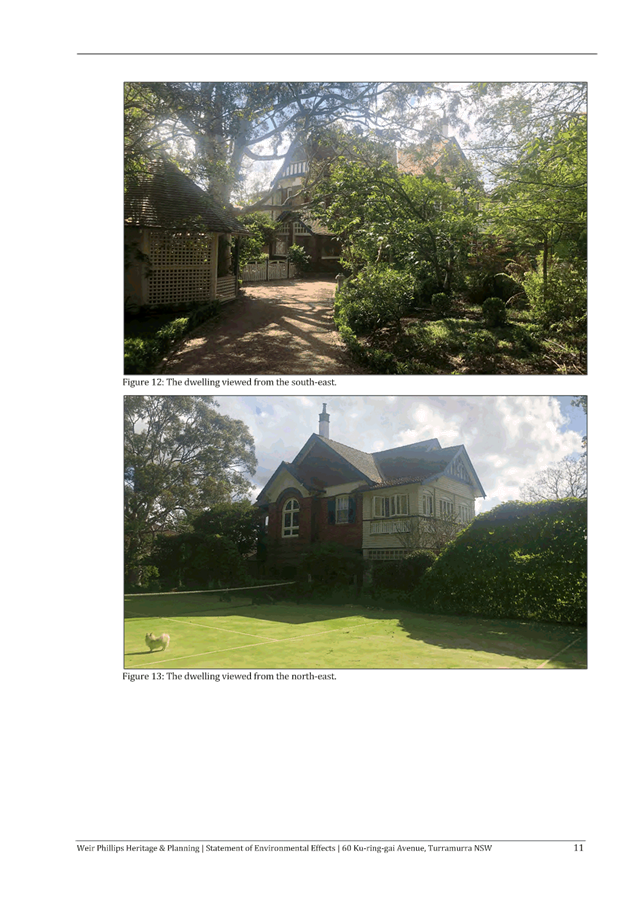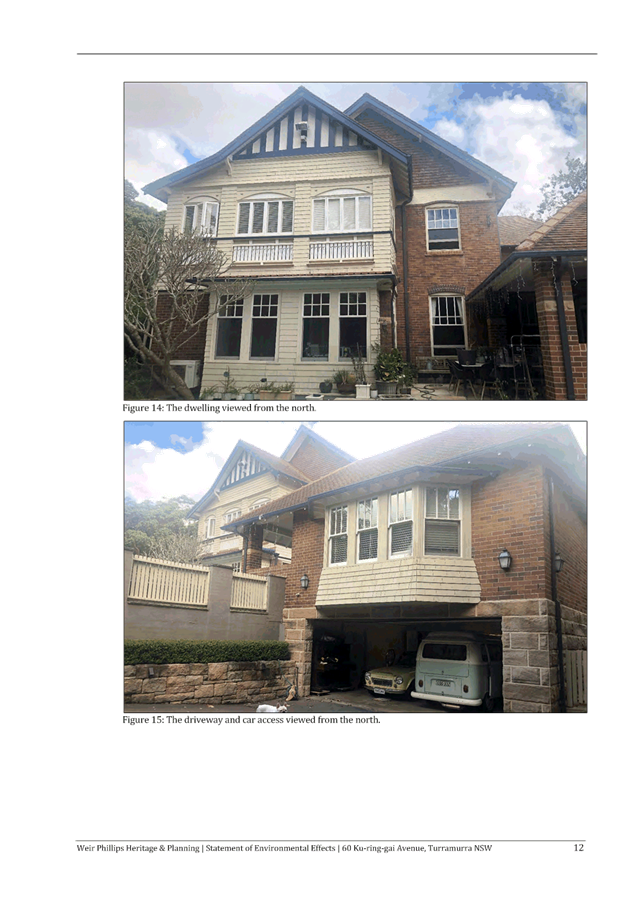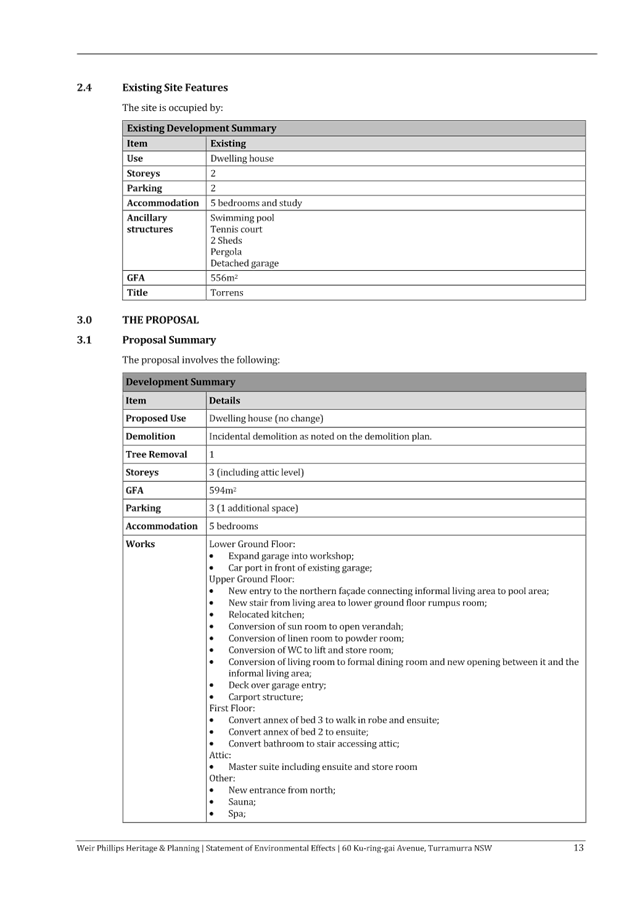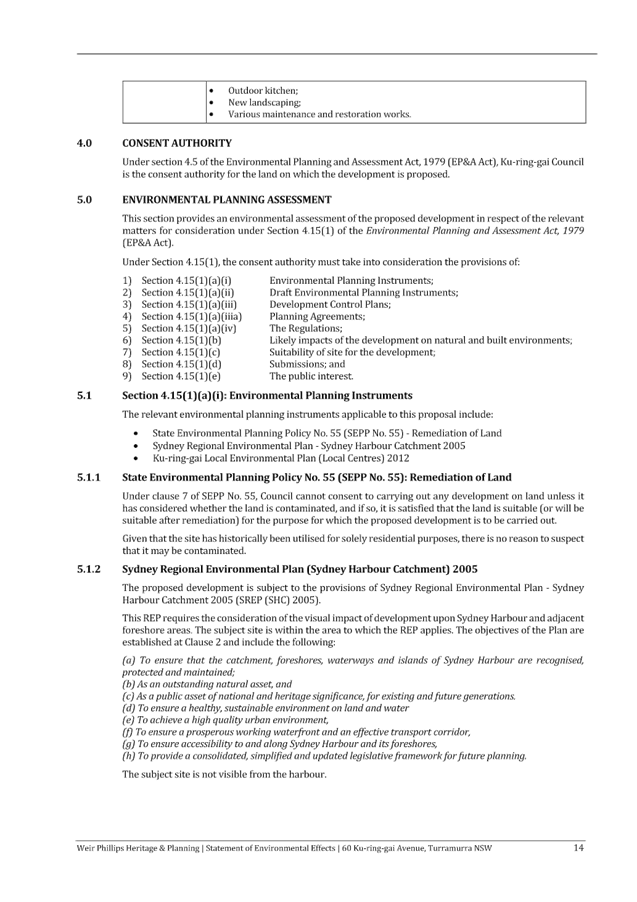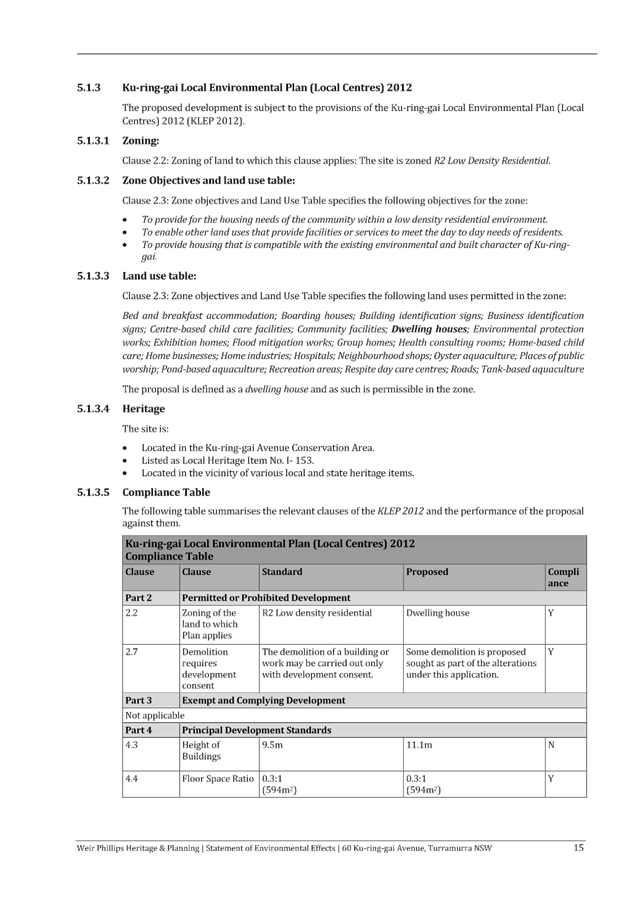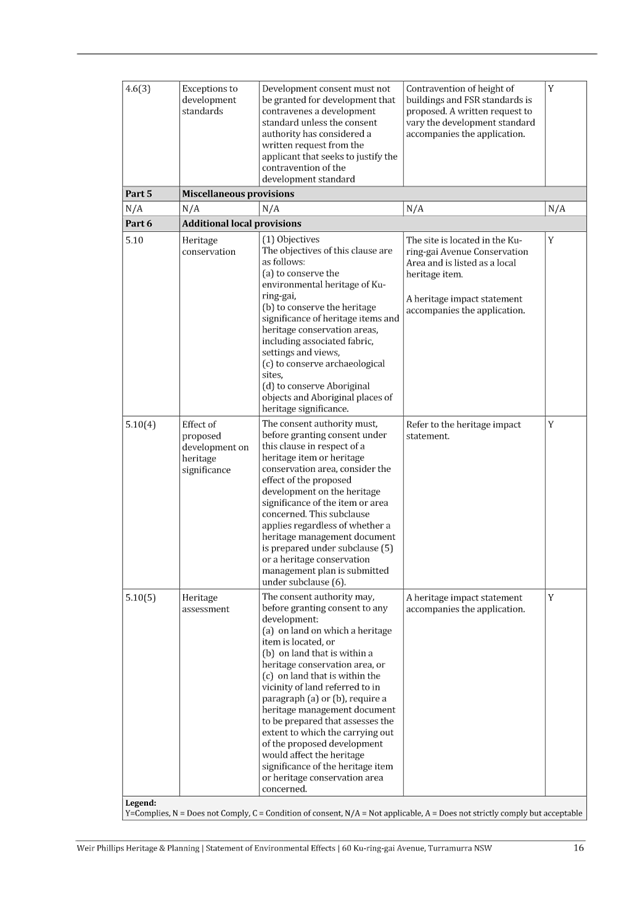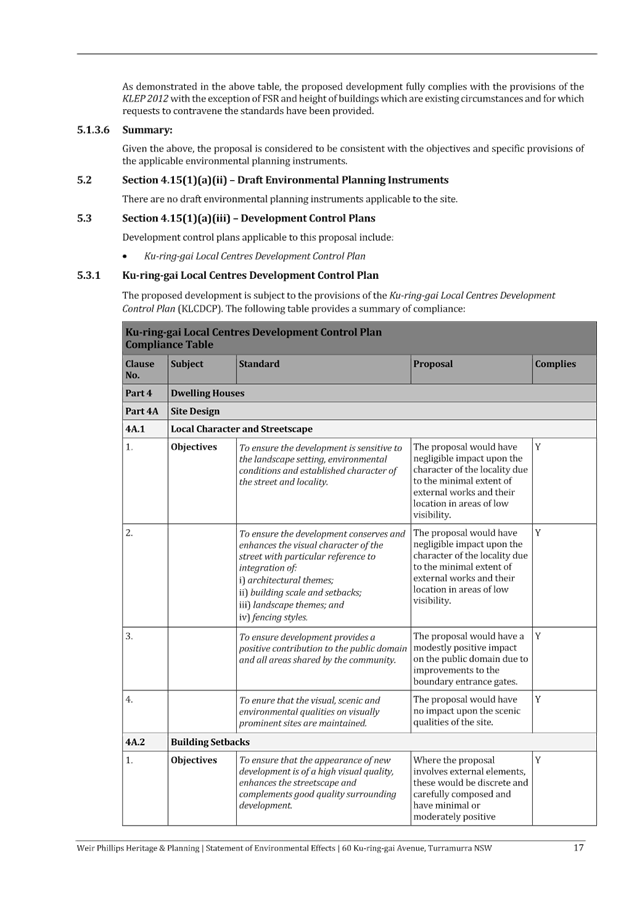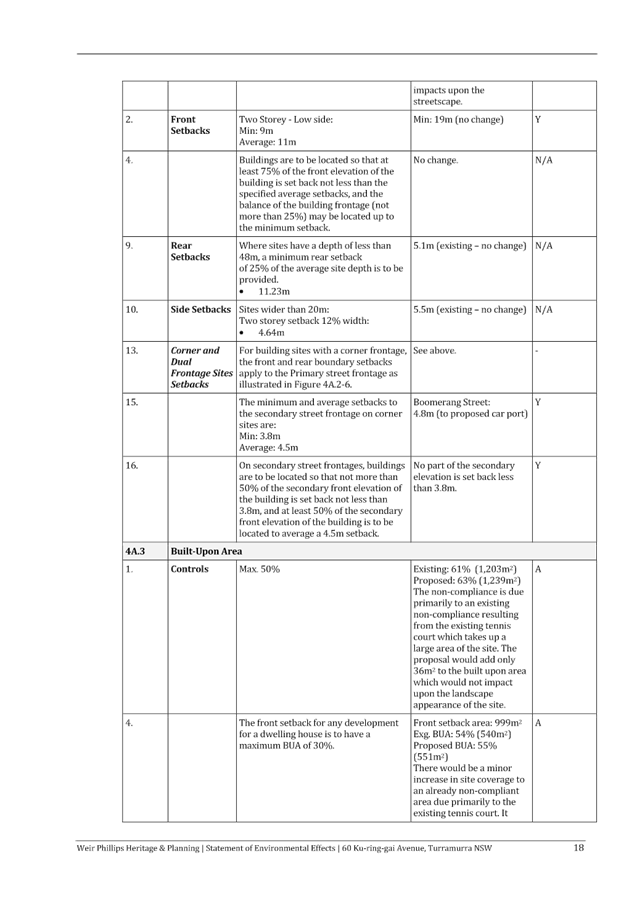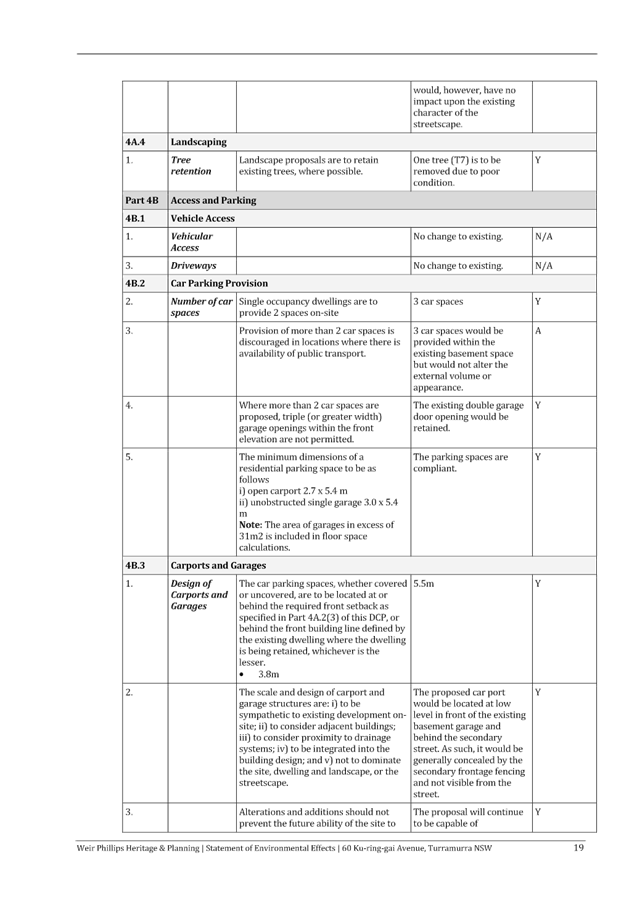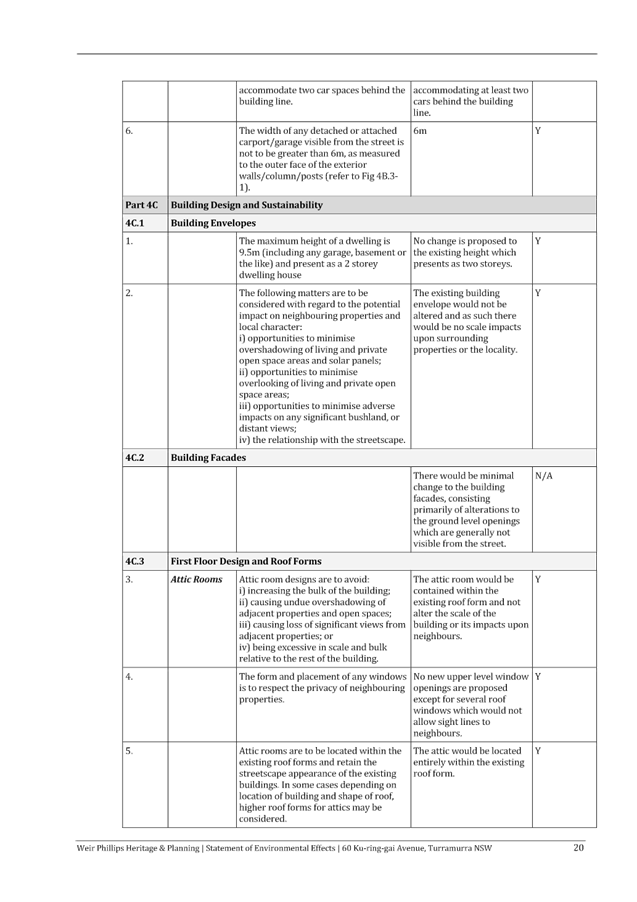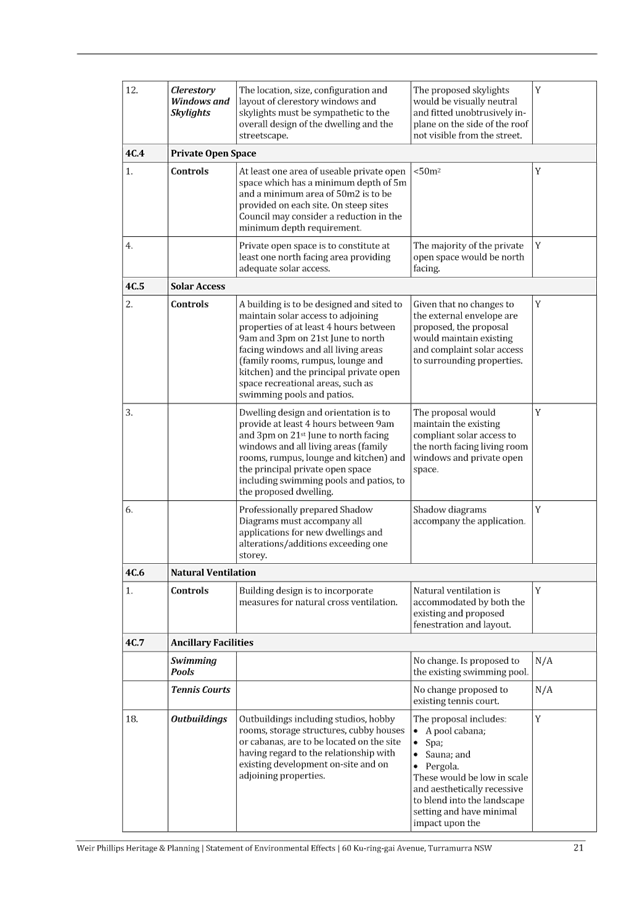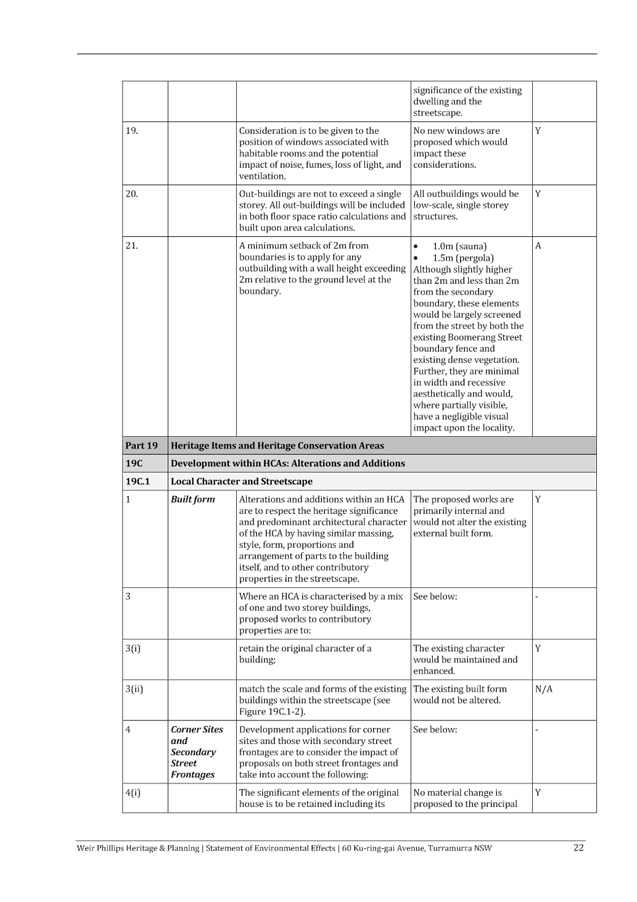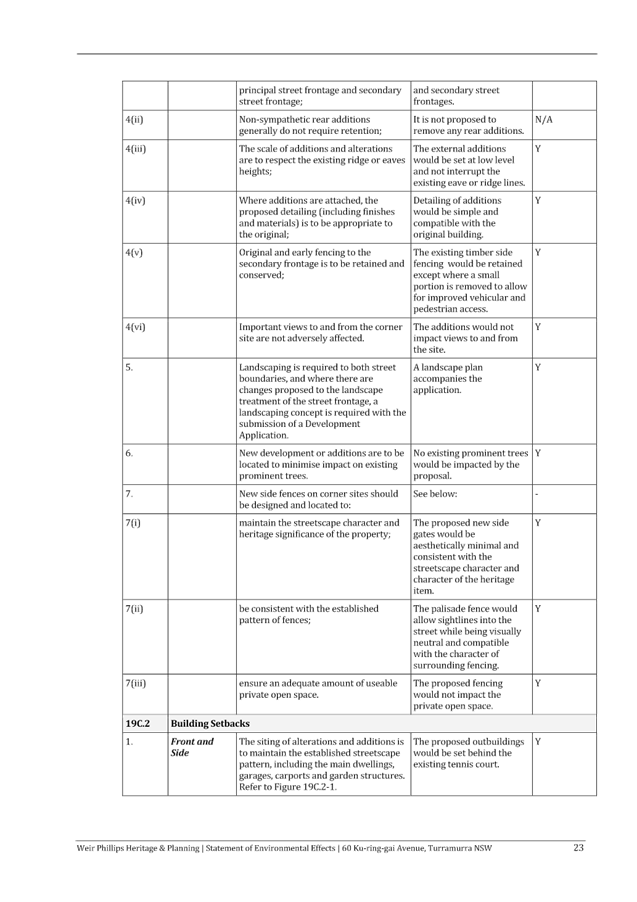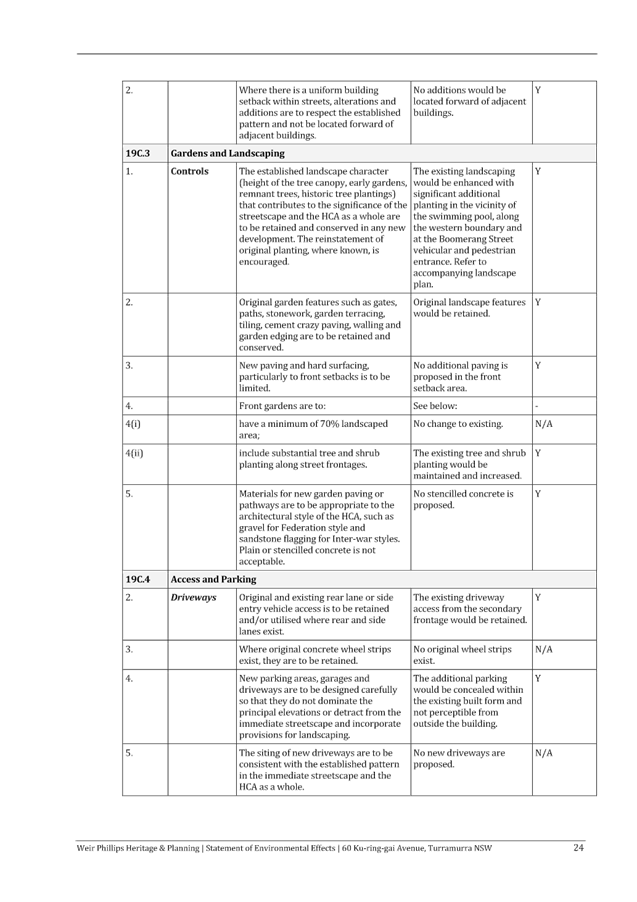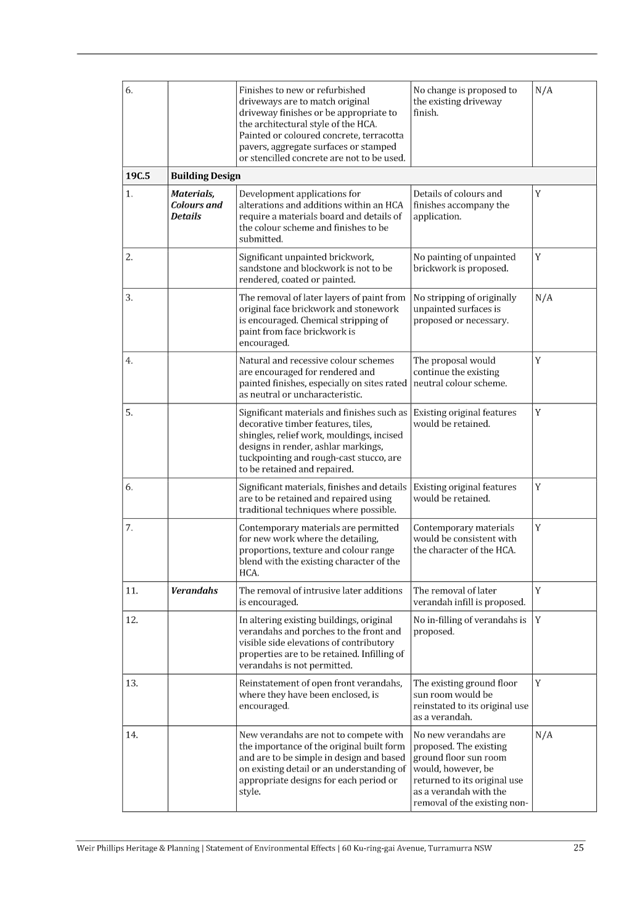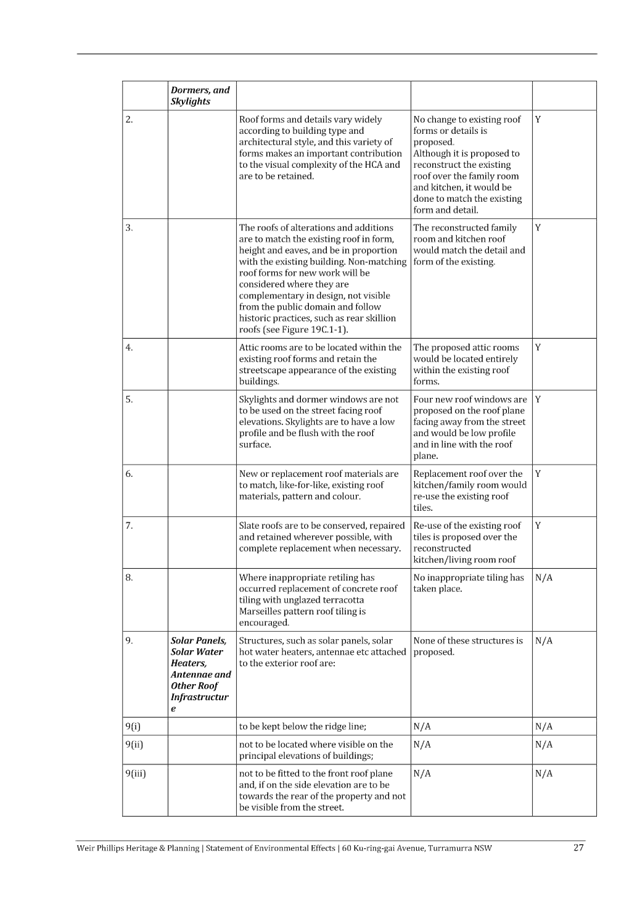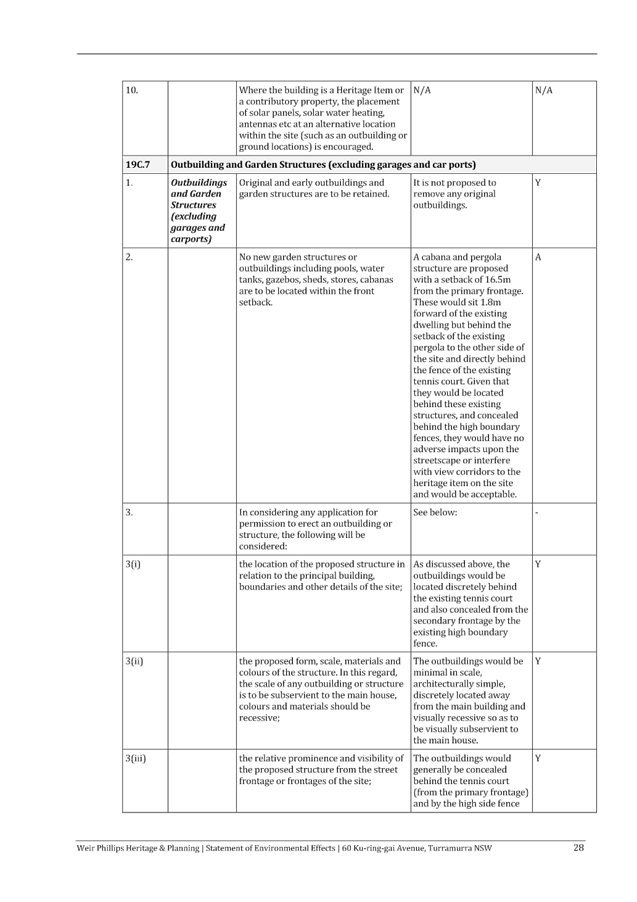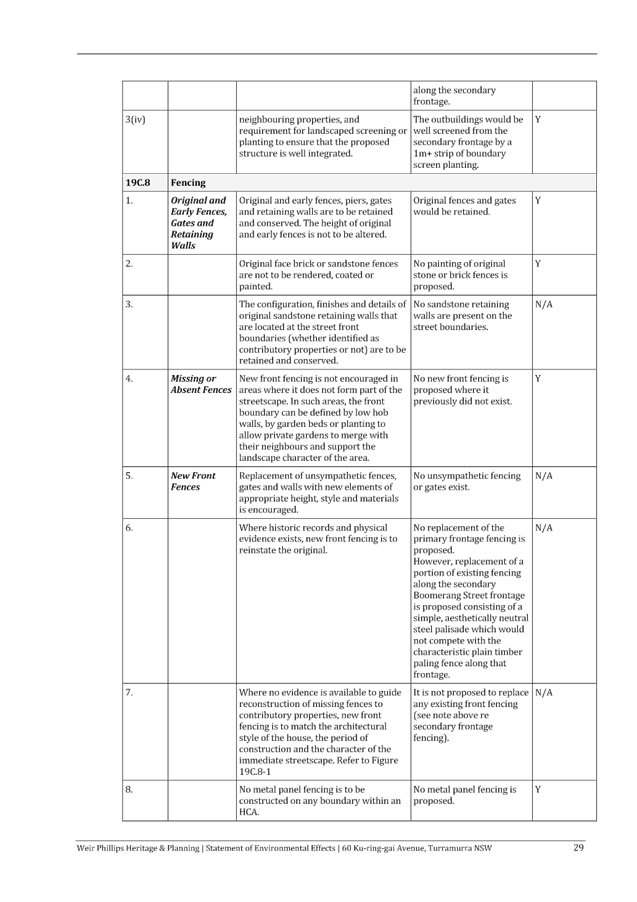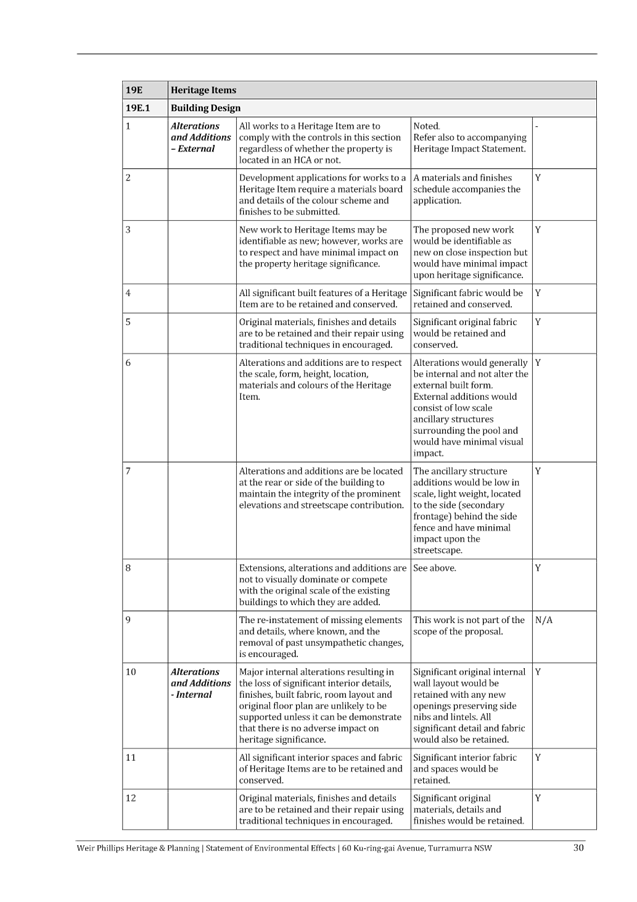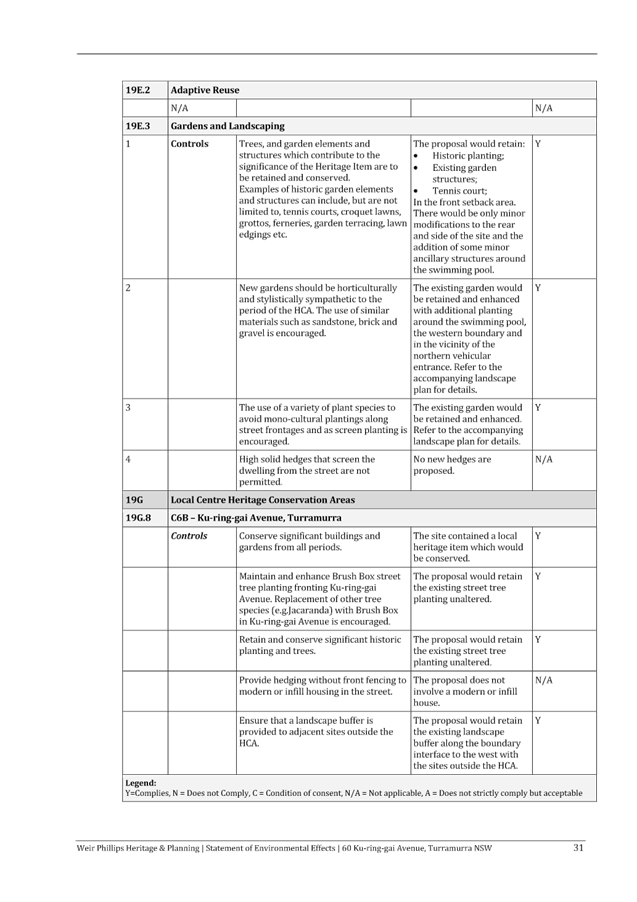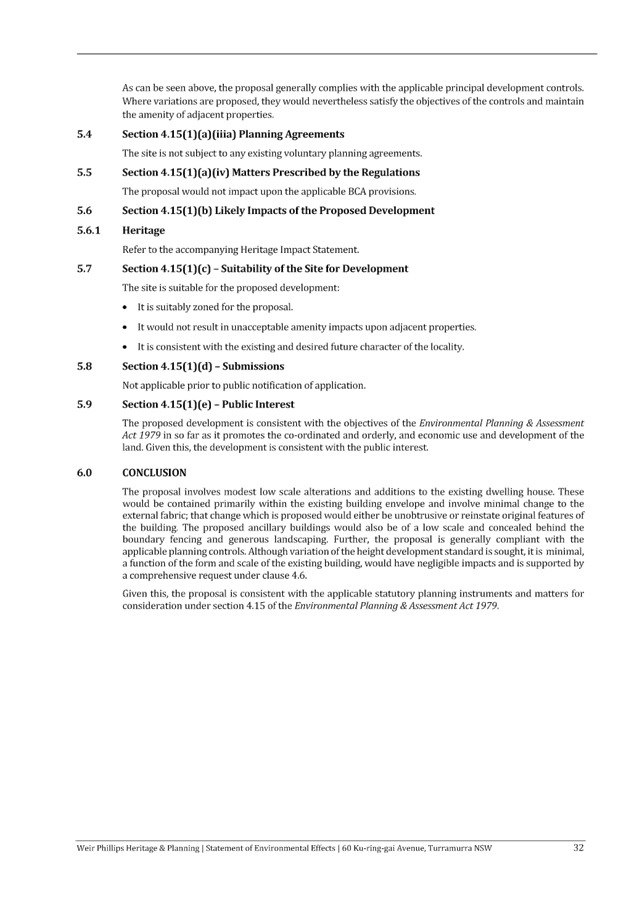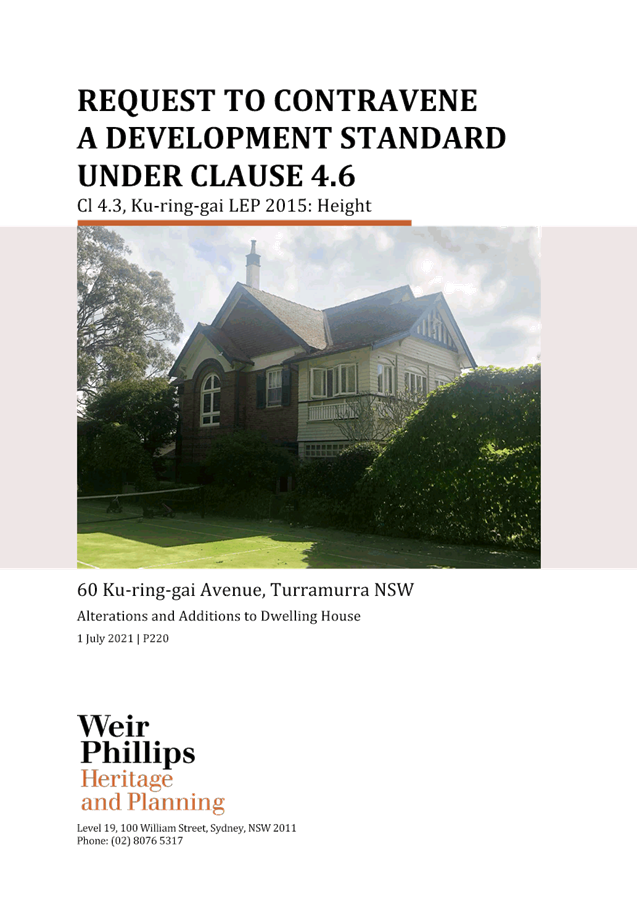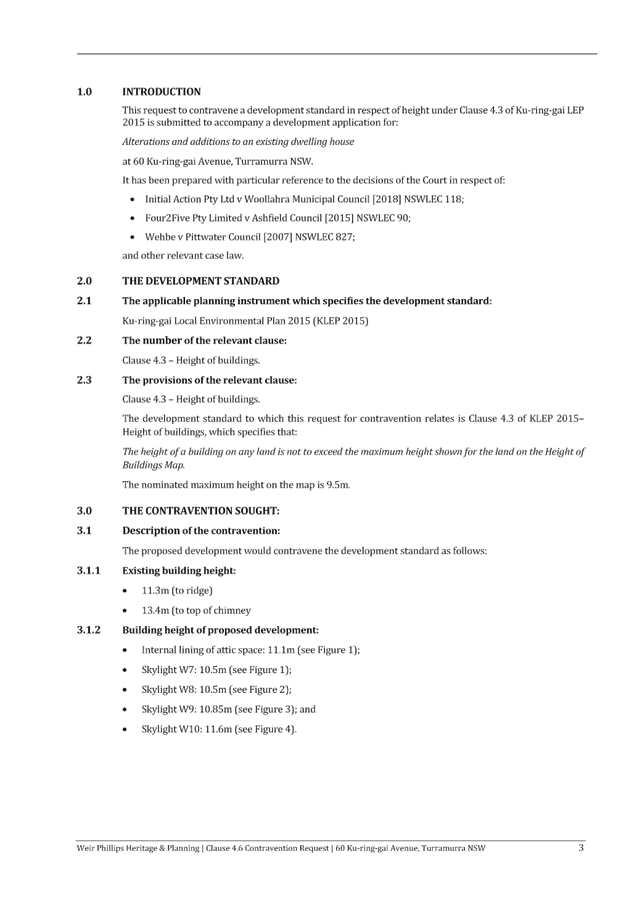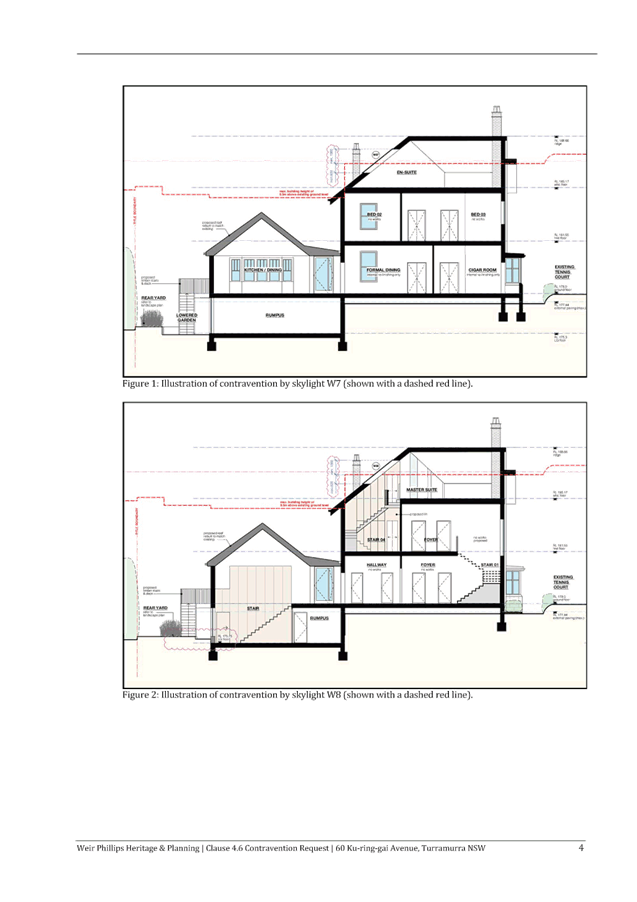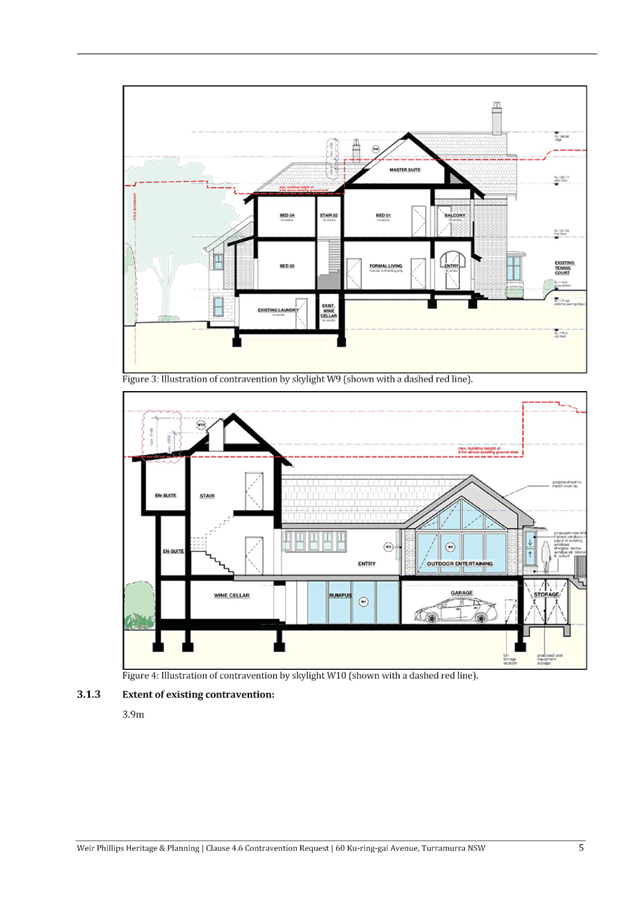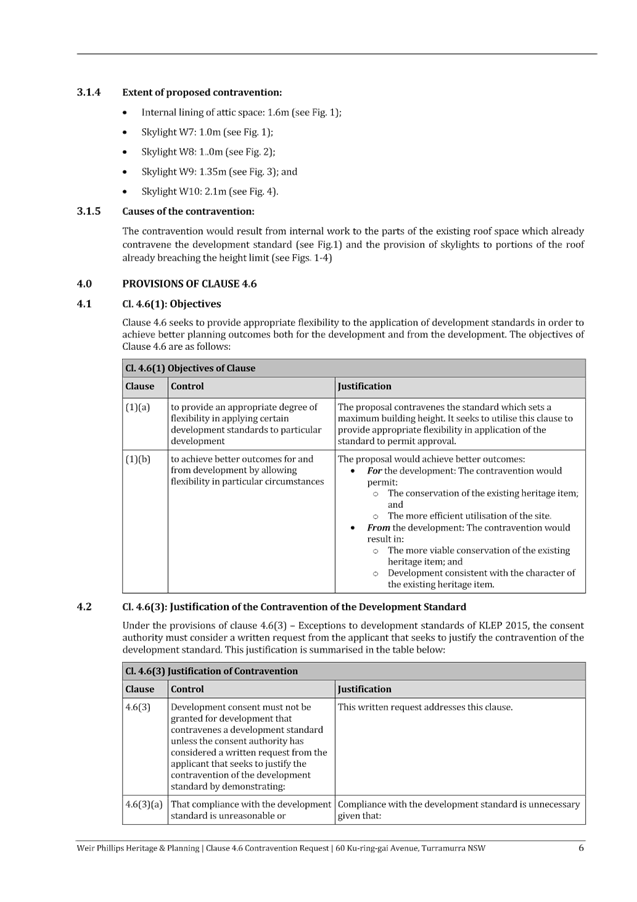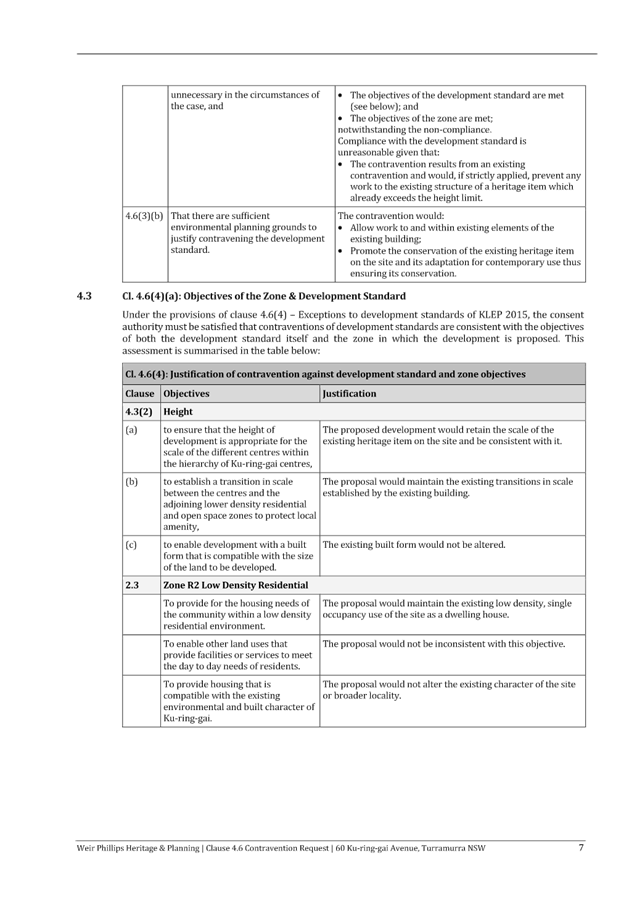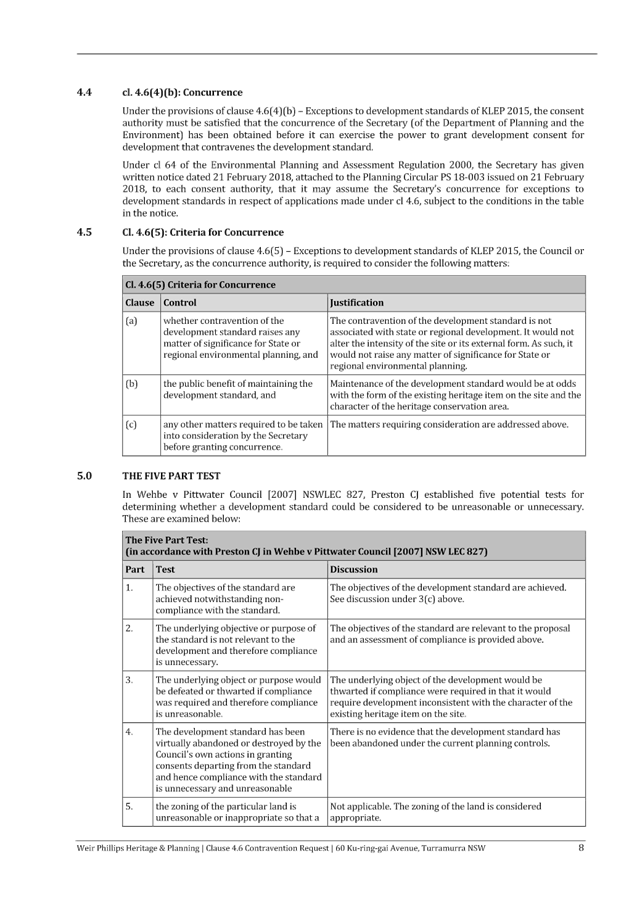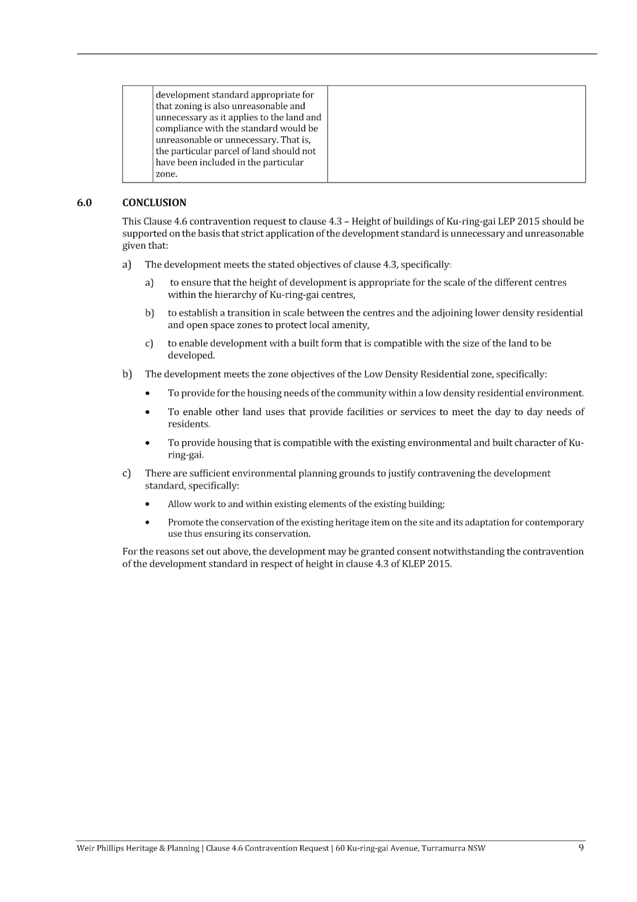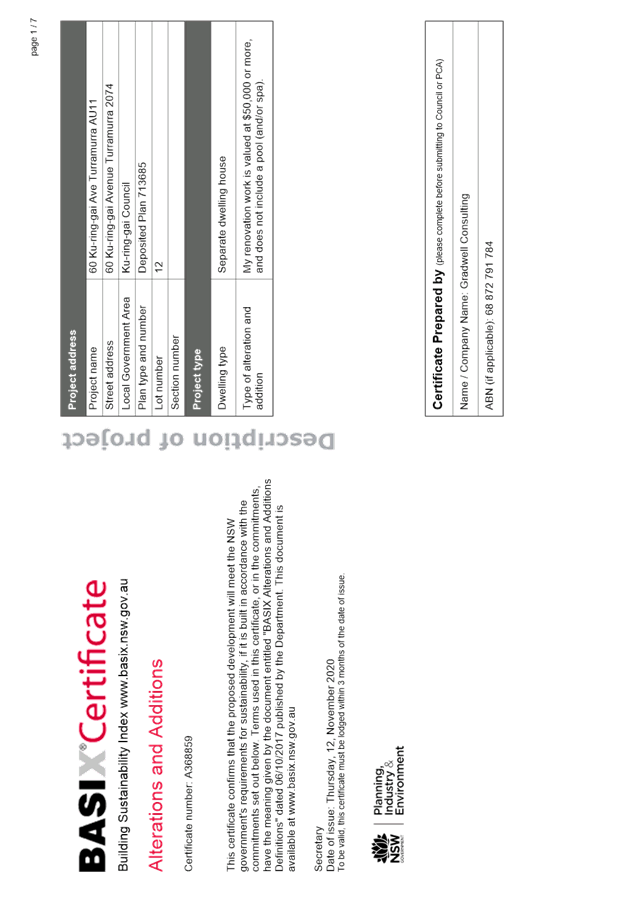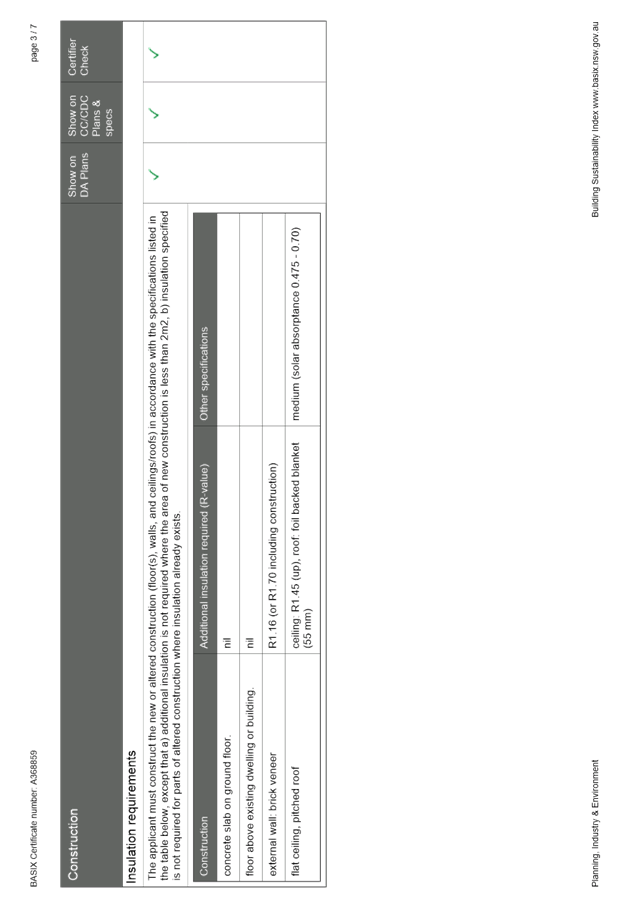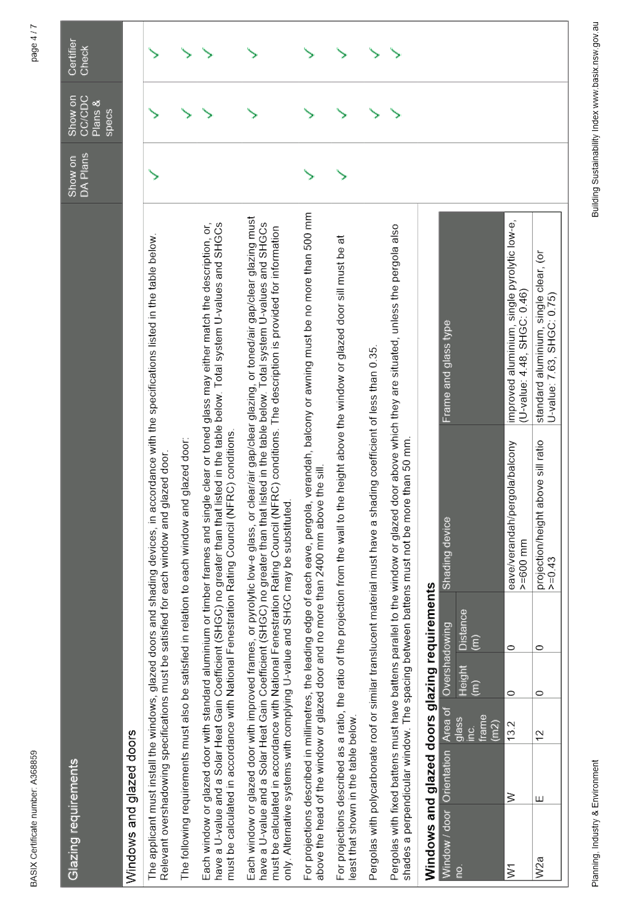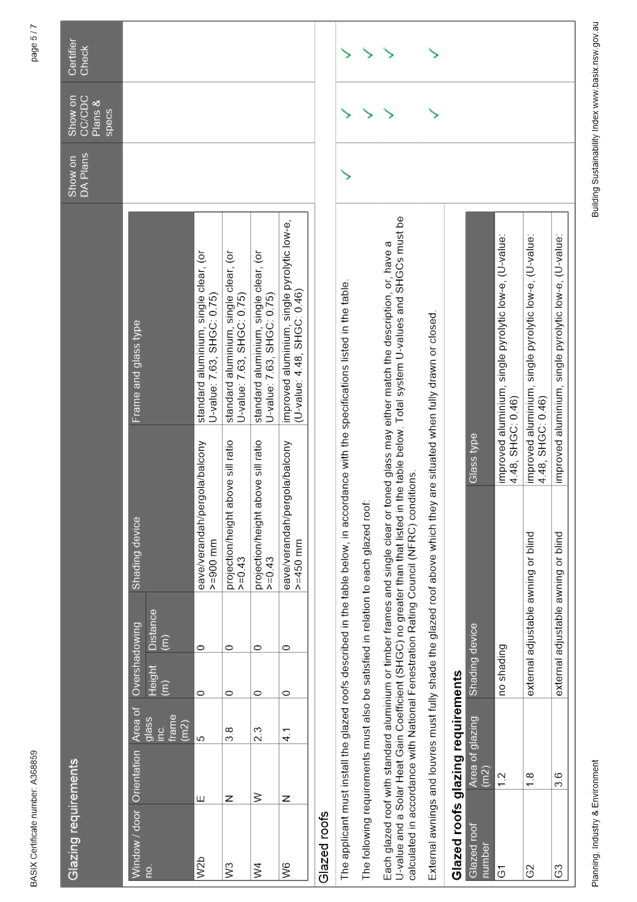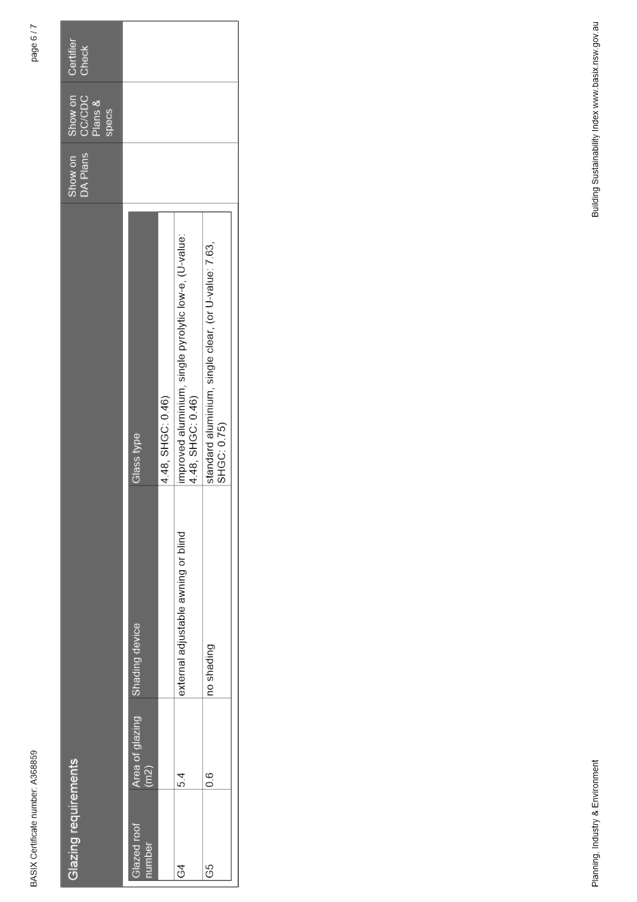|
APPENDIX No: 1 - Development
Assessment Report
|
|
Item No: GB.3
|

ASSESSMENT REPORT
|
REPORT TITLE:
|
60 Ku
ring gai Avenue, Turramurra - Internal alterations and additions, landscaping
and sauna
|
|
Application No:
|
DA0470/20
|
|
Property Details:
|
60
Ku-ring-gai Avenue, Turramurra
Lot 12 DP
713685
1979.00m2
R2 Low
Density Residential
|
|
Ward:
|
Wahroonga
|
|
Proposal/Purpose:
|
Internal
alterations and additions, landscaping works and sauna
|
|
Type of DEVELOPMENT:
|
Local
|
|
Applicant:
|
Stephanie
Sally Craddock
|
|
Owner:
|
Mr JB
Craddock, Mrs SS Craddock
|
|
Date Lodged:
|
2
December 2020
|
|
Recommendation:
|
Approval
|
Purpose of Report
To determine
Development Application No DA0470/20 for internal alterations and
additions, landscaping works and sauna.
This
application is reported to the Ku-ring-gai Local Planning Panel in accordance
with the Minister’s S 9.1 Local Planning Panels Direction, dated 30 June
2020 for determination as it proposes a departure from a development standard
in excess of 10%.
integrated planning and reporting
Places, Spaces
& Infrastructure
|
Community Strategic Plan Long Term Objective
|
Delivery Program
Term Achievement
|
Operational Plan
Task
|
|
P2.1 A robust
planning framework is in place to deliver quality design outcomes and
maintain the identity and character of Ku-ring-gai
|
Applications
are assessed in accordance with state and local plans.
|
Assessments
are of a high quality, accurate and consider all relevant legislative
requirements
|
Executive Summary
|
Issues:
|
Installation
of a skylights which breach the maximum building height standard.
|
|
|
|
Submissions:
|
Nil
|
|
|
|
Land and
Environment Court:
|
N/A
|
|
|
|
Recommendation:
|
Approval
|
HISTORY
Site history:
The site has a history of residential use.
Previous applications history:
A Pre-DA consultation was not
undertaken.
Council’s records show a history
of applications relating to the site as follows:
|
Type
|
Application
|
Description
|
Decision
|
Date
|
|
ConvDA
|
3620/93
|
Add carport and front fence to heritage
listed property (SB) (W)
|
Approved
|
27/07/1993
|
|
ConvBA
|
93/01544
|
Proposed carport and front fence to
dwelling
|
Approved
|
09/12/1993
|
|
DA
|
DA0745/07
|
Heritage Property - Additions and
Alterations
|
Approved
|
26/11/2007
|
Current Development Application
|
Date
|
Action
|
|
2
December 2020
|
Application
lodged.
|
|
17
December 2020
|
The
application was notified to neighbouring property owners for a period of 14
days. No submissions were received.
|
|
2
March 2021
|
Council
sent a letter to the applicant seeking additional information.
Matters
raised in the letter included:
I. a request for
additional information concerning trees (arboriculture assessment).
II. plans to provide
additional information with respect to levels.
III. details demonstrating
that the proposed pool fencing is consistent with the Swimming Pools Act 1992
|
|
21
March 2021
|
Amended
plans and documentation were received
|
|
24
June 2021
|
Council
sought an amended Clause 4.6 variation request.
|
|
2
July 2021
|
An
amended Clause 4.6 objection was received by Council.
|
THE SITE

Figure 1
– aerial photograph of the site
Site description:
The subject
site is legally described as Lot 12 in DP 713685 and as known as No 60
Ku-ring-gai Avenue, Turramurra. The site is a corner allotment and is irregular
in shape, with a frontage of approximately 49.6 metres to Ku-ring-gai Avenue
and a secondary frontage of approximately 45m to Boomerang Street. The site has
an average depth of 45 metres and a total area of 1,979m2. The site
falls from the south-eastern corner (Ku-ring-gai Avenue) to the north-western
corner (Boomerang Street). Located on the western side of Ku-ring-gai Avenue,
the site is positioned on the low side of the street.
The site
currently accommodates what predominantly presents as a two storeys dwelling of
brick construction with a pitched tiled roof. The site is a local heritage item
and falls within a heritage conservation area. The site is also occupied by a
swimming pool, tennis court and ancillary structures. The site has driveway
access to both Ku-ring-gai Avenue and Boomerang Street.
|
Constraint:
|
Application:
|
|
Visual
character study category
|
Pre
- 1920
|
|
Easements/rights
of way
|
Easement
to drain water 2.5 metre wide
|
|
Heritage
Item - Local
|
Yes
|
|
Heritage
Item - State
|
No
|
|
Heritage
conservation area
|
Yes
- Ku-ring-gai Avenue HCA
|
|
Within
100m of a heritage item
|
Yes
– The site is within 100 metres of the following listed items. -
12 Wonga Street
54,
61, 70, 73, 75, 77 Ku-ring-gai Avenue
|
|
Bush
fire prone land
|
No
|
|
Natural
Resources Biodiversity
|
No
|
|
Natural
Resources Greenweb
|
No
|
|
Natural
Resources Riparian
|
No
|
|
Within
25m of Urban Bushland
|
No
|
|
Contaminated
land
|
No
|
Surrounding development:
The
immediate locality is characterised by a mixture of dwelling houses on an
equally mixed selection of allotments with respect to their size and shape. A
substantial number of properties in the locality have a swimming pool and
tennis court.
The
properties that surround the site are mainly zoned R2 Low density
Residential. Ku-ring-gai Avenue derives its fine aesthetic qualities from its
collection of grand Federation period residences set in generous and
well-proportioned garden settings, which blend into the mature brush box avenue
street tree planting. Prominent Sydney architects designed many of these residences.
The built character of the Ku-ring-gai Avenue Heritage
Conservation Area features a predominance of two storey late 19th century
Federation period mansions. The majority of the residences are of the
Federation Queen Anne style, on large lots with large mature gardens,
interspersed with a smaller number of later 1 and 2 storey houses.
The area presents high-quality Federation period streetscapes,
including Federation period street tree planting and mature gardens. The
buildings from the key periods of significance for the area - Federation period
1890s-1914, and the Inter War period are predominantly of brick construction
with slate or terracotta tile roofs and timber-framed windows.
THE PROPOSAL
The
application proposes the following works:
Site works
· partial excavation of
western rear yard to create lowered garden terrace adjoining the lower ground
floor rumpus room
· replacement of existing
vehicular gates across the driveway and a new pedestrian gate on the northern
boundary to match existing fencing
· replacement of the existing
rendered retaining wall
· new stairs to the pool area,
pool equipment storage and low brick planter bed
· replacement of the existing
pool area paving with new paving
· replacement of the existing
glass pool fencing with new steel palisade style fencing
· construction of a new
outdoor kitchen, sunken spa, sauna and steel pergola structure
· construction of a new
awning at front of garage forward of a deck with staircase down to lower
ground floor
· landscaping works
Lower ground floor
· removal of the
existing workshop walls to accommodate a new car space with car slider
· removal of the existing
staircase to the rumpus and construction of a new stair case to the ground
floor
· replacement of the existing
bi-fold door to the rumpus with a new timber framed stacking door
Ground floor
· refinishing of the walls to
the existing formal living, formal dining and cigar rooms
· new opening, with face
sliding door, to western wall of formal dining room
· replacement of the existing
linen room and WC with new powder room and store
· new window in the western
wall of Bedroom 5 to match the existing
· refurbishment of the
kitchen/dining/living room with a new fit-out (fit out not shown)
· existing roof to be rebuilt
to create a raked ceiling. Roof profile and cladding to be retained
· replacement of the bi-fold
door to eastern wall of the kitchen/dining/living room with a timber framed
stacking door
· replacement of the existing
bay windows to the northern wall of the kitchen/dining/living room with a
vertical sliding and stacking windows
· replacement of the existing
window to northern wall entry with new glazed pivoting entry door and
sidelight
· new skylight to the entry
· removal of the existing
windows and doors to the existing sun room to create a verandah.
· new openings within the
northern wall of the sunroom
· replacement of the timber
parquetry floor of the veranda with new decking
First floor
· removal of the existing
bathroom and construction of a timber stair case linking the first floor to the
attic level. Installation of a lift adjacent to the stare case linking the
first floor and attic level
· new skylight to the rear
stairs
· new en-suite to the Bedroom
2 sunroom.
· new en-suite and robe to the
Bedroom 3 sunroom
Attic floor
· construction of a new attic
floor level within the existing roof void, including master bedroom, en-suite
and storage with three skylight windows to the western roof slope
Amended plans and documentation dated 21 April
2021
Amended plans and documentation were received in response to
Council’s letter dated 2 March 2021. The amended plans proposed the
following:
· modifications to the pool
area enclosure to ensure the development was compliant with the Swimming Pools
Act 1992
The additional documentation comprised:
· provision of an
Arboriculture Impact Assessment Report
Amended documentation dated 2 July 2021
In response to a request for additional information in
Council’s letter dated 24 June 2021, an amended Clause 4.6 variation
request was submitted. The amended Clause 4.6 variation request addresses
the building height breaches caused by the proposed skylights.
CONSULTATION
Community
In
accordance with Appendix 1 of the Ku-ring-gai Community Participation Plan,
owners of surrounding properties were given notice of the application. No
submissions were received.
Amended plans and documentation dated 21 April
2021 and 2 July 2021
The amended plans were not required to be notified to surrounding
residents, pursuant to Council’s Community Participation Plan, as the
proposed amendments do not result in a greater environmental impact than the
original proposal.
Internal referrals
Heritage
Council's
Heritage Advisor commented on the proposal as follows:
Heritage status
|
KLEP 2012 (Local Centres)
|
Yes
|
|
Local Heritage Item
|
Yes (I153)
|
|
Heritage Conservation Area
|
Yes (C6B)
|
|
Immediate vicinity of a heritage item
|
Yes (I790)
|
|
Immediate vicinity of a HCA
|
Yes (C6A)
|
Statement of Significance
Below is Council’s heritage inventory sheet regarding
the statement of significance for the Heritage Conservation Area/Heritage
Item and the State Heritage Inventory sheet detailing the statement of
significance for No. 60 Ku-ring-gai Avenue:
‘Reasons for listing;
historic, cultural, social, architectural, state significance.’
‘The Ku-ring-gai Avenue Heritage Conservation Area is of
historic, aesthetic, social and technological significance as one of the most
socially prestigious Federation period streets in Sydney and potentially New
South Wales. Ku-ring-gai Avenue derives its fine aesthetic qualities from its
collection of grand Federation period residences set in generous and
well-proportioned garden settings which blend into the mature brush box avenue
street tree planting. Many of these residences were designed by prominent
Sydney architects, including Thomas Frame Cosh (of Slatyer & Cosh, Spain
& Cosh), Arthur Stanton Cook, G.M. Pitt junior, Robertson & Marks and
Sir John Sulman.
The HCA is also of historical and social significance for its
association with the important artist Grace Cossington Smith, whose works were
inspired by her home and its setting; and for its association with prestigious
and influential early residents including the Penfold family (stationers) and
many of Sydney’s most prominent early twentieth century architects,
including Charles Slatyer, Thomas Frame Cosh, John Spencer Stansfield, Sir John
Sulman and Arthur Stanton Cook.’
Controls
The following heritage
controls apply:
|
19B.1 Demolition within HCAs
|
|
Development Controls
|
Complies
|
|
1 The demolition of Heritage Items and contributory
buildings within HCAs is not supported
|
YES
|
|
2 In considering applications for partial
demolition of buildings, structures and landscape features (including
significant trees) within HCAs, Council will assess:
i) the significance of the building part or
structure and/or landscape feature and whether its retention is considered
necessary;
ii) its contribution to the streetscape;
iii) potential for modifying and/or removing
neutral and/or uncharacteristic elements that would re-establish the
contributory status of the building or structure within the HCA;
iv) opportunities for adaptive re-use of the
building
|
YES
|
|
Archival Recordings
|
|
3 In a situation where demolition is
approved, Council may require an archival and photographic record of the
building and grounds (in accordance with the NSW Heritage Branch guidelines)
before and during works.
|
YES
|
|
19B.2 Demolition related to a Heritage Item
|
|
1 The demolition of a Heritage Item,
including buildings, other structures, trees and landscape features, is not
supported.
|
YES
|
|
Partial Demolition of a Heritage Item
|
|
2 In considering applications for partial
demolition of a Heritage Item (including parts of buildings and other
structures, trees and
landscape features), Council will assess:
i) the significance of the building part or
structure and/or landscape features and whether its retention is considered
necessary;
ii) its contribution to the significance of
the Heritage Item as a whole;
iii) whether all alternatives to demolition
have been considered with reasons provided as to why the alternatives are not
acceptable
|
YES
|
|
Archival Recordings
|
|
3 If development consent is granted for
demolition of whole or part or all of a Heritage Item, Council may require an
archival and photographic record of the building and grounds (in accordance
with the NSW Heritage Branch guidelines) before and during works.
|
YES,
subject to Condition 6
|
|
19C DEVELOPMENT WITHIN HCAS: ALTERATIONS AND ADDITIONS
|
|
Development Control
|
Complies
|
|
19C.1 Local Character and Streetscape
|
|
Built Form
|
|
1. Alterations and additions
are to respect the heritage significance and predominant architectural
character of the HCA
|
YES
|
|
2.
Proposed works to contributory buildings are to retain the original character
of a building.
|
YES
|
|
Corner Sites and Secondary Street Frontages
|
|
3.
Consider the impact of proposals on both street frontages.
|
YES
|
|
4.
Landscaping is required to both street boundaries
|
YES
|
|
5
New development or additions are to be located to minimise impact on existing
prominent trees.
|
YES
|
|
6.
New side fences should be designed and located to maintain the streetscape
character.
|
YES
|
|
19C.3 Gardens and Landscaping
|
|
1.
The established landscape character is to be retained.
|
NO
|
|
2.
Original garden features to remain
|
NO
|
|
19C.4 Access and Parking
|
|
Driveways
|
|
1.
Retain original and existing rear lane or side entry vehicle access.
|
YES
|
|
2..
New parking areas, garages and driveways are not to dominate.
|
YES
|
|
3.
Finishes matching original driveway finishes or be appropriate to HCA.
|
YES
|
|
19C.5 Building Design
|
|
Materials, Colours and Details
|
|
1.
Materials board and details of the colour scheme to be submitted.
|
YES
|
|
2
Significant unpainted surfaces not to be rendered, coated or painted
|
YES
|
|
3
The removal of later layers of paint from original face brickwork and
stonework is encouraged.
|
YES
|
|
4.
Significant materials and finishes are to be retained and repaired.
|
YES
|
|
5.
Significant materials, finishes and details are to be retained.
|
YES
|
|
6.
Contemporary materials are permitted for new work where they blend in.
|
YES
|
|
Repairs, Maintenance and Restoration
|
|
7.
The repair and maintenance of contributory buildings is encouraged.
|
YES
|
|
8.
In repairing the fabric of external surfaces use matching materials.
|
YES
|
|
Verandahs
|
|
9. Original verandahs to the front and
visible side elevations of contributory buildings are to be retained.
Infilling of verandahs is not permitted.
|
YES
|
|
Doors and Windows
|
|
10.
Original doors and windows to principal and secondary elevations of
contributory buildings are to be retained.
|
YES
|
|
11.
The repair and restoration of original doors and windows to principal and
secondary elevations of contributory buildings is encouraged.
|
YES
|
|
12.
New doors and windows in additions and alterations are to be compatible
existing doors and windows
|
YES
|
|
13.
New windows to principal and secondary elevations of contributory buildings
are to be appropriate in form and material for the style of the house
|
YES
|
|
19C.6 Roof Forms and Structures Attached to Roofs
|
|
Roofs, Chimneys, Dormers, and Skylights
|
|
1.
Fireplaces and chimneys in HCAs and are to be retained
|
YES
|
|
2.
Roof forms and details to be retained.
|
NO
|
|
3.
Attic rooms are to use existing roof forms
|
YES
|
|
4.
Skylights and dormer windows are not to be used on the street facing elevations
|
YES
|
|
5
New or replacement roof materials are to match, existing roof materials.
|
YES
|
|
20C.8 Fencing
|
|
New Front Fences
|
|
5
Replacement of unsympathetic fences, gates and walls with new elements of
appropriate height, style and materials is encouraged.
|
YES
|
|
6
Where historic records and physical evidence exists, new front fencing is to
reinstate the original
|
YES
|
|
7
Where no evidence is available to guide reconstruction of missing fences to
contributory properties, new front fencing is to match the architectural
style of the house, the period of construction and the character of the
immediate streetscape
|
YES
|
|
8
No metal panel fencing is to be constructed within an HCA.
|
YES
|
19E HERITAGE ITEMS
|
|
Development Controls
|
Complies
|
|
19E.1 Building Design
|
|
Alterations and Additions – External
|
|
1
All works to a heritage item are to comply with the controls in this section
regardless of whether the property is located in an HCA or not.
|
NO
|
|
2
Development applications for works to a Heritage Item require a materials
board and details of the colour scheme and finishes to be submitted.
|
YES
|
|
3
New work to heritage items may be identifiable as new; however, works are to
respect and have minimal impact on the property heritage significance.
|
YES
|
|
4
All significant built features of a heritage item are to be retained and
conserved.
|
YES
|
|
5
Original materials, finishes and details are to be retained and their repair
using traditional techniques in encouraged.
|
NO
|
|
6
Alterations and additions are to respect the scale, form, height, materials
and colours of the heritage item
|
YES
|
|
7
Alterations and additions are be located at the rear or side of the building
to maintain the integrity of the prominent elevations and streetscape
contribution.
|
YES
|
|
8
Extensions, alterations and additions are not to visually dominate or compete
with the original scale of the existing building.
|
YES
|
|
9
The re-instatement of missing elements and details, where known, and the
removal of past unsympathetic changes, is encouraged.
|
YES
|
|
Alterations and Additions - Internal
|
|
10
Major internal alterations resulting in the loss of significant interior
details, finishes, built fabric, room layout and original floor plan are
unlikely to be supported unless it can be demonstrated that there is no
adverse impact.
|
YES
|
|
11
All significant interior spaces and fabric of heritage items are to be
retained and conserved.
|
YES
|
|
12
Original materials, finishes and details are to be retained and their repair
using traditional techniques in encouraged
|
YES
|
|
19E.3 Gardens and Landscaping
|
|
1
Trees, and garden elements and structures which contribute to the
significance of the heritage item are to be retained and conserved.
|
YES
|
|
2
New gardens should be horticulturally and stylistically sympathetic to the
period of the HCA. The use of similar materials such as sandstone, brick and
gravel is encouraged.
|
YES
|
|
3
The use of a variety of plant species to avoid mono-cultural plantings along
street frontages and as screen planting is encouraged.
|
YES
|
|
4
High solid hedges that screen the dwelling from the street are not permitted
|
YES
|
|
|
|
DEVELOPMENT IN THE VICINITY OF HERITAGE ITEMS OR HERITAGE
CONSERVATION AREAS (HCAS)
|
|
Development Controls
|
Complies
|
|
19F.1 Local Character and Streetscape
|
|
General
1
All development in the vicinity of a heritage item or HCA is to include a
Heritage Impact Statement.
|
YES
|
|
|
|
2
Development on sites that either directly adjoin or are in the vicinity of a
heritage item or an HCA is to have regard to:
i)
the form of the existing building or buildings including height, roofline,
setbacks and building alignment;
ii)
dominant architectural language such as horizontal lines and vertical
segmentation;
iii)
proportions including door and window openings, bays, floor-to ceiling
heights
and coursing levels;
iv)
materials and colours;
v)
siting and orientation;
vi)
setting and context;
vii)
streetscape patterns.
|
YES
|
|
Views
|
|
3.
New development in the vicinity of a heritage item or HCA is to demonstrate
that it will not reduce or impair important views to and from the Heritage
Item from the public domain.
|
YES
|
|
19F.2 Building Setbacks
|
|
Setbacks
|
|
19F.3 Gardens and Landscaping
|
|
Gardens, Setting and Curtilage
|
|
1
Development in the vicinity of a heritage item or an HCA is to:
i)
retain original or significant landscape features associated with the
heritage item or HCA, or which contribute to its setting
ii)
retain the established landscape character of the Heritage Item or HCA.
iii)
include appropriate screen planting on side and rear boundaries.
|
YES
|
|
19F.4 Fencing
|
|
Fences on adjoining sites
|
|
1
New front fences on adjacent sites are to be no higher than the front fences
of the adjoining Heritage Item or HCA. Open and transparent front fences such
as timber or metal picket are preferred.
|
YES
|
|
2
No metal panel fencing is to be constructed on any boundary of a Heritage
Item.
|
YES
|
The non compliances with Council’s heritage controls are
addressed below.
19E HERITAGE ITEMS
19E.1 Building Design
Alterations and Additions – External
5) Original materials, finishes and details are
to be retained and their repair using traditional techniques in encouraged.
Cut-outs in the roof for skylights are very large in size,
however, the street facing portions of the roof form is to be left intact
without perforation. Although the proposal is non-compliant, the impact to
fabric is acceptable in this instance as the perforations only pertain to
sections of the roof not interpretable from the public domain.
Removal of any
original/early terracotta shingles is considered acceptable as they will not
need to be cut or damaged to enable the proposed design, they may simply be
removed and stored on-site for use in future patch and repair instances. The
heritage impacts in light of the aforementioned are acceptable. The roof will
remain to be interpreted as intact from the streetscape.
19C.6 Roof Forms and Structures Attached to
Roofs
Roofs, Chimneys, Dormers, and Skylights
2 Roof forms and details to be retained.
The proposal is in technical non-compliance with this clause as
there will be portions of roofing to be removed including some original
structural members and roofing materials. The overall form of the roof is to
remain which is a desired and acceptable outcome. The structure associated with
the roof form is not what renders the dwelling significant and as such, it may
be removed.
The areas
where the skylight well and stairs to the new ceiling room are to be
reticulated into the dwelling will necessitate the removal of later addition
ceiling linings and modified fabric pertaining to an upstairs storage room.
This layout poses no material/fabric impacts as there is no fabric of note to
be removed within the area the stairs and principal skylight are to be
located.
Removing portions of
original terracotta shingles to make way for the perforations poses no material
impacts as they may simply be removed and stored on-site for use in future
patch and repair instances. The heritage impacts in light of the aforementioned
are acceptable.
19C.3 Gardens and Landscaping
1. The established landscape character is to be
retained.
2. Original garden features to remain
The landscape design has been amended from an initially native
species focussed planting schedule to that of a landscape design featuring
diverse exotic species. The amended design will render the new garden design
consistent with the architectural character of the house. Dwellings of this
period featured gardens with exotic species, which the amended schedule is
consistent with.
Recommendation
Although the proposal seeks
to perforate an original roof form, there will be no streetscape impacts
regarding this loss in fabric as the alterations will not be perceived from the
public domain. The areas where the skylight well is to be reticulated into the
dwelling will necessitate the removal of later addition ceiling linings which
pose no material/fabric impacts.
Removing portions of
original terracotta shingles to make way for the perforations poses no material
impacts as they may simply be removed and stored on-site for use in future
patch and repair instances. The heritage impacts in light of the aforementioned
are acceptable.
The roof space is to be
utilised as a room and will be experiencing alterations and loss of portions of
the original timber framing to facilitate space. This is an acceptable impact
as the intactness of the internal roof form is not why this dwelling is
significant in its statement of significance and, the roof will be interpreted
as is (intact) from the HCA.
Landscaping
Council's Senior Landscape and Tree Assessment Officer commented
on the proposal as follows:
|
SEPP (Building Sustainability Index: BASIX)
2004
|
|
Part 3 Aims
|
Proposed
|
Satisfies
|
|
To
encourage sustainable residential development
|
There
are no landscape commitments in the BASIX.
|
YES
|
|
KDCP COMPLIANCE TABLE
|
|
Control
|
Proposed
|
Complies
|
|
Part 4A.4 Landscaping and Part 13 Tree and
Vegetation Preservation
|
|
Landscape
proposals are to retain existing trees where possible
|
The proposal includes the removal of existing
trees. The following comments are made:
- The removal of T7 Bauhinia
variegata (Orchid Tree) is supported as the tree is suppressed and does not
contribute to the broader landscape setting. To minimise further impact to
other trees in close proximity it can be conditioned for the tree to be removed
to ground level only with no stump grinding – Condition 34.
- The removal of the
established Leighton’s Green Cypress hedge is acceptable. While
providing screening, the hedge is a contemporary planting and does create an
amenity issue due to its density and height.
- T1 is a mature Jacaranda
mimosifolia (Jacaranda) located adjacent to the western site boundary with an
identified TPZ of 6.5 metres. Tree 1 is shown to be retained with excavation
of approximately 600 millimetres within the TPZ. The extent of excavation has
been significantly reduced with the amended proposal within an acceptable
threshold to enable the viability of the tree.
- Tree 5 Ficus rubignosa
(Port Jackson Fig) and Tree 6 Brachychiton acerifolius (Illawarra Flame Tree)
located adjacent to the northern site boundary are shown to be retained.
Development encroachments are assessed as being within an acceptable
threshold for the viability of both trees.
|
YES
|
|
Tree
replenishment and planting to be provided.
|
Not
required due to existing tree canopy
|
YES
|
|
Part 19 Heritage Items and Heritage Conservation Areas
|
|
19E.3
Gardens and Landscaping – Heritage Items
|
The
landscape works propose a designed landscape outcome with exotic species
appropriate for the heritage item and HCA.
|
YES
|
|
Part 21 General Site Design
|
|
21.1
Earthworks and Slope
|
Minimal earth works are proposed in
association with the proposed works. In this regard, the proposal is
considered acceptable.
|
YES
|
|
21.2
Landscape Design
To
ensure the landscape design and species selection is suitable to the site its
context and considers the amenity of residents and neighbours.
|
As
per DCP Part 19E.3, Control 2 new gardens shall be horticulturally and
stylistically sympathetic to the period of the HCA.
The landscape works propose a designed
landscape outcome with exotic species appropriate for the heritage item and
HCA.
|
YES
|
Recommendation:
The proposal is acceptable
with conditions (Conditions 7, 8, 9, 10, 11, 24, 32, 33, 34, 35, 36, 37, and
44). The Tree Protection Plan is to be included in Condition 1.
Engineering
An engineering referral was not
necessary for this application.
External Referrals
Not
applicable.
STATUTORY PROVISIONS
State Environmental Planning Policy No.
55 – Remediation of Land
The
provisions of SEPP 55 require Council to consider the potential for a site to
be contaminated. The subject site has a history of residential use and, as
such, it is unlikely to contain any contamination and further investigation is
not warranted in this case.
New Remediation of Land State Environmental
Planning Policy (new Remediation of Land SEPP)
An explanation of intended effect for a new Remediation of
Land SEPP and draft planning guidelines was exhibited between 31 January 2018 and 13 April 2018. It is
proposed the new land remediation SEPP will:
· require all remediation work that is to
be carried out without development consent, to be reviewed and certified by a
certified contaminated land consultant,
· categorise remediation work based on the
scale, risk and complexity of the work, and
· require environmental management plans
relating to post-remediation management of sites or ongoing operation,
maintenance and management of on-site remediation measures (such as a
containment cell) to be provided to Council.
The development
has been considered against the exhibited documents and considered to be
consistent with the aims and intentions of the new Remediation of Land SEPP.
Sydney Environmental Planning Policy (Building
Sustainability Index: BASIX) 2004
A valid BASIX certificate has been submitted. The certificate
demonstrates compliance with the provisions of the SEPP and is consistent with
commitments identified in the application documentation.
Sydney Regional Environmental Plan No. 20 – Hawkesbury-Nepean River
SREP 20 applies to land within the catchment of the Hawkesbury
Nepean River. The general aim of the plan is to ensure that development and
future land uses within the catchment are considered in a regional context. The
Plan includes strategies for the assessment of development in relation to water
quality and quantity, scenic quality, aquaculture, recreation and tourism.
The proposed development is considered to achieve the relevant
aims under this policy as water re-use will minimise the impact on downstream
waterways.
Draft
Environment SEPP
The draft
Environment SEPP was exhibited from 31 October 2017 to 31 January 2018. The
consolidated SEPP proposes to simplify the planning rules for a number of water
catchments, waterways and urban bushland areas. Changes proposed include
consolidating a number of SEPPs, which include:
· State Environmental Planning Policy No.
19 – Bushland in Urban Areas
· Sydney Regional Environmental Plan No.
20 – Hawkesbury-Nepean River (No.2 1997)
· Sydney Regional Environmental Plan
(Sydney Harbour Catchment) 2005
The proposal is
not inconsistent with the provisions of the draft SEPP.
Local Content
Ku-ring-gai Local Environmental Plan 2015
Ku-ring-gai Local Environmental Plan 2015 is the applicable LEP
for the subject site.
Aims of the KLEP 2015
The Ku-ring-gai
Local Environmental Plan 2015 is the primary environmental planning instrument
that applies to the subject site. In summary, the relevant aims seek to:
· guide the
future development of land and the management of environmental, social,
economic, heritage and cultural resources within Ku-ring-gai
· recognize, protect and conserve Ku-ring-gai’s indigenous and
non-indigenous cultural heritage
· encourage a variety of housing types within Ku-ring-gai
· protect the character of low density residential areas and the special
aesthetic values of land in the Ku-ring-gai area
The relevant
aims of the KLEP are achieved because the development has been designed to
conserve and protect the heritage significance of the site. The development
achieves the desired living arrangements for the its residents while ensuring
the heritage significance of the site is maintained and conserved. The
development maintains the character of the local area and particularly of this
important heritage conservation area.
Zoning and permissibility:
The site is zoned R2 Low Density Residential under the
Ku-ring-gai Local Environmental Plan 2015. The proposed development is defined
as alterations and additions to an existing dwelling house and is permissible
development within the zone. The
objectives of this zone seek to:
· provide for the housing
needs of the community within a low-density residential environment
· enable other land uses that
provide facilities or services to meet the day-to-day needs of residents
· provide for housing that is
compatible with the existing environmental and built character of Ku-ring-gai.
The
development:
· provides for the housing needs of the
current owners in the low density residential environment
· is appropriately designed to maintain
the heritage significance of the site and the existing environmental and built
character of the immediate locality and therefore Ku-ring-gai area
The proposed
development therefore upholds the relevant zone objectives.
Development standards:
Ku-ring-gai Local Environmental Plan 2015
|
Development standard
|
Proposed
|
Complies
|
|
Cl 4.1 - Minimum subdivision lot size:
Minimum
Lot Size – 930m2
|
No subdivision proposed
1,979.00 m2
|
YES
|
|
Cl 4.3 -
Height of buildings:
Maximum
Building Height - 9.5 metres
|
The existing roof is 11.8 metres to its pitch.
Proposed
skylights are considered additional non compliant works.
W7 – 1m
above 9.5m (10.5% variation)
W8 – 1m
above 9.5m (10.5% variation)
W9 –
1.3m above 9.5m (13.6% variation)
W10 –
2.1m above 9.5m (22.1% variation)
|
NO
|
|
Cl 4.4 -
Floor space ratio (FSR):
Maximum Floor
Space Ratio - 0.3:1
|
0.26:1 (529m2)
|
YES
|
Clause 4.6
Exceptions to development standards
The proposed
development breaches the Clause 4.3 maximum height of buildings development
standard contained in the LEP. The breaches relate to the installation of
skylights to the existing roof, which effectively propose the following
breaches listed below:
· W7 – 1m above 9.5m (10.5%
variation)
· W8 – 1m above 9.5m (10.5% variation)
· W9 – 1.3m above 9.5m (13.6%
variation)
· W10 – 2.1m above 9.5m (22.1%
variation)
The applicant
has made a written submission pursuant to Clause 4.6, seeking to vary the
maximum building height development standard. Clause 4.6 provides flexibility
in applying certain development standards, an assessment of the request to vary
the development standard is provided below. Clause 4.6 provides:
(1)
The objectives of this clause are as follows:
(a) to provide an appropriate degree of flexibility in
applying certain development standards to particular development,
(b) to achieve better outcomes for and from development by
allowing flexibility in particular circumstances.
(2)
Development consent may, subject to this clause, be granted for development
even though the development would contravene a development standard imposed by
this or any other environmental planning instrument. However, this clause does
not apply to a development standard that is expressly excluded from the
operation of this clause.
(3)
Development consent must not be granted for development that contravenes a
development standard unless the consent authority has considered a written
request from the applicant that seeks to justify the contravention by
demonstrating:
(a) that compliance with the development standard is
unreasonable or unnecessary in the circumstances of the case, and
(b) that there are sufficient environmental planning
grounds to justify contravening the development standard.
(4)
Development consent must not be granted for development that contravenes a
development standard unless:
(a) the consent authority is satisfied that:
(i) the applicant’s written request has adequately
addressed the matters required to be demonstrated by subclause (3), and
(ii) the proposed development will be in the public
interest because it is consistent with the objectives of the particular
standard and the objectives for development within the zone in which the
development is proposed to be carried out, and
(b) the concurrence of the Director-General has been
obtained.
The development
standard to which this request for contravention relates is Clause 4.3 of KLEP
2015– Height of buildings, which specifies that:
Clause 4.3
– Height of buildings
The height
of a building on any land is not to exceed the maximum height shown for the
land on the Height of Buildings Map.
The nominated
maximum height on the map is 9.5 metres. With respect to the proposed
non-compliance, the proposed development does not increase the overall maximum
height of the dwelling, which is 11.8 metres to the ridge level or the chimney
being 13.4 metres to its top. The extent of proposed development does not alter
the external appearance of the roof above 9.5 metres other than the
installation of skylights, which protrude above the roof profile and the
maximum height limit, as described below.
The applicant
has provided sections through each of the skylights indicating the construction
of the light wells into the roof space. Effectively, the only works that are
external to the existing roof form are the skylights, which are the only
proposed breaches to the height limit.
The skylights
which exceed the maximum building height limit are:
· internal lining of attic space: 1.6 metres
(see Figure 2);
· W7: 1.0 metre above 9.5 metres being a
10.5% variation (see Figure 2);
· W8: 1.0 metre above 9.5 metres being a
10.5% variation (see Figure 3);
· W9: 1.3 metres above 9.5 metres being a
13.6% variation (see Figure 2);and
· W10: 2.1 metres above 9.5 metres being a
22.1% variation (see Figure 5).

Figure 2:
Illustration of contravention by skylight W7 (shown with dashed red line)

Figure 3:
Illustration of contravention by skylight W7 (shown with dashed red line)

Figure 4:
Illustration of contravention by skylight W9 (shown with dashed red line)

Figure 5:
Illustration of contravention by skylight W10 (shown with dashed red line)
Whether
compliance with the development standard is unreasonable or unnecessary in the
circumstances of the case.
The applicant
states that compliance with the development standard is unreasonable or
unnecessary for the following reasons:
“The
existing roof already exceeds the maximum height limit by 3.9 metres. Works
associated with the skylight wells and finishes therein to the create the attic
rooms are wholly contained within the roof area.
The
only portion of the works that is external to the existing roof form are the
skylights.
Furthermore:
· The objectives of the
development standard are met); and
· The objectives of the zone
are met; notwithstanding the non-compliance.
Compliance
with the development standard is unreasonable given that:
· The contravention results
from an existing contravention and would, if strictly applied, prevent any work
to the existing structure of a heritage item which already exceeds the height
limit”.
Given that the
proposed skylights are below the main ridge level of the existing dwelling and
the extent of variation to the maximum roof height is not altered by the
proposed works, it is considered that compliance with the maximum building height
development standard is unreasonable and unnecessary in the circumstance of the
case.
Whether there are sufficient environmental planning grounds
to justify contravening the development standard.
The applicant states that the following environmental
planning grounds justify contravening the development standard:
‘The
contravention would result from internal work to the parts of the existing roof
space which already contravene the development standard and the provision of skylights
to portions of the roof already breaching the height limit.
The
contravention would:
· Allow work to and within
existing elements of the existing building;
· Promote the conservation of
the existing heritage item on the site and its adaptation for contemporary
living ensuring that the dwelling accommodates the living arrangements of the
family occupying it further ensuring its conservation’.
The breach to
the maximum height of buildings standard is a consequence of the adaptation of the
roof space of a heritage item for ongoing residential use, the design solution
assists in ensuring the dwelling’s conservation by minimising changes to
the Item to preserve its heritage importance, which provides sufficient
environmental planning grounds to justify the departure.
Whether the
proposed development will be in the public interest because it is consistent
with the objectives for development within the zone in which the development is
proposed to be carried out.
The objectives
of the R2 Low Density Residential zone seek to:
· provide for the housing
needs of the community within a low-density residential environment
· enable other land uses that
provide facilities or services to meet the day-to-day needs of residents
· provide for housing that is
compatible with the existing environmental and built character of Ku-ring-gai
With respect to
the objectives of the zoning, the applicant advises that:
· ‘the proposal would
maintain the existing low density, single occupancy use of the site as a
dwelling house
· ‘the proposal provides
for the day-to-day needs of the residents with respect to their current living
arrangements
· ‘the proposal would
not alter the existing character of the site or broader locality
The proposal
remains consistent with the objectives of the zone, for the reasons provided by
the applicant.
Whether the
proposed development will be in the public interest because it is consistent
with the objectives of the development standard.
The objectives
of the development standard are:
Clause
4.3 Height of a building
(1)
The objectives of this clause are as follows—
(a) to ensure that the height of
buildings is appropriate for the scale of the different centres within the
hierarchy of Ku-ring-gai centres
(b) to establish a
transition in scale between the centres and the adjoining lower density
residential and open space zones to protect local amenity
(c) to enable development with a
built form that is compatible with the size of the land to be developed
The applicant
states that:
• ‘the proposed development would
retain the scale of the existing heritage item on the site and be consistent
with it
• the proposal would maintain the existing
transitions in scale established by the existing building
• the existing built form would not be
altered’
Despite the
non-compliance, the proposal remains consistent with the objectives of Clause
4.3 maximum height of a building, for the reasons provided by the applicant.
Concurrence
of the Planning Secretary
Planning
Circular PS 20-002 issued on 5 May 2020 informed Council that it may assume
concurrence for exceptions to development standards. However, any variation to
a numerical standard that exceeds 10% or relates to a non-numerical standard
must be considered by the Ku-ring-gai Local Planning Panel.
Any State or regional significant planning matters raised
by contravening the standard
Variation
of the standard in this instance will not impact upon any State or regional
planning matters.
The public benefit of maintaining the standard
Variation
of the standard in this instance will not undermine the public benefit of
maintaining the standard in this instance.
Development standards that cannot be varied
The variation
to the development standard is not contrary to the requirements in subclauses
(6) or (8) of clause 4.6.
Accordingly,
the Clause 4.6 variation request submitted by the applicant is considered to
meet the relevant provisions of Clause 4.6 and the proposed variation is
acceptable.
Part 5 Miscellaneous provisions
Clause 5.10 – Heritage conservation
The subject
site is a heritage item, is located within 100m of an Item and is within a
heritage conservation area. The proposed works do not affect any known
archaeological or Aboriginal objects or Aboriginal places of heritage
significance.
The subject application
was referred to Council’s Heritage Advisor who did not object to the
application, subject to conditions. These conditions have been included in the
recommendation of this report.
Part 6 Additional local provisions
Clause 6.1
– Acid sulphate soils
The site
subject of the proposed works is mapped as Class 5 land. The proposed works are
not within
500 metres of adjacent Class 1, 2, 3 or 4 land that is below 5 metres
Australian Height Datum and by which the water-table is likely to be lowered
below 1 metre Australian Height Datum on adjacent Class 1, 2, 3 or 4 land. As a
consequence, the proposal is acceptable in this regard.
Clause 6.2 – Earthworks
The proposed
development includes minor, ancillary earthworks, such as excavation for footings.
These earthworks will not restrict the existing or future use of the site,
adversely impact on neighbouring amenity, the quality of the water table or
disturb any known relics. Additionally, the small amount of excavated material
to be removed will be disposed of appropriately.
Clause 6.3
– Biodiversity protection
The land is not
mapped as comprising biodiversity significant land.
Clause 6.4
– Riparian land and waterways
The site is not
mapped as riparian land.
Clause 6.5 – Stormwater and water sensitive
urban design
The objectives
of this clause seek to avoid or minimise the adverse impacts of urban
stormwater on the land on which development is to be carried out, adjoining
properties, native bushland, waterways and groundwater systems.
The proposed
development does not substantially increase the impermeable surface area of the
existing roof. There is a small increase in the impermeable surface of the site
generated by the inclusion of a slab outside of the existing laundry door. The
application proposes the extension of a carport roof out from the garage over
hardstand paving. This additional roof area does not generate additional
stormwater. Stormwater is to be directed to the existing stormwater
system presently servicing the existing dwelling house. As such, the proposed
development has been designed to manage urban stormwater run-off in accordance
with the requirements of the LEP, subject to Conditions 31 and 45.
Ku-ring-gai Development Control Plan
Part 1A.5 General aims of the DCP
The proposed
development has been assessed against the general
aims of this DCP.
In this regard,
the relevant aims include:
· ensure high quality
sustainable urban design and architectural design of buildings
· ensure buildings and other
development have a good relationship with neighbouring developments, the public
domain and the landscape qualities of the locality
· encourage the development of
a variety of housing types which do not dominate but harmonises with and
contributes to the treed landscape and is sympathetic to the street and land on
which it is proposed.
· ensure a high level of
residential amenity in building design for the occupants of buildings,
including daylight access, acoustic control, privacy protection,
natural ventilation, design for safety, outdoor living, landscape design,
indoor amenity and storage provision
· ensure the heritage
significance of the Heritage Items and Heritage Conservation Areas is
conserved, and encourage development which respects that significance
· ensure the long term
survival of Ku-ring-gai’s native and exotic tree and vegetation cover
The assessment
undertaken within this report demonstrates that the proposed development is
compliant with the relevant aims of the Development Control Plan as listed
above.
Part 2: Site analysis
A site
analysis, which identifies the existing characteristics of the site and the
surrounding area, has been provided. The site analysis satisfies the objectives
of this part of the DCP.
Part 4:
Dwelling Houses
The table below
addresses the assessment criteria contained under Part 4 of the DCP.
|
DCP COMPLIANCE TABLE SECTION A - Part 4 Dwelling houses
|
|
Development control
|
Proposed
|
Complies
|
|
4A – Site Design
|
|
4A.1 Local
Character and Streetscape
|
|
Visual Character
Design
components of new development are to be based on the existing predominant and
high quality visual character of the local
neighbourhood.
|
The
proposed works are considered to have been designed with appropriate
consideration given to the predominant visual character of the local
neighbourhood.
|
YES
|
|
The
appearance of the dwelling is to maintain the local visual character by
considering the following elements:
i) visibility of on-site development
when viewed from the street, public reserves and adjacent properties; and
ii) relationship to the scale, layout
and character of the tree dominated streetscape of Ku-ring-gai.
|
The
proposed works have been designed with appropriate attention given to
the heritage value of the site and adjoining sites within the HCA /
streetscape. The development retains the landscaped setting and the proposed
works preserve the bulk and scale of the existing residence and its
contribution as a heritage item within a heritage conservation area.
|
YES
|
|
The
prominent and high quality characteristics of the neighbourhood are to be
identified and considered as part of the site analysis.
|
The
proposed works will maintain the high quality of the existing heritage
architecture and the dwelling’s contribution to the Heritage Conservation
Area.
|
YES
|
|
Public Domain and Communal Space
Development is to integrate with surrounding sites by:
i) being of an appropriate
scale retaining consistency with the surrounds when viewed from the street,
public domain or adjoining development and not exceeding two storeys;
ii) minimising
overshadowing; and
iii) integrating built
form and soft landscaping (gardens and trees) within the tree canopy that
links the public and private domain throughout Ku-ring-gai.
|
The development
appropriately integrates with surrounding development and will not increase
overshadowing resulting from the fact that minimal external works are
proposed with respect to the existing dwelling in terms of its external form.
In this regard, the existing scale is maintained. Significant landscaping is
also maintained.
|
YES
|
|
4A.2
Building Setbacks
|
|
Building Line (Front
Setback)
|
|
The location of development on the
site is to demonstrate its consideration of:
i) The
existing setback of adjoining properties;
ii) The
setback patterns of its street block; and
iii)
Council’s minimum and average setback requirements.
|
The majority of proposed
works are contained within the existing footprint of development and,
accordingly, maintains existing setbacks and Council’s minimum and
average setbacks controls.
|
|
Two storey
Low side – 9m (11m average)
High side – 12m (14m average)
|
The two storey low side
control of 9 metres (11 metres average) applies. The development complies
with this requirement. In this regard the Ku-ring-gai Avenue is nominated as
the street frontage to which the front setback applies.
|
|
The proportion of the front elevation
setback no less than the average setback is to be 75%.
|
100%
of the front elevation is set back at or behind the average setback
requirement of 11 metres.
|
YES
|
|
Building Line (Rear
Setbacks)
|
|
For
sites with a depth greater than 48 metres, a minimum 12 metres rear setback
is to be provided.
|
(50
metres depth – 12 metres required)
The
setback is 4 metres as existing.
|
NO
|
|
Building Line (Side Setbacks)
|
|
>20 metres width
- 9% of site width (single storey
elements)
- 12% of site width (two storey)
|
(38
metres width – 4.5 metres required)
The
setback is 5 metres for the southern boundary only.
|
YES
|
|
Side setbacks are to accommodate a
pathway and at least 0.6 metres of landscaping width for single storey
buildings, and 1.1 metres for 2 storey houses. Where sites are of greater
widths (over 20 metres) larger side setbacks should be progressively
provided.
|
Path
and landscaping provided.
|
YES
|
|
Side setbacks are to accommodate
shrubs to a height of 3-4 metres for two storey houses, and 2-3m for single
storey houses.
|
Substantial
selection of complaint established gardens exist within the setbacks.
|
YES
|
|
Corner
and Dual Frontage Sites Setbacks
|
|
For building sites with a corner
frontage, the front and rear boundary setbacks apply to the Primary street
frontage as illustrated in Figure 4A.2-6 of the DCP.
|
The site is a corner site. The
relative setbacks other than the secondary frontage are provided above.
|
YES
|
|
The setbacks to the secondary street
frontage on corner sites are 3.8m
minimum and 4.5m average.
|
100%
of the secondary front elevation has a setback not less than 3.8m.
100%
of the secondary front elevation has an average setback of at least 4.5 metres,
which includes the new awning at the front of the garage.
|
YES
|
|
Setbacks to side and rear boundaries
shall be in accordance with the minimum setbacks applying to dwelling, which
are not on corner lots.
|
Complies.
|
YES
|
|
4A.3 Built-Upon
Area
|
|
Site Area – 1,979.00 m²
Max BUA 50% (989.5m²)
|
Existing
61% (1,203m2)
Proposed
63% (1,239m2)
|
NO
|
|
For alterations and additions, on
sites where the existing BUA is greater than the maximum permitted by control
1, the maximum BUA is the existing BUA, however, a reduction in BUA is
desirable.
|
The
application proposes a minor increase to the built upon area resulting in a
need to establish a hardstand area all weather pad outside the laundry door.
This is a minor increase and considered reasonable.
|
NO
|
|
The
proposal is to include a reasonable provision of built elements, normally
associated with a residential property, such as pathways, and show
consideration of these elements at an early stage of the design process
|
The
site as existing includes these features.
|
YES
|
|
The
BUA of the front setback is to be maximum 30%
|
Does
not comply as existing – no proposed change.
|
NO
|
|
4A.4
Landscaping
|
|
Landscape
proposals are to retain existing trees, where possible. This may be achieved
by:
i) minimising changes to existing
ground levels;
ii) confining building works where
appropriate to pre-existing building footprints.
|
Tree
removal is proposed but is minimal and accepted by Council’s Senior
Landscape and Tree Assessment Officer. Works generally confined to existing
footprint.
|
YES
|
|
Landscaping
is to include tall trees, small trees, shrubs and ground covers.
|
The
site maintains a significant range of vegetation, as existing.
|
YES
|
|
Landscape
designs are to reflect the prevailing landscape character of the area and relate
to the existing streetscape in terms of scale and planting style.
|
All
new works maintain the existing landscaped character of the site.
|
YES
|
|
Tree replenishment
|
Less than 850m2
|
3 trees
|
|
850m2 to 1,000m2
|
5 trees
|
|
1,001m2 to 1,500m2
|
7 trees
|
|
Over 1,500m2
|
10 trees or as directed
|
|
Council’s Senior Landscape
and Tree Assessment Officer is satisfied with existing and proposed
landscaping / tree replenishment.
|
YES
|
|
Driveways
|
|
|
|
Not
more than one driveway is to be provided on any property with a street
frontage width of less than 18m.
|
2
x existing driveways to two separate road frontages.
|
YES
|
|
A
maximum of two driveways may be provided on any property with a street
frontage more than 18m.
|
2
x existing driveways.
|
YES
|
|
Driveways designed in accordance with AS
2890.1 (2004) Off Street Car Parking
|
Existing
driveways comply.
|
YES
|
|
4B.2 Car
Parking Provision
|
|
Single occupancy dwellings are to
provide 2 spaces on-site.
|
3
x covered spaces
|
YES
|
|
The
minimum dimensions of a residential parking space are to be:
i) open carport 2.7 x 5.4 metres
ii) unobstructed single garage 3.0 x
5.4 metres
ii) double garage 5.4 x 5.4 metres
|
All
minimum widths for car parking in the garage and for the carport are
achieved.
|
YES
|
|
The
area of garages in excess of 31m2 is included in floor space
calculations.
|
The
gross floor area of the garage exceeds 31m2 and the excess floor
area has been included in the floor space calculation.
|
YES
|
|
4B.3
Carports and Garages
|
|
The
car parking spaces, whether covered or uncovered, are to be:
located
at or behind the required front setback as specified in Part 4A.2(3) of the
DCP, or behind the front building line defined by the existing dwelling where
the dwelling is being retained, whichever is the lesser.
|
Complies
as the existing position of the garage is being maintained. The proposed
carport complies.
|
YES
|
|
The
scale and design of carport and garage structures are:
i) to be sympathetic to existing
development on-site;
ii) to consider adjacent buildings;
iii) to consider proximity to drainage
systems;
iv) to be integrated into the building
design; and
v) not to dominate the site, dwelling
and landscape, or the streetscape.
|
The
proposed development maintains the existing carport accessed from Ku-ring-gai
Avenue. The proposed new carport fronting the existing garage complies as it
integrates with the existing garage and hardstand area accessed from
Boomerang Street. Due to the change in grade at this point from the street
level, and existing fencing (inclusive of the new gate) the new carport is
not visible to the street.
|
YES
|
|
Works should not prevent ability to
provide 2 spaces behind building line
|
Complies.
|
YES
|
|
Width of any carport/garage visible
from the street is not to be greater than 6 metres (measured to the outer
face of the exterior walls/columns/posts or the width of the garage door for integrated
garages)
|
The
width of the new carport is 6 metres and not visible to the street. The
existing carport also not visible to the street at 5.1 metres complies.
|
YES
|
|
Detached
carports single storey, set back 0.6 metres from side and rear boundaries
|
The
existing carport accessed from Ku-ring-gai Avenue and the proposed carport
fronting the existing garage accessed from Boomerang Street comply.
|
YES
|
|
4C – Building Design and Sustainability
|
|
4C.1
Building Envelopes
|
|
The
maximum height of a dwelling is 9.5 metres (including any garage, basement or
the like) and present as a 2 storey dwelling house.
|
11.8
metres – non- compliant building height
|
NO
|
|
The
following matters are to be considered with regard to the potential impact on
neighbouring properties and local character:
i) opportunities to minimise
overshadowing of living and private open space areas and solar panels;
ii) opportunities to minimise
overlooking of living and private open space areas;
iii) opportunities to minimise adverse
impacts on any significant bushland, or distant views;
iv) the relationship with the
streetscape.
|
The
application does not propose to increase the overall roof height. The
proposal will not increase overshadowing or reduce neighbouring privacy.
|
YES
|
|
Development
is to avoid the creation of an overbearing effect upon adjoining development
by:
i) ensuring appropriate side setbacks
and landscaping are incorporated in the design;
ii) ensuring all built structures are
within the building height plane as illustrated in Figure 4C.1-2 of the DCP
(4 metres @ 45°);
iii) the
relationship with the streetscape.
|
Satisfactory.
|
YES
|
|
4C.2
Building facades
|
|
Extensive
blank or unarticulated walls to street frontages will not be permitted.
|
No
changes to building facades are proposed.
|
YES
|
|
All
external facades are to be articulated to reduce the apparent building mass
and present a human scale. This may be achieved through the use of bay window
openings, window awnings, chimney and alcove features, verandas, pergolas,
balconies, entry porches, staggered wall planes, a combination of materials
and finishes, decorative architectural elements including brick corbelling,
banding and recesses.
|
The
existing building is appropriately designed to avoid blank walls.
|
YES
|
|
Side elevations are to avoid
unrelieved walls. This may be achieved by:
i) dividing
walls into sections, bays or modules;
ii)
separating wall sections with recesses or courtyards.
|
The existing building is appropriately
designed to avoid blank walls.
|
YES
|
|
Alterations
and additions to an existing dwelling are to be:
i) designed so that they are
integrated into the existing building;
ii) result in the new and old
structures appearing as one building from the street.
This
may be achieved through the choice of
materials,
detailing, building proportion and configuration.
|
The
new works proposed to the existing building are appropriately designed to
appropriately integrate with the existing development meeting this control.
|
YES
|
|
Building
design is to integrate soft landscaping and natural site features and make
provision for tall shrub plantings.
|
Appropriate
maintenance and additional landscaping proposed.
|
YES
|
|
Corner
sites are to address both primary and secondary street frontages using
building and landscaping elements such as feature windows, or other
treatments to wall surfaces.
|
The
existing building provides windows and landscaped elements to each street
frontage.
|
YES
|
|
4C.3 First
Floor Design and Roof Forms
|
|
First floor design
|
|
Dwelling
design is to avoid an overbearing bulk/scale relationship with neighbouring
properties. Consideration is to be given to
avoiding
large vertical wall surfaces by stepping back upper levels and containing
within the existing/proposed roof space.
|
There
are no visible changes proposed to the bulk and scale of the existing
dwelling. The roof terrace is not visible to the street.
|
YES
|
|
The
placement of windows in first floor walls facing side boundaries are to
respect the privacy of neighbouring properties.
|
There
are no new windows proposed facing neighbouring properties.
|
YES
|
|
Attic rooms
|
|
Attic
room designs are to avoid:
i) increasing the bulk of the
building;
ii) causing undue overshadowing of
adjacent properties and open spaces;
iii) causing loss of significant views
from adjacent properties; or
iv) being excessive in scale and bulk
relative to the rest of the building.
|
The
proposed attic conversion does not increase the existing roof height and
accordingly does not impact upon existing views or increase the existing bulk
or scale.
|
YES
|
|
The
form and placement of any windows is to respect the privacy of neighbouring
properties
|
The
proposed skylight windows will not impact upon the privacy of neighbouring
properties.
|
YES
|
|
Attic
rooms are to be located within the existing roof forms and retain the
streetscape appearance of the existing buildings. In some cases depending on
location of building and shape of roof, higher roof forms for attics may be
considered.
|
The
application does not propose changes to the existing roof form to accommodate
the attic rooms.
|
YES
|
|
Roof line
|
|
Roof
structures are to be designed to minimise bulk and overshadowing of
neighbouring buildings and open spaces by:
i) considered selection of material, colour
and pitch;
ii) use of low-angled pitched roofs
providing that they are compatible with existing development and the
streetscape character; or
iii)
inclusion of habitable rooms within the roof space.
|
The
proposed attic conversion and installation of the skylights does not alter
the overall maximum roof ridge height and accordingly does not impact upon
existing conditions with respect to overshadowing.
|
YES
|
|
Clerestory windows
and skylights
|
|
The
location, size, configuration and layout of clerestory windows and skylights
must be sympathetic to the overall design of the
dwelling
and the streetscape.
|
The
proposed skylights are positioned to have minimal impact upon the aesthetics
of the building when viewed from both the public and private realm.
|
YES
|
|
4C.4
Private Open Space
|
|
At
least one area of useable private open space which has a minimum depth of 5m
and a minimum area of 50m2 is to be provided
on
each site. On steep sites Council may consider a reduction in the minimum
depth requirement.
|
The
application complies in this regard. There is in excess of 50m2
provided onsite.
|
YES
|
|
Landscape
areas are to provide functional outdoor areas that:
i) are useable and relate well to
indoor living areas;
ii) have a character that is
consistent with or enhances the landscape character of the area;
iii) are located in consideration of
noise, temperature, shade and screening;
iv) are not dominated by adjoining
development (in terms of overshadowing and overlooking);
|
The
existing and proposed landscaping provides for functional outdoor areas that
are characteristic of the locality and are not dominated by adjoining
development in terms of overshadowing or overlooking.
|
YES
|
|
Private
open space is to constitute at least one north facing area providing adequate
solar access.
|
Private
open space is provided within the northern aspect of the site.
|
YES
|
|
4C.5 Solar Access
|
|
Solar access to habitable areas,
recreational space and solar collectors on the site and on neighbouring sites
is to be preserved by:
i)
consideration of siting and orientation of buildings;
ii) use of
setbacks which increase with building heights;
iii)
landscape design and location of vegetation including deciduous or high
canopy trees;
iv)
consideration of window locations and size.
|
The proposed works do not impact upon
solar access within the site or to neighbouring properties due to the nature
of the work with a very minor height increase (skylights) along the roof
profile below the ridge and its central position on the site.
|
YES
|
|
A
building is to be designed and sited to maintain solar access to adjoining
properties of at least 4 hours between 9am and 3pm on 21st June to north
facing windows and all living areas (family rooms, rumpus, lounge and
kitchen) and the principal private open space recreational areas, such as
swimming pools and patios.
|
The
new works do not alter the extent of shadow cast by the existing dwelling
over adjoining properties.
|
YES
|
|
Dwelling
design and orientation is to provide at least 4 hours between 9am and 3pm on
21st June to north facing windows and all living areas (family rooms, rumpus,
lounge and kitchen) and the principal private open space including swimming
pools and patios, to the proposed dwelling.
|
The
new works are designed to maximise solar access into north facing living room
windows
|
YES
|
|
Where
shadows cast by existing buildings preclude satisfying the above
requirements, sunlight during winter solstice (21st June) should not be
reduced by more than 20%.
|
The
extent of works do not alter the extent of overshadowing on adjoining
properties
|
YES
|
|
Development
is to consider the use of sun protection devices that preserve internal
amenity. These can include window shades and awnings, roof and eave
overhangs, use of pergolas and landscaping for shading of openings.
|
The
proposed skylights include shading devices
|
YES
|
|
Professionally
prepared Shadow Diagrams must accompany all applications for new dwellings
and alterations/additions exceeding one storey.
|
Professionally
prepared shadow diagrams were provided
|
YES
|
|
4C.6
Natural Ventilation
|
|
Building
design is to incorporate measures for natural cross ventilation as specified
in Control 1.
|
The
existing development maintains existing windows providing for natural cross
ventilation.
|
YES
|
|
4C.7
Ancillary Facilities
|
|
Swimming pools, spas, equipment and
fences
|
|
The
swimming pool/spa and/or enclosure is to consider the location, design,
finish and colour to minimise the impact on the landform when viewed from
adjacent public domain and private property.
|
The
existing swimming pool is to be maintained and is consistent with these
controls
|
YES
|
|
The
swimming pool/spa and/or enclosure is to be designed and located so that
there is sufficient area adjacent to the property boundary for substantial
landscape planting to:
i) minimise potentially adverse
impacts such as noise, glare, and visual intrusion;
ii) minimise the impact on existing
trees both on site and on adjoining properties.
|
The
existing vegetated buffer is maintained achieving these requirements.
|
YES
|
|
The
swimming pool/spa coping is to be sited a minimum of 2 metres from a property
boundary.
|
5.3
metres provided as existing.
|
YES
|
|
Pool/spa
motor enclosures and filters, pumps and the like are to be located in a
sound-proofed enclosure to ensure there is no noise reading exceeding 5dBA
above background noise level when measured at the any residential property
boundary.
|
Conditions
that require plant associated with the pool be located in a sound-proofed
enclosure and that noise levels do not exceed 5dBA above background levels
have been included in the recommendation (Condition 46)
|
YES
|
|
Tennis courts
|
|
Tennis
courts are to be located at the rear of properties. For corner allotments, or
where the property has two street frontages, the
location
of tennis court is not to be in the primary frontage.
|
The
existing tennis court is to be maintained. No changes are proposed
|
N/A
|
|
Outbuildings
|
|
Outbuildings
including studios, hobby rooms, storage structures, cubby houses or cabanas,
are to be located on the site having regard to the relationship with existing
development on-site and on adjoining properties.
|
The
application proposes a sauna structure adjacent to the pedestrian entry from
Boomerang Street. The small room measures 4m2. It is positioned 1m
from the boundary but maintained behind screen planting. It is located near
the swimming pool given its use in association with this area of the site.
|
YES
|
|
Consideration
is to be given to the position of windows associated with habitable rooms and
the potential impact of noise, fumes, loss of light, and ventilation
|
The
positioning of the new skylight windows do not provide opportunity to overlook
adjoining properties given their boxed in construction and height within the
roofline. No issues raised in this regard
|
YES
|
|
Outbuildings
are not to exceed a single storey. All outbuildings will be included in both
floor space ratio calculations and built upon area
calculations.
|
The
sauna does not exceed 1 storey and is included within the relevant
calculations.
|
YES
|
|
A
minimum setback of 2 metres from boundaries is to apply for any outbuilding
with a wall height exceeding 2m relative to the ground level at the boundary.
|
The
sauna is 2.5 metres in height, as shown in elevation on plan sheet TP-25. The
sauna is located 1 metre from the boundary.
|
NO
|
|
Other
Site Facilities
|
|
The location and design of facilities
such as mail boxes, utility poles, bin storage and enclosures, clothes drying
areas are to be an integrated and sympathetically designed as part of the
site design and development. This may be achieved by:
i) the
undergrounding of utilities;
ii)
ensuring that clothes lines are not visible from the street; and
iii)
provision of bin enclosures.
|
No changes are proposed.
|
N/A
|
|
Air
conditioning enclosures are to ensure that noise levels do not exceed 5 dBA
above the background noise level when measured at
the
nearest residential property boundary.
|
No
changes are proposed.
|
N/A
|
|
4C.8
Fencing
|
|
Front fences
|
|
Fences
are to:
i) restrict visually solid forms (such
as masonry, lapped and capped timber or brushwood) to 0.9 metres in height
above existing ground level; and
ii) restrict the height of visually
transparent fences (such as metal grille or timber picket) to 1.2 metres. (a
transparent fence has an open to solid ratio of not less than 1:3).
|
No
new external boundary fencing is proposed. The site maintains the existing
fencing.
|
N/A
|
|
Hedges
|
|
Hedges
near boundaries are not to create an amenity loss to adjoining properties by
either blocking significant district, bushland or water views of neighbouring
properties or unreasonably shading neighbours’ private open space or
living areas in winter.
|
The
application proposes removal of a hedge that is overgrown and creating
amenity issues to both the subject and adjoining property. No objection is
raised to the removal of this hedge by Council’s Senior Landscape
and Tree Assessment Officer.
|
YES
|
|
This
should be achieved by ensuring appropriate species planted near boundaries do
not grow to excessive height and can be readily maintained at a height below
2 metres unless taller hedges are a feature of the locality and there are no
adverse impacts on solar access or views.
|
Appropriate
replanting complying with these provisions are proposed.
|
YES
|
|
4C.9 Waste
Management
|
|
During
the design of the development, construction waste is to be minimised by:
i) using recycled materials, selecting
materials that reduce waste or do not require disposal, or can be reused or
recycled in the future;
ii) designing with minimal site
disturbance by avoiding unnecessary excavation or fill.
|
The
proposed development is designed to minimise waste and is considered to have
be designed utilising suitably appropriate materials.
|
YES
|
|
Developments must allocate, within
each property boundary, an area for storing Council waste and recycling bins,
(1 X 120 Litres, 2 x 240 Litres, 1 x 360 Litres) preferably located at the
rear of the premises to minimise visual clutter. The storage area is to be a
minimum of 3 metres from openable windows and integrated with the
landscaping.
|
Sufficient
area is already available onsite for waste storage of waste bins.
|
YES
|
|
An area is to be nominated for on-site
composting.
|
Sufficient
area onsite exists for onsite composting.
|
YES
|
|
4C.10
Materials and Finishes
|
|
External
walls must be constructed of high quality and durable materials and finishes.
|
No
changes to existing external brickwork proposed.
|
YES
|
|
Large,
unbroken expanses of any single material and finish (rendered or not) to
building facades must be avoided.
|
Existing
heritage item – no changes proposed.
|
YES
|
|
New
development is to avoid extensive use of highly reflective or gloss materials
on the exterior of buildings.
|
Highly
reflective and gloss materials are not proposed.
|
YES
|
|
The
exterior finish material (e.g. sandstone or brick) must be integral to the overall
building façade design and must not appear to be
cosmetic.
|
The
exterior brick finish is integral to the façade design and does not
appear cosmetic. Existing materials are to be retained.
|
YES
|
|
Where
additions and alterations are proposed, external materials and finishes must
complement the existing building.
|
New
works propose materials that complement the existing building materials.
|
YES
|
|
Colours
|
|
The
selection of a colour scheme for new development and in the restoration of
existing facades is to comply with the guidelines in control 8.
|
Appropriate
materials and colours have been chosen to integrate with the existing
heritage finishes.
|
YES
|
|
Natural
earth tones are to be used on building facades in close proximity to
bushland.
|
The
site or dwelling does not adjoin any bushland
|
N/A
|
|
When
repainting existing buildings, colours should generally be representative of
the era of the building.
|
Appropriate
heritage finishes and colours are proposed
|
YES
|
|
|
|
|
An
assessment of the variations to the controls identified in the compliance table
is provided below.
4A – Site design
4A.2 Building setbacks
The
existing building has a non-compliant setback to the rear boundary. In this
regard, the DCP requires new works to achieve a rear boundary setback of 11.5
metres for a site with a depth of 45 metres. The rear boundary to which this
control applies is taken to be the western boundary and is presently provided
with a 4 metres setback. Having regard to the proposed level of works being
undertaken, which do not impact upon the existing setback, or modify the extent
of works in proximity to the western boundary, the proposed development works
are assessed as being satisfactory, despite the non-compliance.
4A.3 Built-upon area
The
site is limited to a maximum built upon area (BUA) of 50%. The existing BUA is
61% (1,203m2) and the proposal will result in a BUA of 63% (1,239m2) which is an
additional 36m2 of BUA. The minor increase in area results from a
need to provide for a hardstand area to access the laundry as this area is
currently poor condition and, due to its frequent use, has not been able to
maintain a usable surface of lawn. Having regard to the need to provide for an
appropriate surface in this location on the site, no planning objection is
raised to what, on merit, is considered a minor variation given the extensive
landscaped grounds. The site maintains an appropriate level of landscaping
which is well maintained and the additional hardstand area is not considered to
contribute to any drainage or stormwater issue on the subject site or adjoining
land.
4C – Building design and sustainability
4C.1 Building envelopes
The existing building,
being 11.8 metres in height, exceeds the prescribed 9.5 metres height limit in
the LEP and DCP. It is noted that the building is heritage listed and the
non-compliance is existing.
The
application proposes to utilise the existing roof space for an attic conversion
to create a master bedroom. The proposed conversion does not significantly
alter the existing roof, with the exception of minor perforations for
skylights. It does not increase the overall height of the existing ridge,
however there is a minor increase in the roof profile because of the proposed
skylights. Likewise, the new rooftop terrace is not proposed above the existing
height limits and is contained within the existing roof form thereby having
impact on adjoining privacy because of the separation to the boundaries and
being off a bedroom. Roof tiles are proposed to be replaced on the lower
western portion of the roof for maintenance purposes only - due to a
significant number of cracked tiles creating weathering issues. Council’s
Heritage Advisor raises no objection to the changing of the tiles.
The
development as existing is 3 storeys with additional area being converted to
create an attic room comprising a master bedroom. This conversion does not
create any area of the development being 4 storeys – due to the location
of the attic conversion not being sited over the lower ground floor. The
proposed windows within the attic room do not impact upon the privacy or
amenity of adjoining properties, due to the generous setbacks and central
position of the dwelling on the site.
The
proposed development maintains the existing non-compliance. The proposed new
works maintain the status quo and do not impact upon privacy, amenity or solar
access to adjoining properties. In this regard, the proposed development does
not create any significant environmental impact that would warrant rejection or
redesigning of the proposal. The works as proposed uphold the objectives of the
controls and are acceptable on merit.
4C.7 Ancillary facilities
The
Development Control Plan requires that out-buildings are set back a 2 metres
from boundaries where the wall height exceeds 2 metres to the relative ground
level. In this instance, the proposed sauna structure has a wall height of 2.5
metres. It is located 1 metre from the front boundary to Boomerang Street. An
elevation plan is provided indicating the minor encroachment that the structure
imposes upon the streetscape, as clouded in purple in Figure 6 below:

Figure 6 - showing sauna structure partially above the
existing fence
The
sauna is appropriately located given the existing development onsite and no
planning objection is raised in this regard given the works aren’t
contrary to the objectives of the control. The proposed location enables
sufficient planting to be provided along the property boundary.
DCP
Section C
Part 21
– General site design
The
proposal has been assessed against the earthworks provisions contained in this
Part. The proposed development is consistent with these provisions as there is
minimal excavation and fill required for the proposed development. The works
will generally maintain the natural topography of the land. The works will not
result in a significant impact in relation to existing trees worthy of
retention, from soil erosion or siltation or degradation of land, subject to
conditions.
In
regard to the landscape design provisions, Council’s Senior Landscape and
Tree Assessment Officer is satisfied that the proposed development has been
designed and is consistent with the objectives of the controls and as
consequence has not raised any significant issues or concerns in relation to
these provisions.
As
a result of the above, it is considered that the development meets the
objectives of the control.
Part 22
– General access and parking
The
proposal has been assessed against the relevant provisions contained in this
Part. The subject site provides sufficient on-site parking in accordance with
the car parking rates and the proposed access is satisfactory. The proposal
therefore meets the relevant objectives of this control.
Part 23 – General building design and sustainability
23.4 Waste
Management and 23.10 Construction, Demolition and Disposal
The
proposal has been assessed against the provisions contained in these Parts. The
site provides sufficient bins for general household waste, including recycling
materials. The waste storage area is also suitably located to ensure minimal
impacts.
The
applicant has lodged a Waste Management Plan. The proposal is consistent with
these provisions. No issues or concerns are raised in relation to stormwater
quality control during construction and erosion and sediment control during
construction, subject to Condition 30.
The
development is consistent with the objectives of these Parts.
Part 23.8
and 23.9 General Acoustic and Visual Privacy
The
proposal has been assessed against the provisions contained in these Parts. The
proposal will not result in a significant detrimental impact contrary to these
provisions. See discussion in Building Envelope Section of this report.
Part 24 –
Water management
The
application was reviewed by Council’s Development Engineer at the
allocation of the application and no significant issues or concerns were
raised. in relation to the provisions contained under the Part.
Ku-ring-gai
Contributions Plan 2015
The proposed works are quoted as $3,000,000.00 being more than $100,000.00 which would attract the payment of a
contribution in accordance with Section 4.17 (1) of the Environmental Planning
and Assessment Act 1979 and Ku-ring-gai S94A Contributions Plan 2015.
Accordingly, $30,000.00 is be paid to Council to cater for the increased
demand for community infrastructure resulting from the development, based on
development costs (Condition 19).
Regulations
Australian Standard for Demolition -
Clause 92(1)(b)
Clause 92(1)(b) of the
Environmental Planning and Assessment Regulation 2000 requires the consent
authority to consider the provisions of Australian Standard AS 2601-2001: The
demolition of structures. The demolition of the existing structures will be carried
out in accordance with a construction / demolition management plan, and this
will be required to be submitted prior to the issue of any Construction
Certificate. Conditions to this effect are recommended (Conditions 1 and 14).
Likely Impacts
The
likely impacts of the development have been considered within this report and
are deemed to be acceptable, subject to conditions.
Suitability of the
Site
The
site is suitable for the proposed development.
Public Interest
The
public interest is best served by the consistent application of the
requirements of the relevant Environmental Planning Instruments and by the
Panel ensuring that any adverse effects on the surrounding area and the
environment are minimised. The proposal has been assessed against the relevant
environmental planning instruments and is deemed to be acceptable. On this
basis, the proposal is not contrary to the public interest.
Conclusion
Having regard
to the provisions of section 4.15 of the Environmental Planning and Assessment
Act 1979, the proposed development is considered to be satisfactory.
RECOMMENDATION
PURSUANT TO SECTION
4.16(1) OF THE ENVIRONMENTAL PLANNING AND ASSESSMENT ACT, 1979
A. THAT
the Ku-ring-gai Local Planning Panel, as the consent authority, is of the
opinion that the request submitted under Clause 4.6 to vary the maximum height
of buildings development standard in Clause 4.3 of the Ku-ring-gai LEP 2015 has
met the requirements of Clause 4.6(3). The Panel is also of the opinion that
strict compliance with the development standard is unreasonable and unnecessary
in the circumstances of the case and that there are sufficient environmental
planning grounds to justify the variation to the development standard.
B. THAT
the Ku-ring-gai Local Planning Panel, as the consent authority, being satisfied
that the proposed development will be in the public interest, grant development
consent to
DA0470/20 for
internal alterations and additions, landscaping works and sauna at 60
Ku-ring-gai Avenue, Turramurra, subject to the recommended conditions below. Pursuant to Section 4.53 of the
Environmental Planning and Assessment Act 1979, this consent lapses if the
approved works are not physically commenced within five (5) years of the date of the Notice of
Determination.
The
conditions of the consent are set out as follows:
Conditions that identify approved plans:
1. Approved
architectural plans and documentation (alterations and additions)
The
development must be carried out in accordance with work shown in colour on the
plans and documentation listed below and endorsed with Council’s stamp,
except where amended by other conditions of this Development Consent.
|
Plan
no.
|
Drawn
by
|
Dated
|
|
Architectural
Plans
|
|
Prj
190411 Sheet TP-02 Rev A
Existing
streetscape
|
Austin
Maynard Architects
|
29/05/2020
|
|
Prj 190411 Sheet
TP-03 Rev A
Existing site photos
|
Austin Maynard
Architects
|
29/05/2020
|
|
Prj 190411 Sheet
TP-04 Rev A
Site analysis plan
|
Austin Maynard
Architects
|
29/05/2020
|
|
Prj 190411 Sheet
TP-05 Rev B
Existing/demo lower
ground floor plan
|
Austin Maynard
Architects
|
09/04/2021
|
|
Prj 190411 Sheet
TP-06 Rev A
Existing/demo upper
ground floor plan
|
Austin Maynard
Architects
|
29/05/2020
|
|
Prj 190411 Sheet
TP-07 Rev A
Existing/demo first
floor plan
|
Austin Maynard
Architects
|
29/05/2020
|
|
Prj 190411 Sheet
TP-08 Rev A
Existing/demo roof
plan
|
Austin Maynard
Architects
|
29/05/2020
|
|
Prj 190411 Sheet
TP-09 Rev C
Proposed site plan
|
Austin Maynard
Architects
|
09/04/2021
|
|
Prj 190411 Sheet
TP-10 Rev B
Proposed lower ground
floor plan
|
Austin Maynard
Architects
|
09/04/2021
|
|
Prj 190411 Sheet
TP-11 Rev B
Proposed upper ground
floor plan
|
Austin Maynard
Architects
|
09/04/2021
|
|
Prj 190411 Sheet
TP-12 Rev B
Proposed first floor
plan
|
Austin Maynard
Architects
|
09/04/2021
|
|
Prj 190411 Sheet
TP-13 Rev D
Proposed attic floor
plan
|
Austin Maynard
Architects
|
28/06/2021
|
|
Prj 190411 Sheet
TP-14 Rev B
Proposed roof plan
|
Austin Maynard
Architects
|
09/04/2021
|
|
Prj 190411 Sheet
TP-15 Rev C
Existing/demo west
elevation
|
Austin Maynard
Architects
|
09/04/2021
|
|
Prj 190411 Sheet
TP-16 Rev D
Proposed west
elevation
|
Austin Maynard
Architects
|
28/06/2021
|
|
Prj 190411 Sheet
TP-17 Rev B
Existing/demo east
elevation
|
Austin Maynard
Architects
|
16/07/2020
|
|
Prj 190411 Sheet
TP-18 Rev C
Proposed east
elevation
|
Austin Maynard
Architects
|
09/04/2021
|
|
Prj 190411 Sheet
TP-19 Rev B
Existing/demo north elevation
|
Austin Maynard
Architects
|
16/07/2020
|
|
Prj 190411 Sheet
TP-20 Rev C
Proposed north
elevation
|
Austin Maynard
Architects
|
09/04/2021
|
|
Prj 190411 Sheet
TP-21 Rev B
Existing/demo section
A
|
Austin Maynard
Architects
|
16/07/2020
|
|
Prj 190411 Sheet
TP-22 Rev B
Proposed section A
|
Austin Maynard
Architects
|
16/07/2020
|
|
Prj 190411 Sheet
TP-23 Rev B
Proposed section B
|
Austin Maynard
Architects
|
16/07/2020
|
|
Prj 190411 Sheet
TP-24 Rev C
Proposed section C
|
Austin Maynard
Architects
|
09/04/2021
|
|
Prj 190411 Sheet
TP-25 Rev A
Existing/demo and
proposed front fence elevation (north)
|
Austin Maynard
Architects
|
09/04/2021
|
|
Prj 190411 Sheet
TP-26 Rev A
Existing and proposed
section through external paving area
|
Austin Maynard
Architects
|
09/04/2021
|
|
Prj 190411 Sheet
TP-27 Rev A
Proposed section D
|
Austin Maynard
Architects
|
28/06/2021
|
|
Prj 190411 Sheet
TP-27 Rev A
Proposed section E
|
Austin Maynard
Architects
|
28/06/2021
|
|
Landscape Plans
|
|
Dwg LS01 Issue C
Site plan + existing
trees
|
Melissa Wilson
Landscape Architects
|
15/04/2021
|
|
Dwg LS02 Issue C
Planting – pool
area
|
Melissa Wilson
Landscape Architects
|
15/04/2021
|
|
Dwg LS03 Issue C
Planting – west
boundary
|
Melissa Wilson
Landscape Architects
|
15/04/2021
|
|
Dwg LS04 Issue C
Planting – precedent
images
|
Melissa Wilson
Landscape Architects
|
15/04/2021
|
|
Dwg LS05 Issue C
Planting –
species images
|
Melissa Wilson
Landscape Architects
|
15/04/2021
|
|
Ref 20201641.2 Cover
page
Tree protection plan
& specifications
|
Australis Tree
Management
|
14/04/2021
|
|
Ref 20201641.2 Page
2/3
Tree protection plan
& specifications
|
Australis Tree
Management
|
14/04/2021
|
|
Ref 20201641.2 Page
3/3
Tree protection plan
& specifications
|
Australis Tree
Management
|
14/04/2021
|
|
Document(s)
|
Dated
|
|
Basix certificate No.
A368859
|
12/11/2020
|
|
Heritage Impact
Statement prepared by Weir Phillips Heritage and Planning Reference J3900
|
08/09/2020
|
|
Waste Management Plan
(KMC Template) prepared by the applicant
|
24/01/2020
|
Reason: To
ensure that the development is in accordance with the Development Consent.
2. Inconsistency
between documents
In
the event of any inconsistency between conditions of this consent and the
drawings/documents referred to above, the conditions of this Development
Consent prevail.
Reason: To
ensure that the development is in accordance with the Development Consent.
Conditions to be satisfied prior
to demolition, excavation or construction:
3. Asbestos
works
All work involving asbestos
products and materials, including asbestos-cement-sheeting (i.e. fibro), must
be carried out in accordance with the guidelines for asbestos work published by
Safework NSW.
Reason: To
ensure public safety.
4. Notice of commencement
At
least 48 hours prior to the commencement of any demolition, excavation or
building works, a notice of commencement of building works or subdivision
lodgement form and appointment of the Principal Certifier form shall be
submitted to Council.
Reason: Statutory
requirement.
5. Notification
of builder’s details
Prior to the commencement of any works, the Principal Certifier
shall be notified in writing of the name and contractor licence number of the
owner/builder intending to carry out the approved works.
Reason: Statutory
requirement.
6. Archival recording
of buildings
Prior
to the commencement of any works, the Principal Certifier shall be satisfied
that an archival report has been submitted to Council’s Heritage Advisor.
The
report must consist of an archival standard photographic record of the building
(internally and externally) and its garden and views from the street showing
its relationship to neighbouring properties and the streetscape.
The report is to include one
(1) copy of the following:
· Information provided in an Albox
binder & slip cover (or similar);
· High resolution images shall be 6”
x 4” and printed on archival quality paper and contained within 6”
x 4” Acid-Free photo sleeves;
· Thumbnail images shall also be printed
on archival quality paper and contained within A4 Acid-Free sleeves;
· Scaled Site Plan showing location of
each photograph and the direction which the images were taken;
· A photographic catalogue sheet with
digital file No. cross-referenced to the Site Plan;
· The report is to be downloaded onto two
(2) USBs.
The
USBs are to put in a sealed envelope displaying the title, DA number and
address and is to be submitted to the Heritage Advisor for approval.
Written
acknowledgement from Council must be obtained, attesting to this condition
being satisfied and submitted to the Certifier, prior to the issue of any
Construction Certificate
Note: Archival
quality photos can be printed at a professional photo shop.
Reason: To
ensure there is a historical record of buildings to be altered or demolished.
7. Tree
protective fencing type galvanised mesh
Prior to the commencement of any works, tree protection fencing
shall be constructed of galvanised pipe at 2.4 metres spacing and connected by
securely attached chain mesh fencing to a minimum height of 1.8 metres.
Reason: To protect existing trees.
8. Tree
protection signage
Prior to the commencement of any works, tree protection signage is
to be attached to the tree protection fencing, displayed in a prominent
position and repeated at 10 metres intervals or closer where the fence changes
direction. Each sign shall contain in a clearly legible form, the following
information:
The words:
· Tree protection zone/No
access.
· This fence has been
installed to prevent damage to the tree/s and their growing environment both
above and below ground.
and the following information:
· The name, address, and
telephone number of the developer/builder and project arborist
Reason: To
protect existing trees.
9. Inspection of tree
protection measures
Upon installation of the required tree protection measures, an
inspection is to be conducted by the project arborist or the Principal Certifier
to verify that tree protection measures comply with all relevant conditions of
this Development Consent.
Reason: To
protect existing trees.
10. Project arborist
Prior to the commencement of any works, a project arborist
shall be engaged to ensure all tree protection measures and works are carried
out in accordance with the conditions of this Development Consent.
The
project arborist shall have a minimum AQF Level 5 qualification with a minimum
of 5 years’ experience. Details of the arborist including name, business
name and contact details shall be provided to the Principal Certifier with a
copy provided to Council.
Reason: To
protect of existing trees.
11. Tree
protection plan
Prior to the commencement of any works,
tree protection works shall be carried out in accordance with the following
approved tree protection plan(s), listed below and endorsed with
Council’s stamp, except where amended by other conditions of this
Development Consent:
|
Plan no.
|
Drawn by
|
Dated
|
|
20201641.2
Tree protection Plan & Specifications
|
Australis
Tree Management
|
24/04/2021
|
Reason: To
protect existing trees.
12. Swimming
pool maintenance (all
developments where the existing pool is to remain on site during construction)
Prior to the commencement of any works
the Principal Certifier is to be satisfied that,
if any water is held within the swimming
pool:
a) the quantity of water in
the pool is maintained at a minimum of 50% of the capacity of the pool; and
b) the clarity of the water
in the pool is maintained through chlorination either by automatic or manual
dosing; and
c) a swimming pool barrier
is in place and maintained in accordance with the NSW Swimming Pools Act 1992.
Reason: To ensure the swimming pool does not
present a risk to health or safety.
Conditions to be satisfied prior to the issue of the construction
certificate:
13. Compliance
with BASIX Certificate
Prior
to the issue of any Construction Certificate, the Certifier shall be satisfied
that all commitments listed in the approved BASIX Certificate (referred to
under Condition 1 of this Development Consent) are detailed on the plans
forming the Construction Certificate.
Reason: Statutory
requirement.
14. Statement of
compliance with Australian Standards
The
demolition work shall comply with the provisions of Australian Standard AS2601:
2001 The Demolition of Structures. The applicant must provide work plans
required by AS2601: 2001 and a written statement from a suitably qualified
person that the proposal contained in the work plan comply with the safety
requirements of the Standard. The work plan and the statement of compliance
shall be submitted to the satisfaction of the Principal Certifier prior to the
commencement of any works.
Reason: To
ensure compliance with the Australian Standards.
15. Long service levy
A
Construction Certificate shall not be issued until any long service levy
payable under Section 34 of the Building and Construction Industry Long
Service Payments Act 1986 (or where such levy is payable by instalments,
the first instalment of the levy) has been paid. Council is authorised to
accept payment. Where payment has been made elsewhere, proof of payment is to
be provided to Council.
Reason: Statutory
requirement.
16. Builder’s
indemnity insurance
The
Applicant, builder, developer or person who does the work on this development,
must arrange builder’s indemnity insurance and submit the certificate of
insurance in accordance with the requirements of Part 6 of the Home Building
Act 1989 to the Certifier for endorsement of the plans accompanying the
Construction Certificate.
It
is the responsibility of the Applicant, builder or developer to arrange the
builder's indemnity insurance for residential building work over the value of
$20,000. The builder's indemnity insurance does not apply to commercial or
industrial building work or to residential work valued at less than $20,000,
nor to work undertaken by persons holding an owner/builder's permit issued by
the Department of Fair Trading (unless the owner/builder's property is sold
within 7 years of the commencement of the work).
Reason: Statutory
requirement.
Conditions to be satisfied prior to the issue of the construction
certificate or prior
to demolition, excavation or
construction (whichever comes first):
17. Infrastructure damage security
bond and inspection fee
To
ensure that any damage to Council property as a result of construction activity
is rectified in a timely matter:
(a) All
work or activity undertaken pursuant to this development consent must be
undertaken in a manner to avoid damage to Council property and must not
jeopardise the safety of any person using or occupying the adjacent public
areas.
(b) The
applicant, builder, developer or any person acting in reliance on this consent
shall be responsible for making good any damage to Council property and for the
removal from Council property of any waste bin, building materials, sediment,
silt, or any other material or article.
(c) The
Infrastructure damage security bond and infrastructure inspection fee must be paid
to Council by the applicant prior to both the issue of any Construction
Certificate and the commencement of any earthworks or construction.
(d) In
consideration of payment of the infrastructure damage security bond and
infrastructure inspection fee, Council will undertake such inspections of
Council Property as Council considers necessary and will also undertake, on
behalf of the applicant, such restoration work to Council property, if any,
that Council considers necessary as a consequence of the development. The
provision of such restoration work by the Council does not absolve any person
of the responsibilities contained in (a) to (b) above. Restoration work to be
undertaken by Council referred to in this condition is limited to work that can
be undertaken by Council at a cost of not more than the Infrastructure damage
security bond payable pursuant to this condition.
(e) Release
of the bond – Upon receipt of an Occupation Certificate, Council will
undertake an inspection of Councils Infrastructure and release the bond if no
damage is found.
For development relating to more than 2
dwellings, there will be a six months holding period after the receipt of the
final occupation certificate, after which you may request Council to return any
bond monies.
If there is damage found to Council
property the bond will not be released until the damage has been rectified to
Council’s satisfaction.
(f) In
this condition:
“Council property” includes
any road, footway, footpath paving, kerbing, guttering, crossings, street
furniture, seats, letter bins, trees, shrubs, lawns, mounds, bushland, and
similar structures or features on any road or public road within the meaning of
the Local Government Act 1993 (NSW) or any public place; and
“Infrastructure damage security
bond and infrastructure inspection fee” means the Infrastructure damage
security bond and infrastructure inspection fee as calculated in accordance
with the Schedule of Fees & Charges adopted by Council as at the date of
payment and the cost of any inspections required by the Council of Council
property associated with this condition.
Reason: To
maintain public infrastructure.
18. Construction Certificate plans
The
Construction Certificate plans must be consistent with the approved plans and documents
referred to in Condition No. 1 of this Development Consent.
Reason: To
ensure that the works are carried out in accordance with the Development
Consent.
19. Section 7.12 Local
infrastructure contributions
This development is subject to a development contribution
calculated in accordance with Ku-ring-gai s94A Contributions Plan 2015, being a
Contributions Plan in effect under the Environmental Planning and Assessment
Act, in the amount of: $30,000.00
based on development costs of $3,000,000.00, which shall be paid to
Council to provide for additional local infrastructure improvements in
accordance with the works programme listed in the s94A Contributions Plan.
(Sections of the Environmental Planning and Assessment Act have been renumbered
and former s94A is now known as s7.12).
The contribution specified above is subject to indexation and will
continue to be indexed to reflect changes in the Consumer Price Index (All
Groups Sydney) until paid in accordance with Ku-ring-gai s94A Contributions
Plan 2015. Inflation is
applied on all the Ku-ring-gai Contributions Plans on the day after the release
of the Residential Property Prices Index by the Australian Bureau of Statistics
(ABS). Prior to payment, please contact Council
directly to verify the current contribution payable. Please see Council’s
website for more information about inflation and paying contributions.
The monetary contribution
shall be paid to Council:
(a) prior
to the issue of the Subdivision Certificate where the development is for
subdivision; or
(b) prior
to the issue of the first Construction Certificate where the development is for
building work; or
(c) prior
to issue of the Subdivision Certificate or first Construction Certificate,
whichever occurs first, where the development involves both subdivision and
building work; or
(d) prior
to the works commencing where the development does not require a Construction
Certificate or Subdivision Certificate.
Note: Copies
of Council’s Contributions Plan can be viewed at Council Chambers at 818
Pacific Hwy Gordon or on Council’s website at www.kmc.nsw.gov.au
<http://www.kmc.nsw.gov.au>.
Reason: To cater for the demand for additional
infrastructure arising from cumulative developments in accordance with
Ku-ring-gai S94A Contributions Plan 2015.
20. No demolition of extra fabric
Alterations
to, and demolition of, the existing building shall be limited to that
documented on the approved plans (by way of notation). No approval is given or
implied for removal and/or rebuilding of any portion of the existing building
which is shown to be retained.
Reason:
To ensure compliance with the Development Consent.
Conditions to be satisfied during the demolition, excavation and
construction phases:
21. Road
opening permit
The opening of
any footway, roadway, road shoulder or any part of the road reserve shall not
be carried out without a road opening permit being obtained from Council (upon payment
of the required fee) beforehand.
Reason: Statutory requirement (Roads Act 1993
Section 138) and to maintain the integrity of Council’s infrastructure.
22. Prescribed conditions
The
applicant shall comply with any relevant prescribed conditions of development
consent under clause 98 of the Environmental Planning and Assessment
Regulation. For the purposes of section 4.17 (11) of the Environmental Planning
and Assessment Act, the following conditions are prescribed in relation to a
development consent for development that involves any building work:
1. the
work must be carried out in accordance with the requirements of the Building
Code of Australia
2. in
the case of residential building work for which the Home Building Act 1989
requires there to be a contract of insurance in force in accordance with Part 6
of that Act, that such a contract of insurance is in force before any works
commence
3. if
the development involves an excavation that extends below the level of the base
of the footings of a building, structure or work (including any structure or
work within a road or rail corridor) on adjoining land, the person having the
benefit of the development consent must, at the person’s own expense:
(a) protect and
support the building, structure or work from possible damage from the
excavation, and
(b) where
necessary, underpin the building, structure or work to prevent any such damage.
Reason: Statutory requirement.
23. Hours
of work
Demolition,
construction work and deliveries of building material and equipment must not
take place outside the hours of 7.00am to 5.00pm Monday to Friday and 8.00am to
12 noon Saturday. No work and no deliveries are to take place on Sundays and
public holidays.
Demolition
and/or excavation using machinery of any kind must be limited to between 7.00am
and 5.00pm Monday to Friday, with a respite break of 45 minutes between 12 noon
and 1.00pm. No demolition and/or excavation using machinery of any kind is to
occur on Saturdays, Sundays or public holidays.
Where
it is necessary for works to occur outside of these hours (i.e. placement of
concrete for large floor areas on large residential/commercial developments or
where building processes require the use of oversized trucks and/or cranes that
are restricted by Transport for NSW (TfNSW) from travelling during daylight
hours to deliver, erect or remove machinery, tower cranes, pre-cast panels,
beams, tanks or service equipment to or from the site), approval for such
activities will be subject to the issue of an "outside of hours works
permit" from Council as well as notification of the surrounding properties
likely to be affected by the proposed works.
Failure
to obtain a permit to work outside of the approved hours will result in
regulatory action.
Reason: To
ensure reasonable standards of amenity for occupants of neighbouring
properties.
24. Approved
plans to be on site
A copy of all approved and certified plans, specifications and
documents incorporating conditions of consent and certification (including the
Construction Certificate if required for the work) shall be kept on site at all
times during the demolition, excavation and construction phases and must be
readily available to any officer of Council or the Principal Certifier.
Reason: To
ensure that the development is in accordance with the determination.
25. Site notice
A site notice shall be erected on the
site prior to any work commencing and shall be displayed throughout the works
period.
The
site notice must:
· be prominently displayed at the
boundaries of the site for the purposes of informing the public that
unauthorised entry to the site is not permitted
· display project details including, but
not limited to the details of the builder, Principal Certifier and structural
engineer
· be durable and weatherproof
· display the approved hours of work, the
name of the site/project manager, the responsible managing company (if any),
its address and 24 hour contact phone number for any inquiries, including
construction/noise complaint are to be displayed on the site notice
· be mounted at height of 1.6 metres above
natural ground on the perimeter hoardings/fencing and is to state that
unauthorised entry to the site is not permitted
Reason: To
ensure public safety and public information.
26. Toilet
facilities
Toilet facilities must be
available or provided at the work site before works begin and must be
maintained until the works are completed at a ratio of one toilet plus one
additional toilet for every 20 persons working at the site. Each toilet must:
a) be a standard
flushing toilet connected to a public sewer, or
b) have
an on-site effluent disposal system approved under the Local Government Act 1993 <https://www.legislation.nsw.gov.au/>,
or
c) be a
temporary chemical closet approved under the Local Government Act 1993 <https://www.legislation.nsw.gov.au/>.
Reason:
Statutory requirement.
27. Recycling of
building material (general)
During
demolition and construction, the Principal Certifier shall be satisfied that
building materials suitable for recycling have been forwarded to an appropriate
registered business dealing in recycling of materials. Materials to be recycled
must be kept in good order.
Reason: To
facilitate recycling of materials.
28. Road reserve safety
All
public footways and roadways fronting and adjacent to the site must be
maintained in a safe condition at all times during the course of the
development works. Construction materials must not be stored in the road reserve.
A safe pedestrian circulation route and a pavement/route free of trip hazards
must be maintained at all times on or adjacent to any public access ways
fronting the construction site. Where public infrastructure is damaged, repair
works must be carried out when and as directed by Council officers. Where
pedestrian circulation is diverted on to the roadway or verge areas, clear
directional signage and protective barricades must be installed in accordance
with AS1742-3 (2009) “Manual for Uniform Traffic Control Devices for Work
on Roads”. If pedestrian circulation is not satisfactorily maintained
across the site frontage, and action is not taken promptly to rectify the
defects, Council may undertake proceedings to stop work.
Reason: To
ensure safe public footways and roadways during construction.
29. Services
Where
required, the adjustment or inclusion of any new utility service facilities
must be carried out in accordance with the requirements of the relevant utility
authority. These works shall be at no cost to Council. It is the
applicant’s responsibility to make contact with the relevant utility
authorities to ascertain the impacts of the proposal upon utility services
(including water, phone, gas and the like). Council accepts no responsibility for
any matter arising from its approval to this application involving any
influence upon utility services provided by another authority.
Reason: Provision
of utility services.
30. Erosion control
Temporary
sediment and erosion control and measures are to be installed prior to the
commencement of any works on the site. These measures must be maintained in
working order during construction works up to completion. All sediment traps
must be cleared on a regular basis and after each major storm and/or as directed
by the Principal Certifier and Council officers.
Reason: To
protect the environment from erosion and sedimentation.
31. Drainage to existing system
Stormwater
runoff from all new impervious areas and subsoil drainage systems shall be
piped to the existing site drainage system. The installation of new drainage
components must be completed by a licensed contractor in accordance with
AS3500.3 (Plumbing Code) and the NCC (BCA). No stormwater runoff is to be
placed into the Sydney Water sewer system. If an illegal sewer connection is
found during construction, the drainage system must be rectified to the
satisfaction of Council and Sydney Water.
Reason: To
protect the environment.
32. Landscape works near trees
To
avoid tree impacts, all landscape works such as soil preparation, soil
spreading, mulching and planting shall be carried out by hand within the
specified radius of the following trees.
|
Tree/location
|
Radius in metres
|
|
T1
Jacaranda mimosifolia (Jacaranda) adjacent to western site boundary
|
6.5
metres
|
|
T2
Jacaranda mimosifolia (Jacaranda) adjacent to western site
boundary/driveway
|
7.2
metres
|
|
T3
Jacaranda mimosifolia (Jacaranda) adjacent to western site
boundary/driveway
|
2.9
metres
|
|
T5
Ficus rubignosa (Port Jackson Fig) adjacent to northern site boundary
|
5.4
metres
|
|
T6
Brachychiton acerifolius (Illawarra Flame Tree) adjacent to northern
site boundary
|
4.8
metres
|
Reason: To
protect existing trees.
33. Retention of tree roots
No
tree roots of 50mm or greater in diameter located within the specified radius
of the trunk/s of the following tree/s shall be severed or injured in the
process of any works during the construction period. All pruning of roots less
than 50mm in diameter shall be undertaken by an experienced
arborist/horticulturalist, with a minimum AQF Level 3 qualification.
|
Tree/location
|
Radius in metres
|
|
T1
Jacaranda mimosifolia (Jacaranda) adjacent to western site boundary
|
6.5
metres
|
|
T2
Jacaranda mimosifolia (Jacaranda) adjacent to western site
boundary/driveway
|
7.2
metres
|
|
T3
Jacaranda mimosifolia (Jacaranda) adjacent to western site
boundary/driveway
|
2.9
metres
|
|
T5
Ficus rubignosa (Port Jackson Fig) adjacent to northern site boundary
|
5.4
metres
|
|
T6
Brachychiton acerifolius (Illawarra Flame Tree) adjacent to northern
site boundary
|
4.8
metres
|
Reason: To
protect existing trees.
34. Approved
tree works
Prior
to the commencement of any works, the following is to be undertaken to the specified
trees:
|
Tree/location
|
Approved tree works
|
|
T7
Bauhinia variegata (Orchid Tree) Adjacent to northern site boundary.
|
Removal
to ground level only. No removal of root ball or stump grinding permitted.
|
|
xCuppressocyparis leylandii ‘Leighton’s
Green’ hedge x
33 Adjacent to western and northern site boundaries
|
Removal
|
1. All trees are
to be clearly tagged and identified in accordance with the specifications in
the arborist report prior to the removal or pruning of any tree/s.
2. Canopy and/or
root pruning shall be undertaken by an experienced arborist/horticulturist,
with a minimum AQF Level 3 qualification.
3. All root or
canopy pruning works shall be undertaken as specified in current version of Australian
Standard AS 4373 - Pruning of amenity trees.
Removal
or pruning of any other tree on the site is not approved, excluding species and
works exempt under Council’s Development Control Plan.
Reason: To
ensure that the development is in accordance with the Development Consent.
35. Hand
excavation
All excavation within the specified
radius of the trunk/s of the following tree/s shall be carried out by hand
digging and/or by an air knife and shall be supervised by an experienced
arborist/horticulturist, with a minimum AQF Level 3 qualification. The arborist
/horticulturalist shall provide a report to the Principal Certifier confirming
compliance with this condition:
|
Tree/location
|
Radius in metres
|
|
T1
Jacaranda mimosifolia (Jacaranda) adjacent to western site boundary
|
6.5
metres
|
|
T2
Jacaranda mimosifolia (Jacaranda) adjacent to western site
boundary/driveway
|
7.2
metres
|
|
T3
Jacaranda mimosifolia (Jacaranda) adjacent to western site
boundary/driveway
|
2.9
metres
|
|
T5
Ficus rubignosa (Port Jackson Fig) adjacent to northern site boundary
|
5.4
metres
|
|
T6
Brachychiton acerifolius (Illawarra Flame Tree) Adjacent to northern
site boundary
|
4.8
metres
|
Reason: To
protect existing trees.
36. No storage of
materials beneath trees
No activities, soil compaction, storage or disposal of materials
shall take place beneath the canopy of any tree protected under Council's
Development Control Plan at any time unless specified in other conditions of
this consent.
Reason: To
protect existing trees.
37. Removal of refuse
All builders' refuse, spoil and/or material unsuitable for use in
landscape areas shall be removed from the site on completion of the building
works.
Reason: To
protect the environment.
38. On site retention
of waste dockets
All
demolition, excavation and construction waste dockets are to be retained on
site, or at suitable location, in order to confirm which facility received
materials generated from the site for recycling or disposal.
· each docket is to be an official receipt
from a facility authorised to accept the material type, for disposal or
processing
· this information is to be made available
at the request of an authorised Council officer.
Reason: To protect the environment.
39. Salvage
and re-use of existing material
Existing building elements and materials
in good condition are to be carefully removed during the works and securely
stored in a place protected from damage, damp and sunlight. The salvaged
building elements and materials are to be re-used in the new work, or if this
is not possible, forwarded to an appropriate registered business dealing in
salvaged building elements and materials.
Care
should be taken in the removal of the existing doors, architraves and skirtings
so they can be stored on site in a secure location such as the roof space for
future restoration works.
Reason:
To ensure the continuing heritage significance of the heritage item.
40. Maintenance
of site
All materials and equipment
must be stored wholly within the work site unless an approval to store them
elsewhere is held.
Waste materials (including
excavation, demolition and construction waste materials) must be managed on the
site and then disposed of at a waste management facility.
Any run-off and erosion
control measures required must be maintained within their operating capacity
until the completion of the works to prevent debris escaping from the site into
drainage systems, waterways, adjoining properties and roads.
During construction:
· all vehicles entering or
leaving the site must have their loads covered, and
· all vehicles, before leaving
the site, must be cleaned of dirt, sand and other materials, to avoid tracking
these materials onto public roads.
At the completion of the
works, the work site must be left clear of waste and debris.
Reason: To
ensure the site is appropriately maintained.
41. Swimming
pool maintenance (all developments where existing pool is to remain on site
during construction)
During demolition, excavation or
construction if water is held within the swimming pool:
a) the quantity of water in
the pool is maintained at a minimum of 50% of the capacity of the pool; and
b) the clarity of the water
in the pool is maintained through chlorination either by automatic or manual
dosing; and
c) a swimming pool barrier
is in place and maintained in accordance with the NSW Swimming Pools Act 1992.
Reason: To
ensure the swimming pool does not present a risk to health or safety.
42. Site
fencing
The site must
be secured and fenced prior to works commencing. All excavation, demolition and
construction works shall be properly guarded and protected with hoardings or
fencing to prevent them from being dangerous to life and property.
If the work
involved in the excavation, demolition or construction of the development is
likely to cause pedestrian or vehicular traffic in a public place to be
obstructed or rendered inconvenient, or building involves the enclosure of a
public place, a hoarding or fence must be erected between the work site and the
public place.
If necessary, a
hoarding is to be erected, sufficient to prevent any substance from, or in
connection with, the work falling into the public place (note that separate
approval is required prior to the commencement of works to erect a hoarding or
temporary fence on public property).
The work site
must be kept lit between sunset and sunrise if it is likely to be hazardous to
persons on public property.
The site shall
be secured/locked to prevent access at the end of each day.
Any hoarding,
fence or awning is to be removed when the construction work has been completed.
Reason: To
ensure public safety.
Conditions to be satisfied prior to the issue of an Occupation
Certificate:
43. Compliance with BASIX
Certificate
Prior
to the issue of an Occupation Certificate, the Principal Certifier shall be
satisfied that all commitments listed in approved BASIX Certificate (referred
to under Condition No 1) have been complied with.
Reason: Statutory
requirement.
44. Completion
of landscape works
Prior to the issue of an
Occupation Certificate, the Principal Certifier is to be satisfied that all
landscape works have been undertaken in accordance with the approved plan(s)
and conditions of this development consent.
Reason: To
ensure that the landscape works are consistent with the Development Consent.
45. Certification of drainage works
(alterations/additions)
Prior
to issue of an Occupation Certificate, the Principal Certifier is to be
satisfied that:
1. The
components of the new drainage system have been installed by a licensed
contractor in accordance with the National Plumbing and Drainage Code AS3500.3
(2018) and the Building Code of Australia.
2. The
stormwater drainage works have been completed in accordance with the approved
Construction Certificate drainage plans, the nominated BASIX commitments and
Ku-ring-gai DCP Part 24 ‘Water Management’.
Evidence
from the plumbing contractor or a qualified civil/hydraulic engineer confirming
compliance with this condition is to be provided to Council prior to the issue
of an Occupation Certificate.
Reason: To
ensure appropriate stormwater management.
46. Swimming pool (part 1)
Prior to the issue of an
Occupation Certificate, the Principal Certifier shall be satisfied that:
1. Access to the swimming
pool/spa is restricted by a child resistant barrier in accordance with the
regulations prescribed in the Swimming Pools Act 1992.
2. All mechanical equipment,
including filters, pumps and heaters associated with the swimming pool and/or
spa are housed within an enclosure. The enclosure is to be sound-proofed to the
extent that noise from the operation of the mechanical equipment does not
exceed 5dB(A) above the background noise (LA90, 15 min) level during the day
when measured at the nearest adjoining property boundary and is not audible in
habitable rooms of any adjoining residences at night (from 8.00pm to 7.00am).
The background (LA90, 15 min) level is to be determined without the noise
source present.
3. The swimming
pool/spa shall be registered on the NSW Swimming Pool Register (www.swimmingpoolregister.nsw.gov.au
<http://www.swimmingpoolregister.nsw.gov.au>) in accordance
with the Swimming Pools Act 1992.
Reason: Statutory
requirement to ensure the safety of children and to protect the amenity of
surrounding properties.
Conditions to be satisfied at all times:
47. Outdoor lighting
All
external lighting must:
1. Comply with
AS/NZS 4282:2019: Control of the obtrusive effects of outdoor lighting and
2. Be mounted,
screened and directed in a way that it does not create a nuisance or light
spill on to buildings on adjoining lots or public places.
Lighting
at vehicle access points to the development must be provided in accordance with
AS/NZS 1158 Set: 2010 Lighting for roads and public spaces.
Reason: To
protect the amenity of surrounding properties.
48. Noise Control - mechanical
exhaust ventilation
Noise
levels associated with mechanical exhaust ventilation installed on the premises
shall
not be audible within any habitable room in any other neighbouring residential
premises before 7.00am and after 10.00pm. Outside of these restricted hours
noise levels associated with mechanical exhaust ventilation installed on the
premises either as an individual piece of equipment or in combination shall not
emit a noise level greater than 5dB(A) above the background noise (LA90, 15
min) when measured at the nearest adjoining property boundary. The background
(LA90, 15 min) level is to be determined without the source noise present.
Reason: To
protect the amenity of neighbouring residential occupants and neighbouring
properties.
49. Swimming pool (part 2)
1. Access to the swimming
pool must be restricted by a child resistant barrier in accordance with the
Swimming Pools Act 1992.
2. Noise levels from the
operation of mechanical equipment, including filters, pumps and heaters
associated with the swimming pool, shall not exceed 5dB(A) above the background
noise (LA90, 15 min) level during the day when measured at the boundary of the
nearest affected residential occupancies and not be audible in habitable rooms of
any adjoining residences at night (from 8.00pm to 7.00am). The background
(LA90, 15 min) level is to be determined without the source noise present.
3. Devices or structures
used for heating swimming pool water must not be placed where they are visible from
a public place.
4. The disposal of backwash
and/or the emptying of a swimming pool into a reserve, watercourse, easement or
storm water drainage system is prohibited. These waters are to discharge via a
permanent drainage line into Sydney Water's sewer in accordance with Australian
Standard AS3500.2 section 10.9.
5. Lighting from the
swimming pool and other communal facilities shall not detrimentally impact the
amenity of other premises and adjacent dwellings.
Reason: To ensure the safety of children and
protect the environment and amenity of surrounding properties.
50. Single
occupancy restriction
Nothing
in this Development Consent authorises the use of the premises other than for a
single dwelling. No additional kitchen facilities are to be installed within -
including the installation of any appliance, fixtures or fittings so as to
alter the nature or concept of a single occupancy.
Reason: To ensure the premises is occupied in
compliance with the Development Consent.













































































































































